pūtangitangi
On today’s walk, eight eels and a new pūtangitangi (paradise duck) family…
Previously: tuna (an eel) in the same stream.
…the last leaves of autumn on a wild cherry…
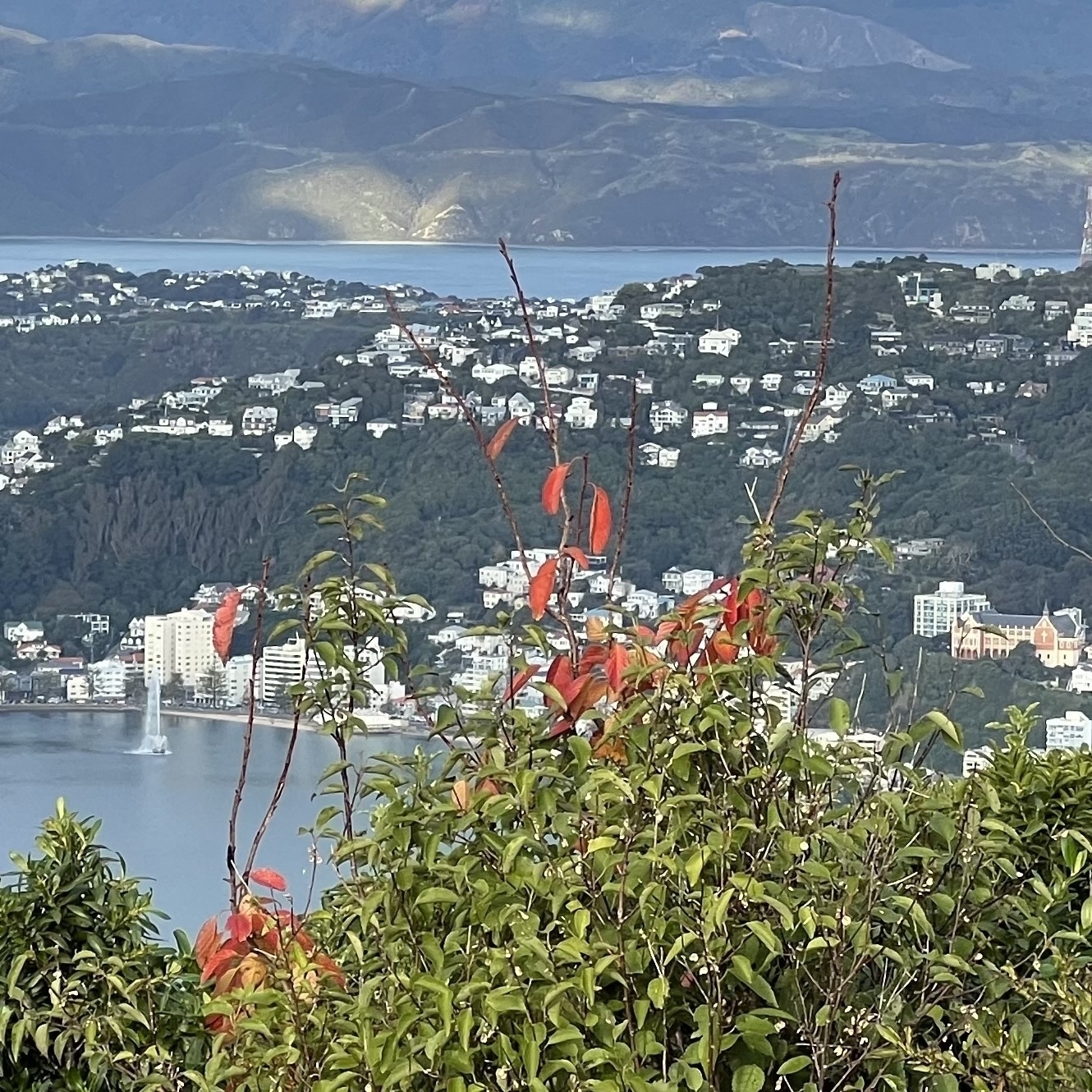
The rātā forests of South Westland are in full summmer plumage, a red band moving higher up the mountain as the weeks pass.
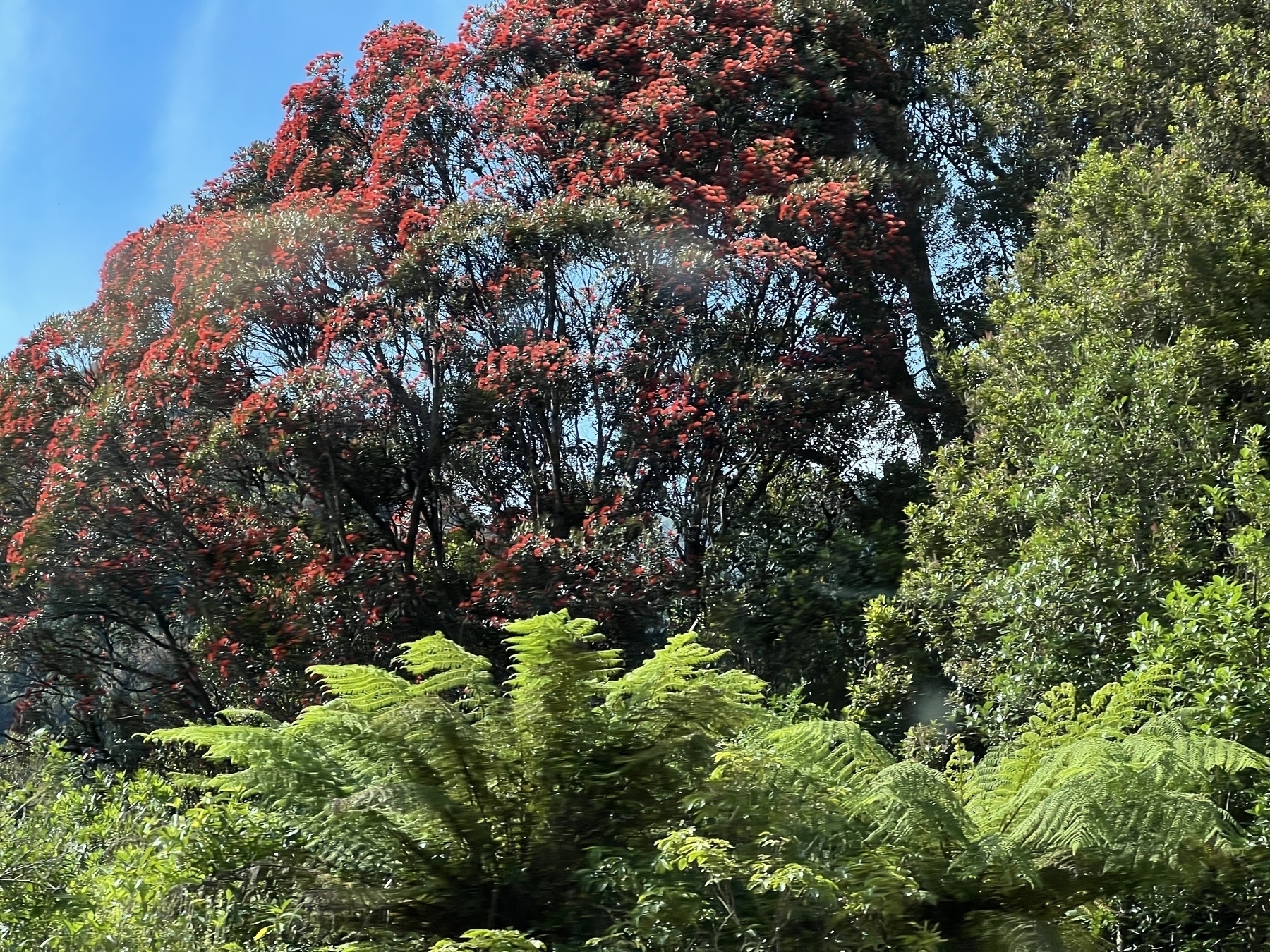

On today’s walk, eight eels and a new pūtangitangi (paradise duck) family…
Previously: tuna (an eel) in the same stream.
The blossoms haven’t been quite as profuse this year, but there’s still plenty of flowers and new leaves for the passing birds… like this kererū this morning:

Though it would probably be for the best if we cut out this cherry tree - the species is somewhat invasive here - it’s hard when in spring through to early December it provides such good forage for kererū and tūī.
I mean, just look at this happy face:
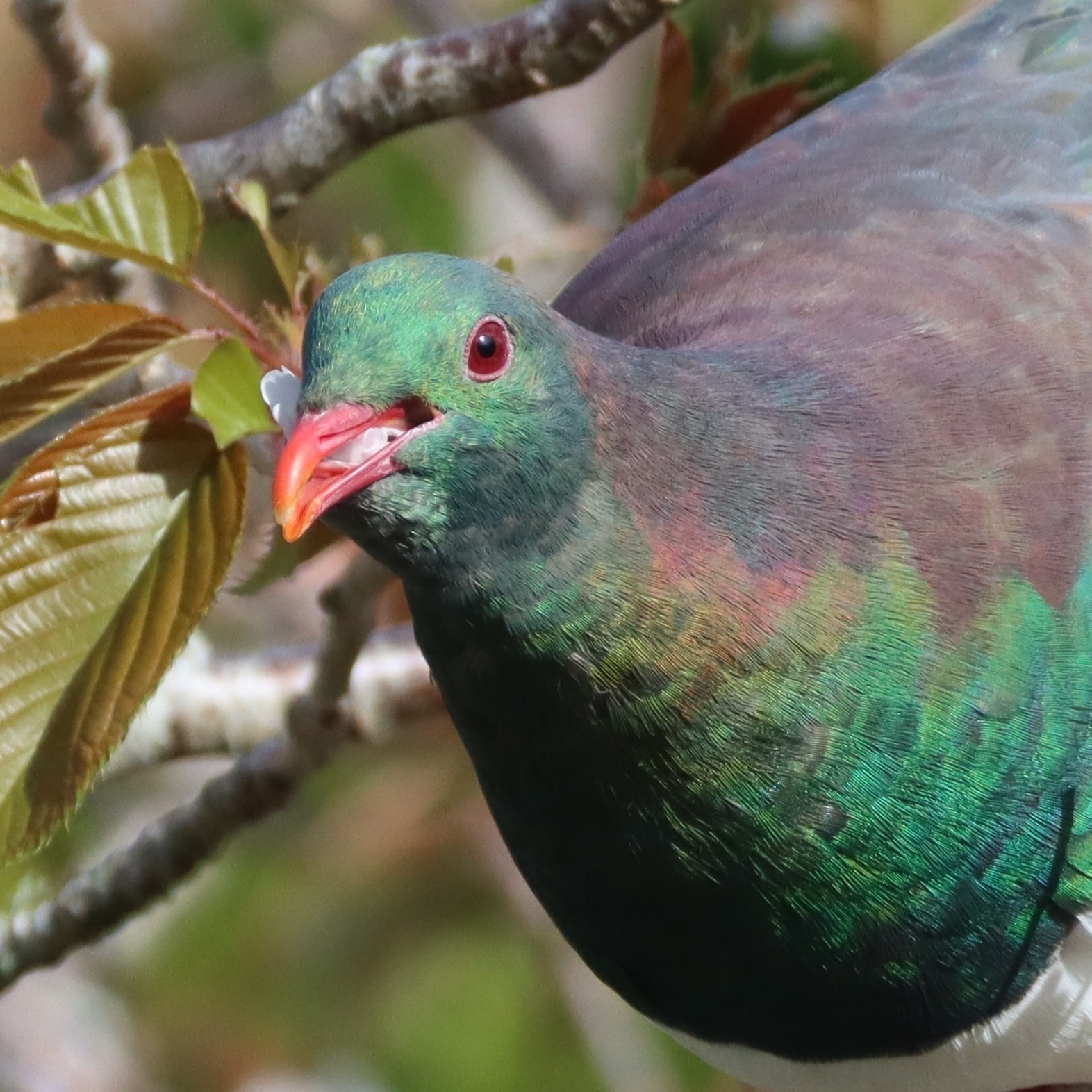
Previous springtimes:
More mid-winter sunshine, finally, so I thought I’d ride to the supermarket as if it were summer again… taking Highbury Fling through the bush of the Waimapihi Reserve across to the top of Brooklyn.
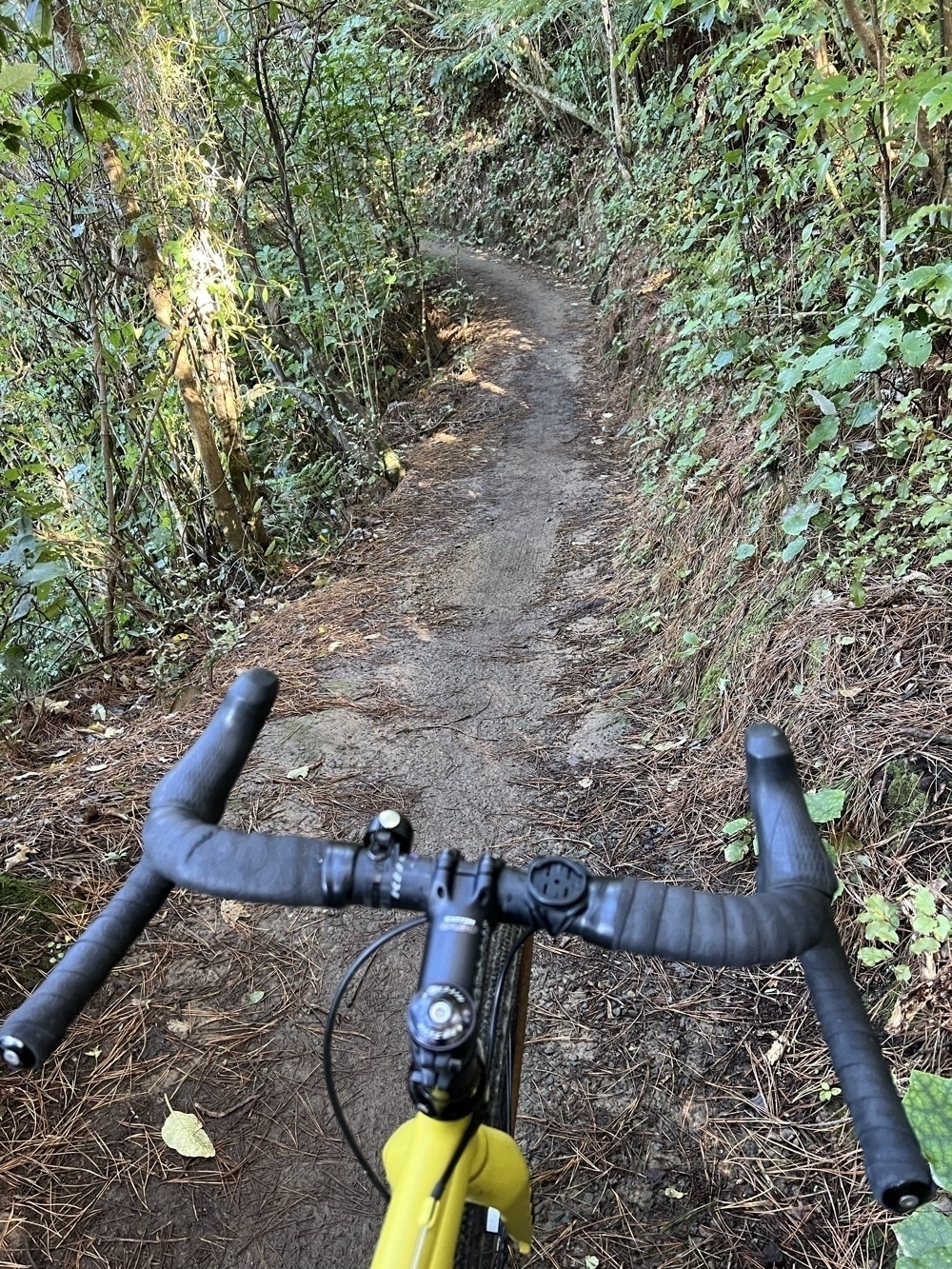
In summer the birds are a little more active and you can often hear or see tīeke (saddlebacks) and hihi (stitchbirds) spilling over from the predator-free sanctuary next door. There was little of that today though, just a few walkers picking their way along the muddy track (and none of them were singing).
Out the other side though I get to whiz down the streets of Brooklyn, taking in the views (but trying not to get too distracted)…
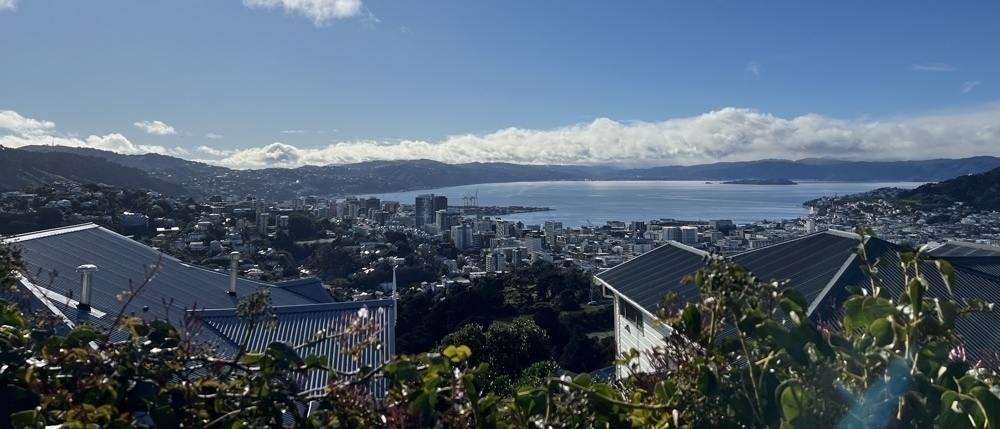
Definitely a good way to get the daily exercise in.
It’s spring again! And so our cherry tree in blossom is host to a now-traditional tussle between the tūī and all comers.
Today: ding ding! it’s a pair of Rosellas!

(Apologies for the quality of the photo - it was taken through our winter-crudded windows.)
The tūī chased the rosella about a bit but it didn’t really go all that well in the end as the pursuer became the pursued and was chased off in turn. And the rosella went back to snacking on the blossom.
Round One: rosella!
Previous springtimes:
iNaturalist tells me this is Zealaranea trinotata; back in February all I saw were the amazing yellow spots.

Springtime rolls around once more.
Today was a lovely calm day and I remembered that I have a decent macro lens now. So off I went around the house in search of subjects.
I got better than I expected in a patch of wild flowering bulbs up in a less tended part of the section. A little House Hopper spider was working its way from flower to flower:
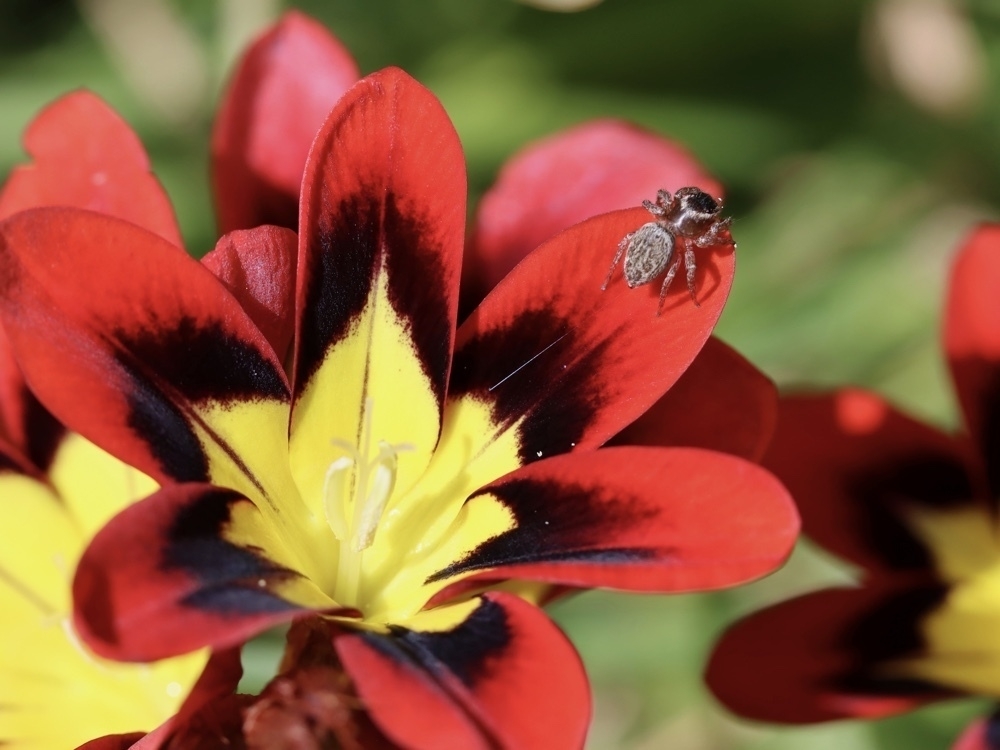
It’s not obvious in this crop but there is some really nice detail captured - and I really should get out there with my camera a bit more often.
Previous springtimes:
Not that weed.
Just a flower in the grass, after some spring rain.
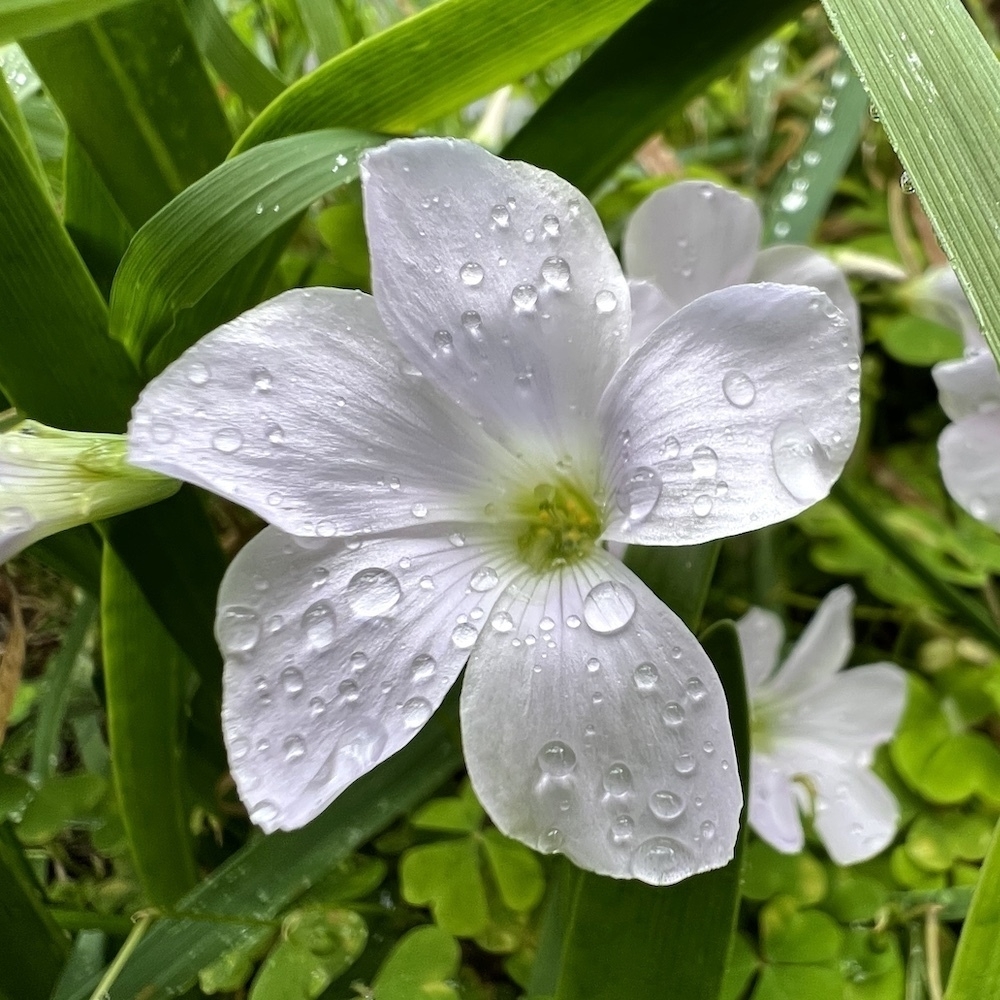
Previous springtimes:
Well, that was interesting, but something we would not want to repeat; here’s hoping.
Spring rolled around again, as it does, and well, what to do but yet another gratuitous photo?
Yesterday R₂ and I went for a walk around the neighbourhood; there were lots of kōwhai flowering and the inevitable tūī:
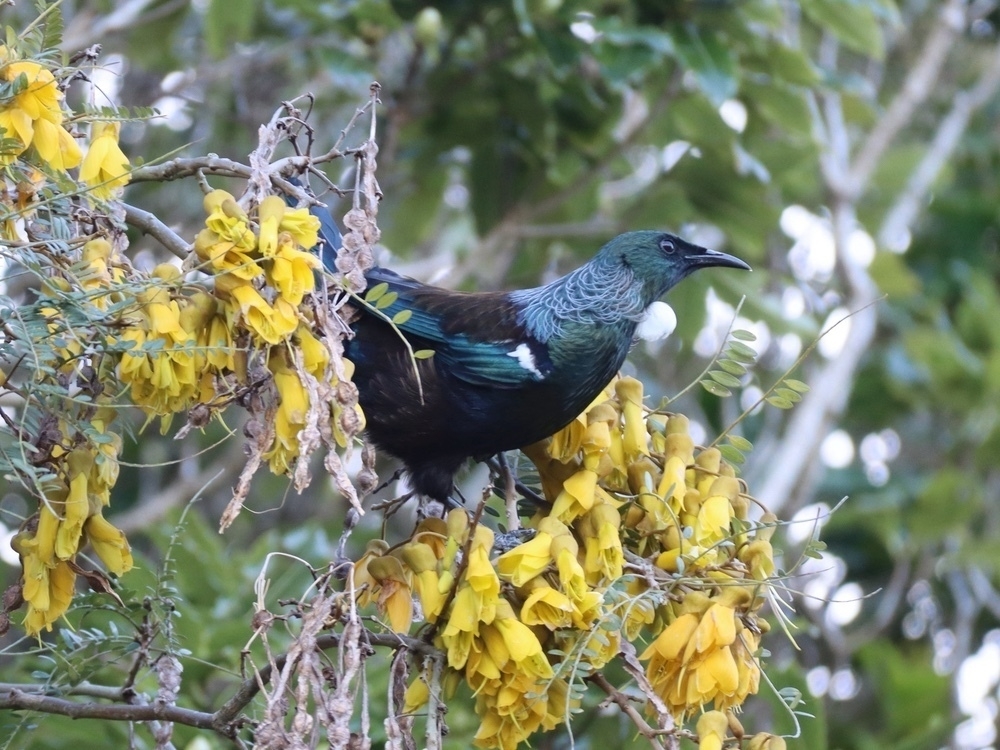
Then this morning: my usual Sunday breakfast of white clover honey smeared thickly on our home-baked toast and washed down with a Chemex full of finest filter.
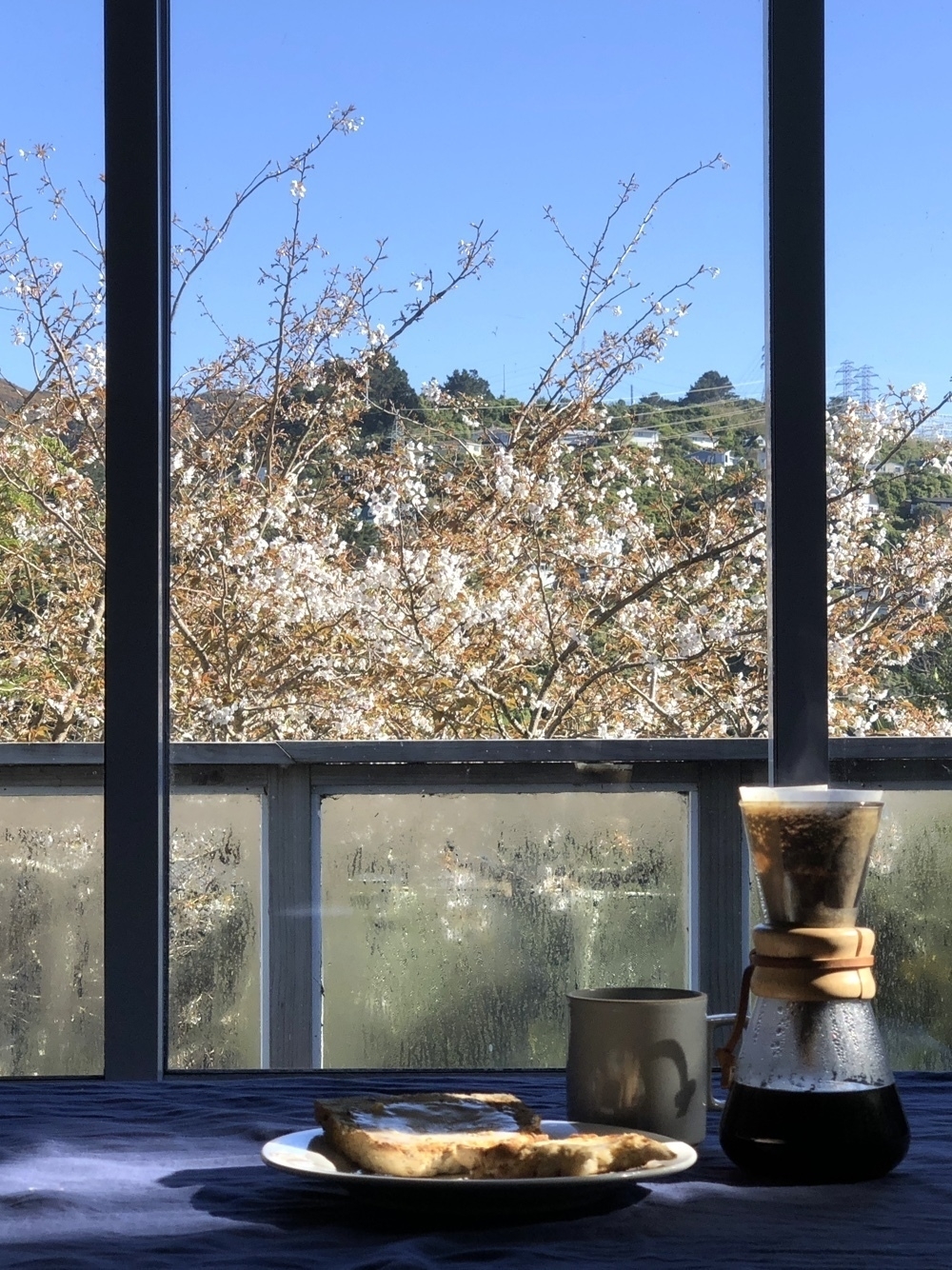
I am grateful to be here.
Previous springtimes:
A Yellow Admiral arrived out of nowhere and landed on the pavement beside me. Nature’s capacity encompasses large and small surprises and here was one to lighten pandemic gloom.
It was a beautiful morning.

Exactly a year to the day since my last spring posting here, I remembered I had a blog and snapped this fairly average picture of the cherry tree as I rushed out the door to work.
I think I need to try a wee bit harder next year.
Previous springtimes:
Once again, spring returns, and once again our cherry tree fills with the neighbour’s bees. On calm days the tree is full of a active hum (of bees) and a sweet scent (of blossom).
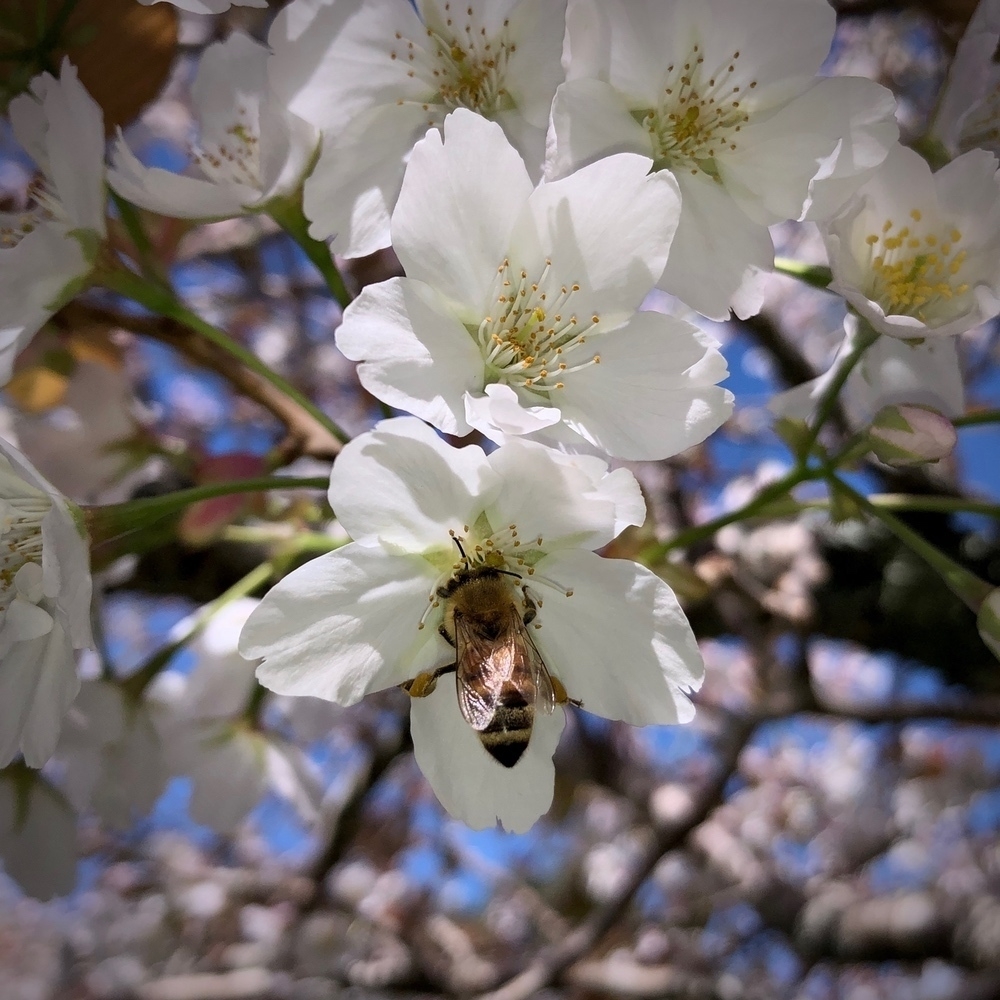
Occasionally, a kererū will drop by, quite tricky to spot sometimes in the sun-shaded side of the tree facing the house.
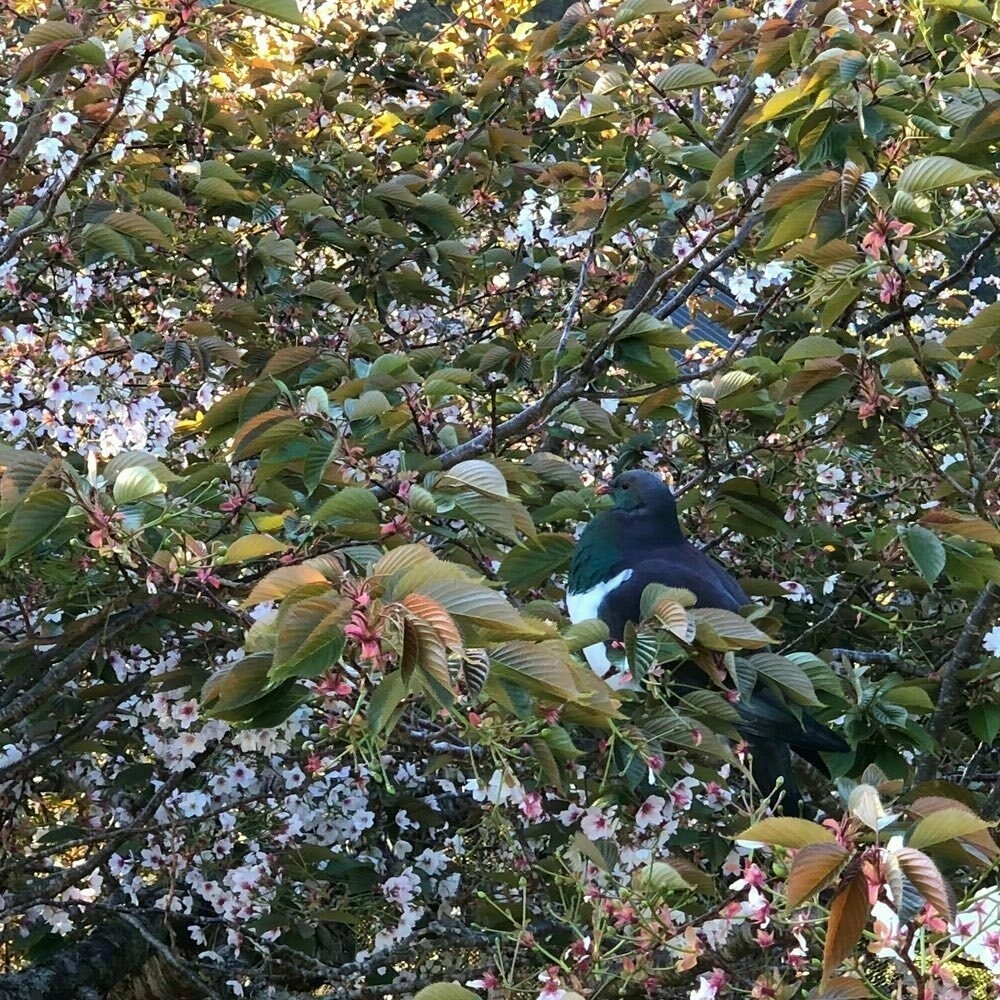
No doubt it will be back in November/December for the fruit.
Previous springtimes:
I was just about to ride to work in the morning when I noticed that:
Which meant that all the leaves and flowers had beautiful, soft, fat droplets all over them. I didn’t do a great job of capturing this with the iPhone (and how can I convey the delicate scent?) but at least there’s this.
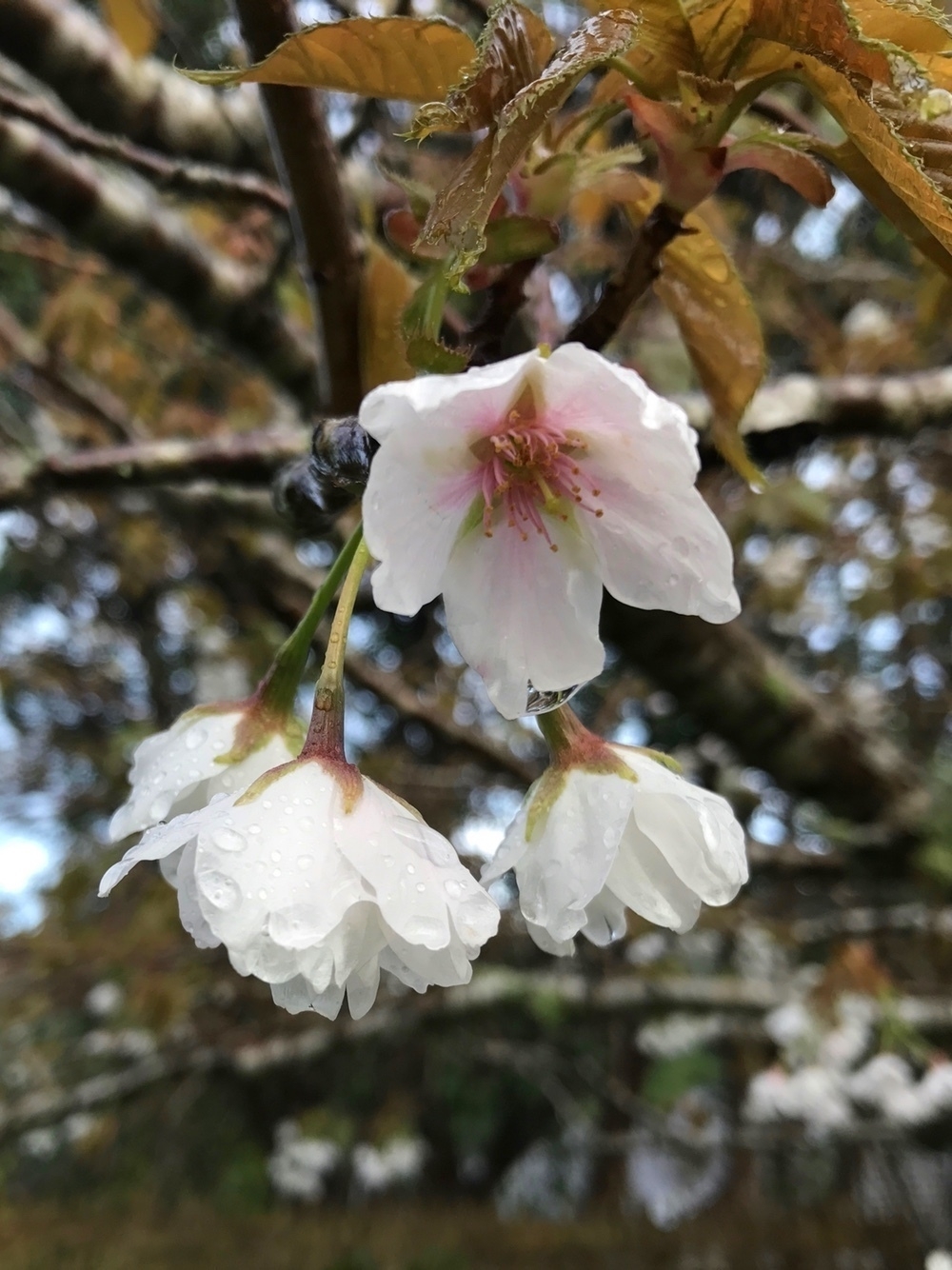
And while we’re thinking of Spring Rain, I need to leave you with this gorgeous Aussie song:
Previous springtimes:
I nearly forgot to do my annual spring thing. And once I remembered, I was in a bit of a rush to get a picture - here the blossom is spectacular against the dark but also unfocussed.
Must. Try. Better.
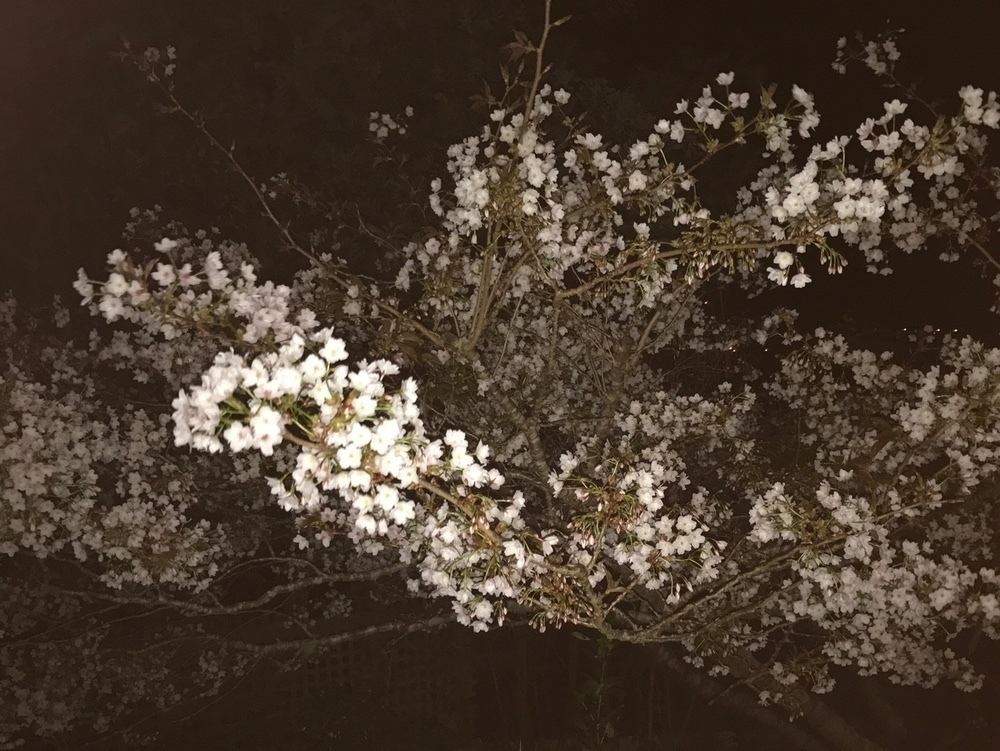
Previous springtimes:
It feels like spring comes around more quickly each year now. Even so, this visitor is perhaps a little early in the season:
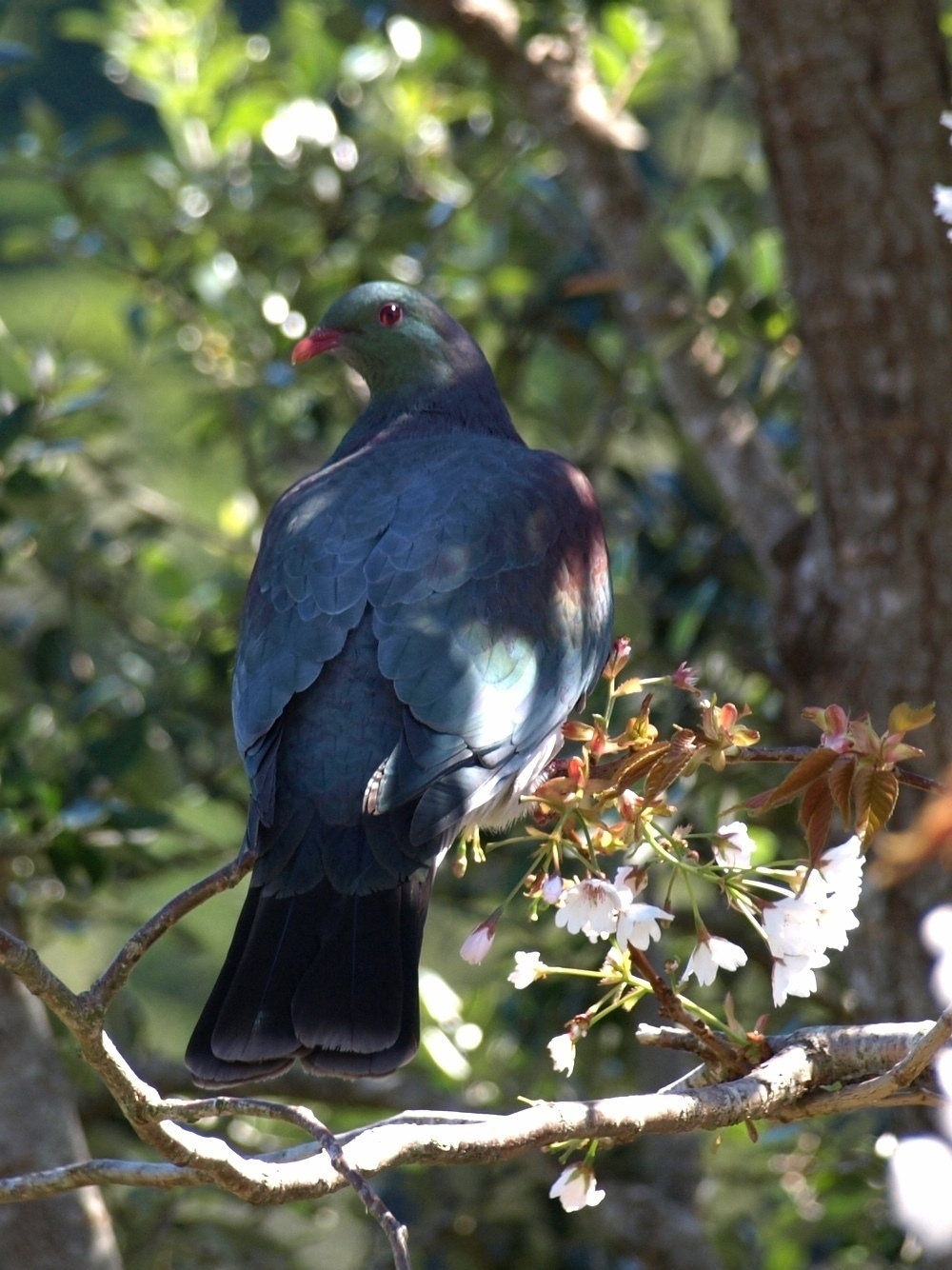
But hey, we’re happy to see you; always.
Previous springtimes:
Well, it turns out this is the fifteenth spring we’ve had in this house. Sometimes I get the feeling people look at us a bit strangely for staying so long in the same, modest little house.
But it’s all we need. I’m not keen on the idea of martyring personal and financial comfort to purchase a monstrous and ugly new place on the city’s fringe (and neither is R., for that matter) and nicer places closer by seem overpriced. So here we stay.
Anyway, spring is upon us, and so our cherry tree. I’ve been a little busy with the new toy to take much notice - this toy:

I did finally snap a couple quick shots of the blossom today - just with the iPhone, which gets more capable with each iteration.

It’s such a nice time of year, before the endless rolling weather fronts of the equinoctials get stuck in until Christmas…
Previous springtimes:
This year it’s been all upheaval around the house as we had to rebuild the deck, and at the same time, put in some nice double-glazed windows and a new burner to make future winters better.
So at the moment, instead of a clear view of our beloved (but increasingly out-of-control) cherry tree we have a large pile of building debris.
None of this stops the blossom though.
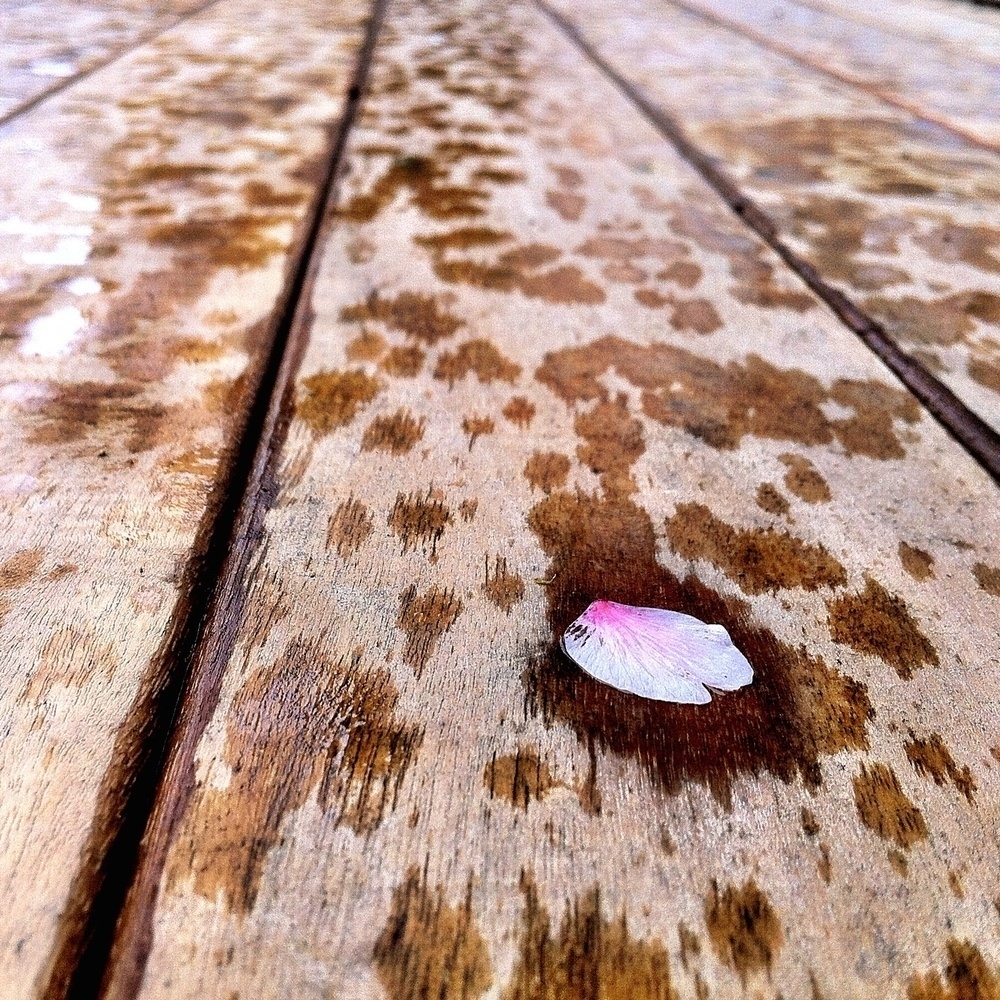
Previous springtimes:
I’m always a bit of a sucker for colourful animals of various kinds. It’s a failing. But not an uncommon human one.
Hacking away at our Bay tree the other day I came across two I hadn’t seen before: both visually quite colourful (as opposed to merely behaviourally colourful, like say a jumping spider).
The first was a tiny false scorpion: even smaller than the 5mm long and usually dark brown ones that I sometimes catch in our bathroom, this one was green with red pedipalps (their nippers). It had fallen onto my shirt and from there I was able to put it onto the deck railing for a shot or two:
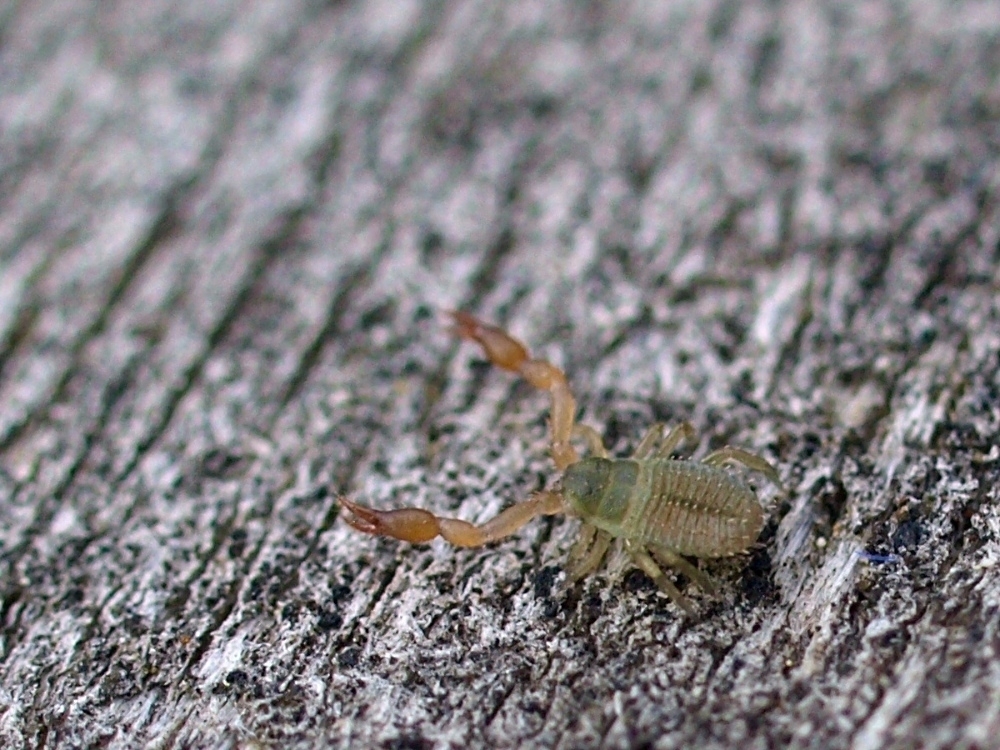
Luckily it was so extremely slow moving. At about 3mm long it was at the limits of what I could capture with my current setup.
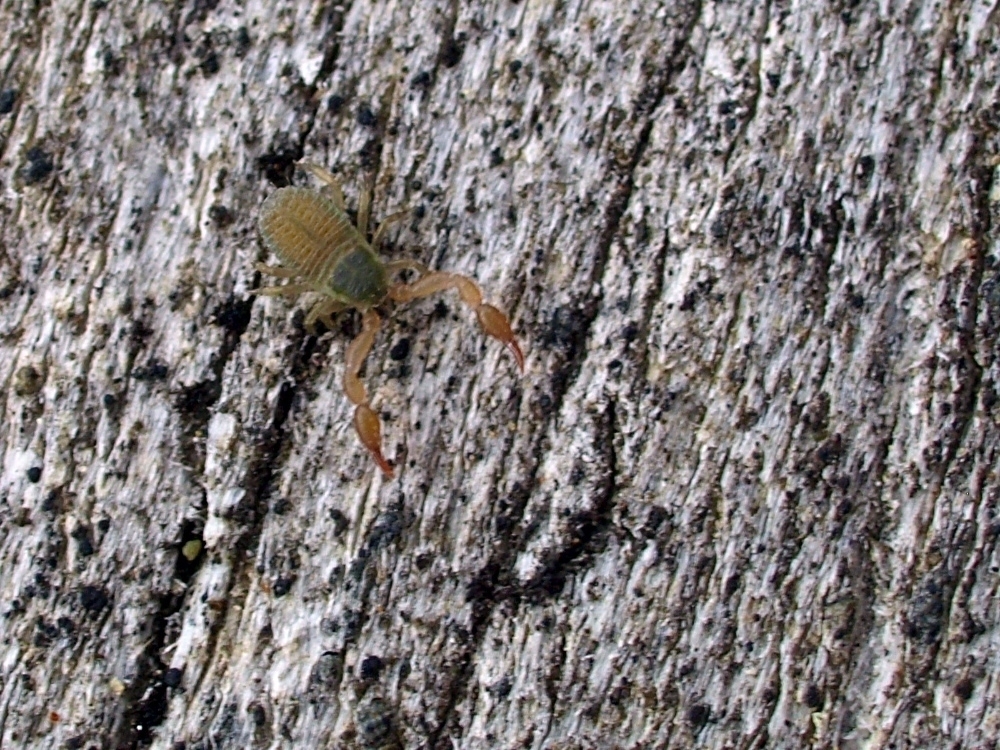
I suppose the colours would be good camouflage for an arboreal hunter. Apparently they wander about probing with their pedipalps for prey; and when they find it seize it and poison it before ripping it to bits and feeding themselves. Charming.
Not long afterwards I spotted a really quite pretty green spider running around on a branch. It proved hard to catch but I managed to get it into a plastic container and into the fridge overnight in the hope of slowing it down sufficiently for photography. (I have heard this is a common cheat amongst photographers of small beasts.)
The next day I spent five minutes trying to photograph it before it inevitably escaped:

As you can see, this spider too, is very small, its body probably no more than 5mm long. According to Forster & Forster, the main reference book I use when checking out what spider I’ve caught, this would appear to be a spider of the Paradictyna genus, “undoubtably one of our most handsome spiders”1.
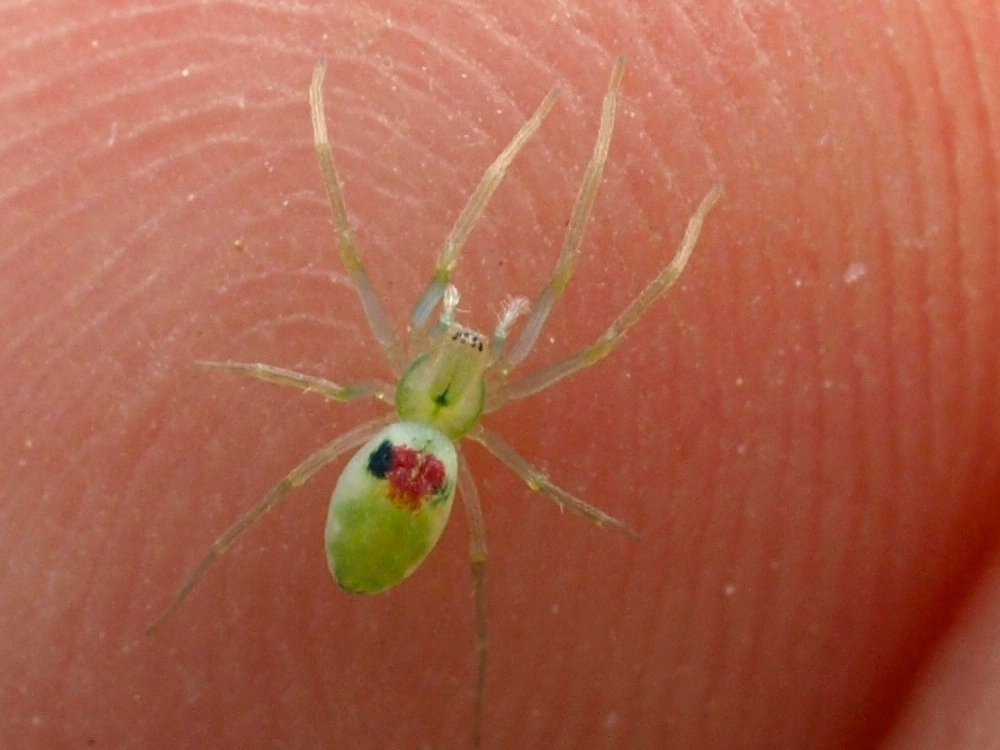
Why yes, it is very handsome.
But also very sadly delicate, as I found out when it escaped from my hand and fell onto the sun-warmed barbecue, instantly dying.
I am not to be trusted with animals, it seems.
1 While looking for more information on these spiders I came across David Winter’s post on them, and from there, Ray Forster’s obituary. Forster was a guy so dedicated to his science that when he was stationed in the tropics in WW2 he built a still, not to to get boozed, but to have alcohol for preserving all the specimens he was catching!
The forecast did not prepare us for this morning. We had expected showers and grey… but what eventuated, at least for some of the day, was far nicer.
The unexpected sunshine, and unexpected lack of wind made for a warm, humid atmosphere. Breakfast on the deck for me then, overlooking the cherry tree in full blossom.
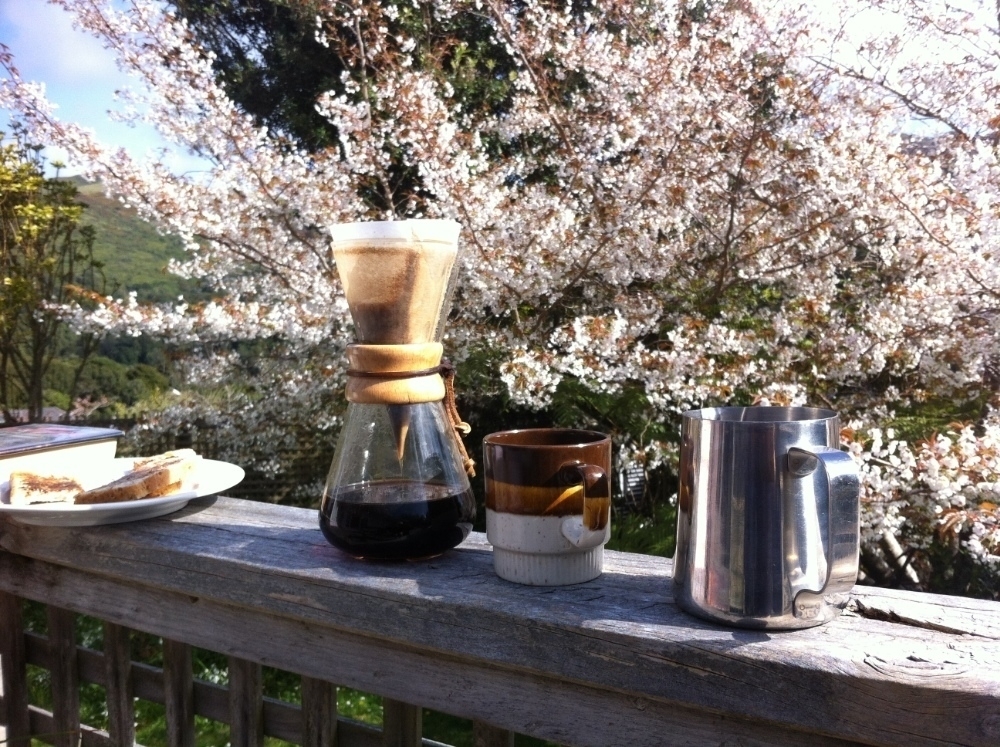
The only sounds were those of the birds (several tui flouncing about the trees, and high above, a falcon) and the bees (the neighbour’s hive is just over the fence and their bees were out in force, loving the blossom).
Until someone’s chainsaw started up. I’m not sure what it is about some people and their compulsive need to use their chainsaws on a Sunday morning.
Oh well. I didn’t let it destroy the mood. In fact I was so relaxed I forgot I was still in my pyjamas when our nice neighbour delivered our paper.
At the time, I was lurking on the lawn taking more photos. I had spotted a Red Admiral among the blossoms:
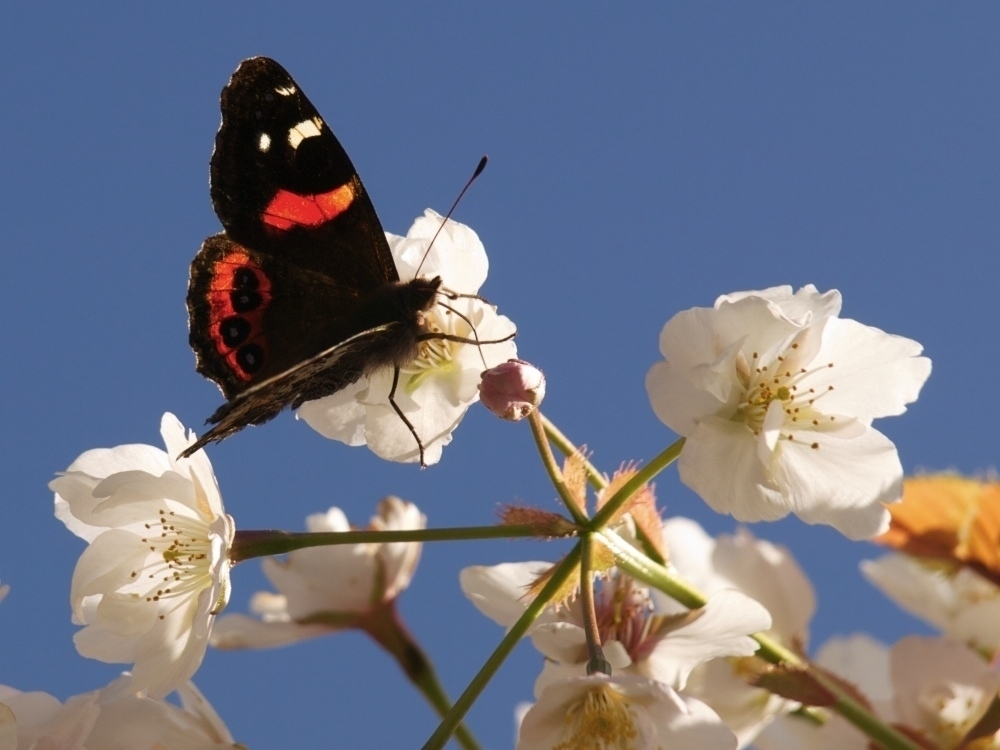
There are a few of them about all through the winter, even on the hilltops I ride.

You have to be quick to catch them with their wings spread - they’re open only for a couple seconds after the butterfly lands on a new flower. After that, they often close up their wings and show only the wings' dull grey camouflaged undersides.
Later, the weather held and we had a little family group photoshoot among the blossoms (easier now, while the kids are yet young enough that their reluctance at such things has not hardened into the inevitable refusal).
Soon afterwards though, the clouds closed in, and with them came the rain. Typical spring day!
Previous springtimes:
This awful weather we’re having. Well, it’s winter I suppose… but it makes me want to look back at this summer past.
And I remember now that I posted nothing here over that period. Clearly time to do something about that then. Lots of photos to follow…
Summer started (or rather, late spring continued) with the local kererū pigging out, as per usual, in our cherry tree:
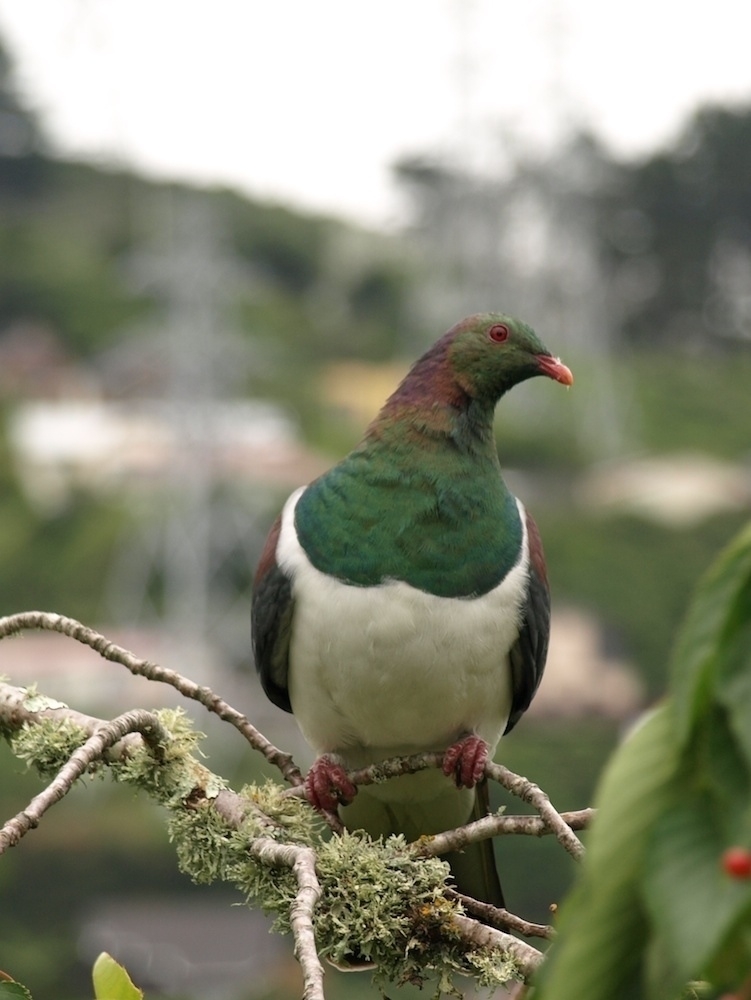
It’s quite nice to be able to provide them with a little food, if only for this short period of each year. But they seem to do OK around Wellington the rest of the time, foraging everyones' gardens.
We headed away to the Deep South in the days before Christmas. The waters of the Strait were almost eerily calm; fog, no wind; all of which was pretty unusual in crossings that I’ve experienced:
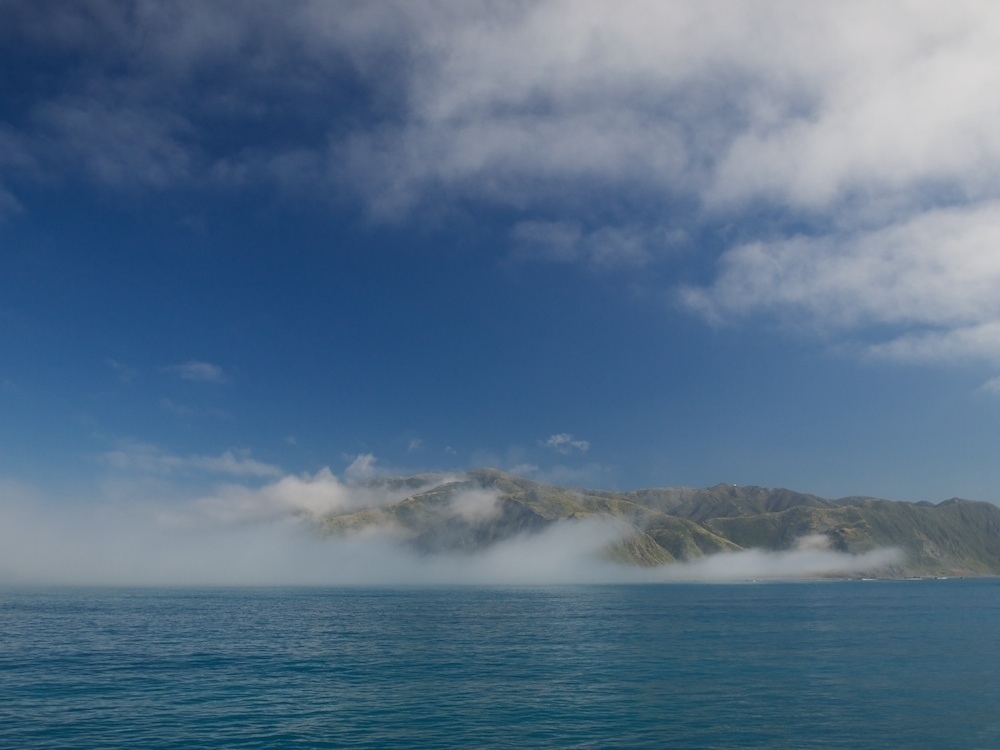
Further south, once on the Mainland, the Southern Rātā was in bloom. There’s always a picturesque clump or two above the sea in the windy bits of road just before Haast:
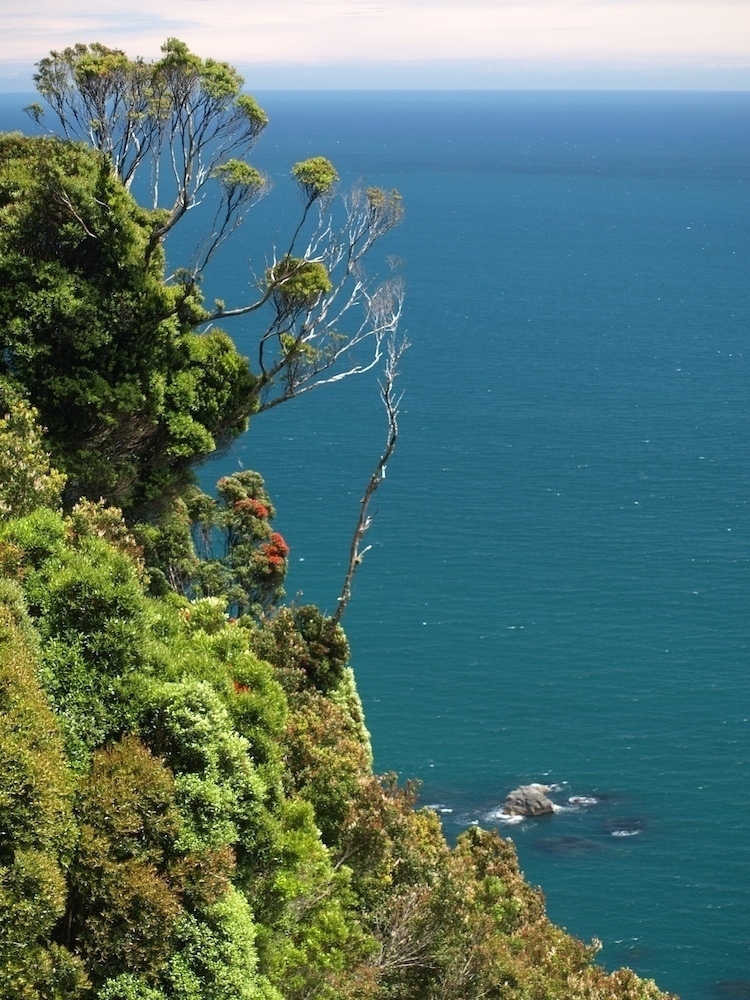
Of course, there are lots of large and more impressive older rātā trees around there and also up the Landsborough River, but somehow we always seem to stop at this particular spot above the sea.
Another place we like to stop after our previous experience there is the Blue Pools along the Makarora Valley. We were not disappointed. Although there were fewer of the little Riflemen that we spotted there last time, we were very pleased to see a noisy family trio of these:
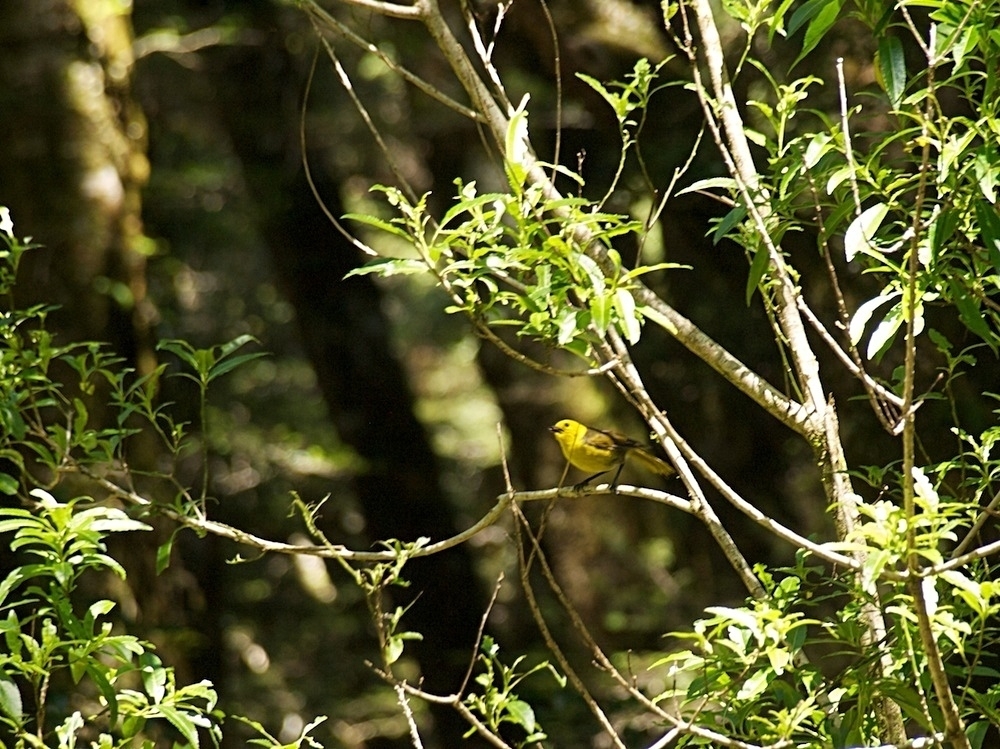
This is a Yellowhead, or Mohua, and is very rare these days for the heartbreaking reason that it can only exist in native forest fertile enough for it to be able to reproduce fast enough to keep ahead of rat and stoat predation. I suspect the drops of 1080 in the Makarora in the last few years have greatly benefitted these guys and any other remaining native birds in the area. But what would I know.
What I do know is that the New Zealand bush is pretty disappointing for the average, noisy clomping tourist family. Most of the people who were walking the little trail we were on didn’t really see anything. You have to stop, listen carefully, and wait for the flickers of movement that tell you that several little somethings are coming your way. Our surviving endemic bird fauna are, for the most part, just not that obvious.
Once down on the farm the weather turned very hot and dry. This was apparently quite a contrast to up north, where it was wet in most places over the Christmas statutory holidays.
You’ll be pleased to know that there was at least one overcast day with a few spits of rain. This was the day that my Dad collected us all up into his farm truck and drove us across to a farm dam inhabited by a Pied Stilt and three little roadrunners:
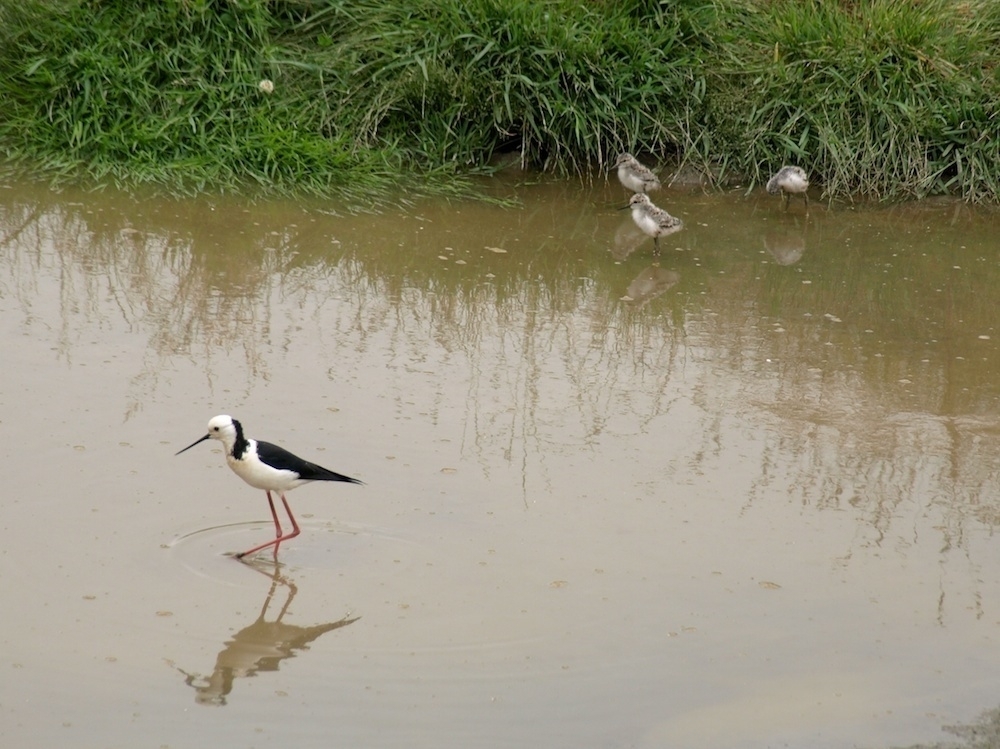
While we watched this little family the other adult was flying around and around, quite close and making quite a bit of noise, and so we thought we’d better move off before we disturbed the pair too much. It would not do to have the chicks abandoned.
Naturally we had our bikes with us, and sometimes I’d ride to town to get a coffee (about a 30km round trip on fairly quiet roads):

These guys actually make quite good coffee that would stand up in any of the major cities. They’re best known for their pies, cakes and pastries and I very much like stopping there.
On the way back there are a couple of spots waiting for a camera (especially on this particular day, which was extremely hot and requiring of several stops):
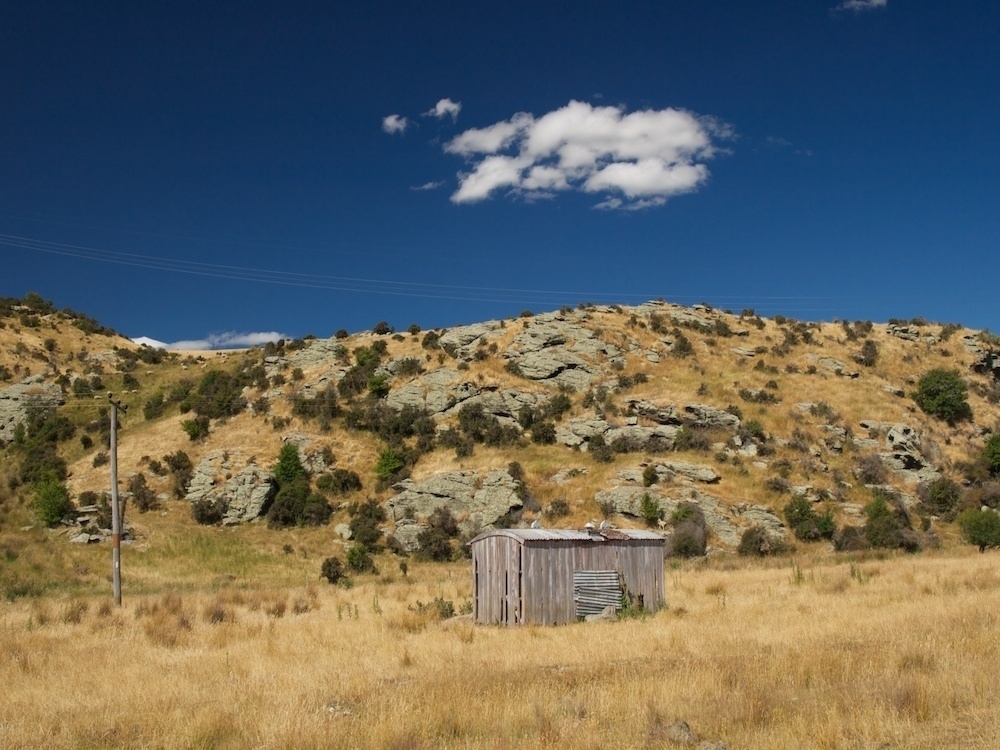
This is an old railway carriage, left behind in the late 1960s as the tide of railway track that brought it here receded back to Dunedin.
I do like my polarising filter overmuch, don’t I:
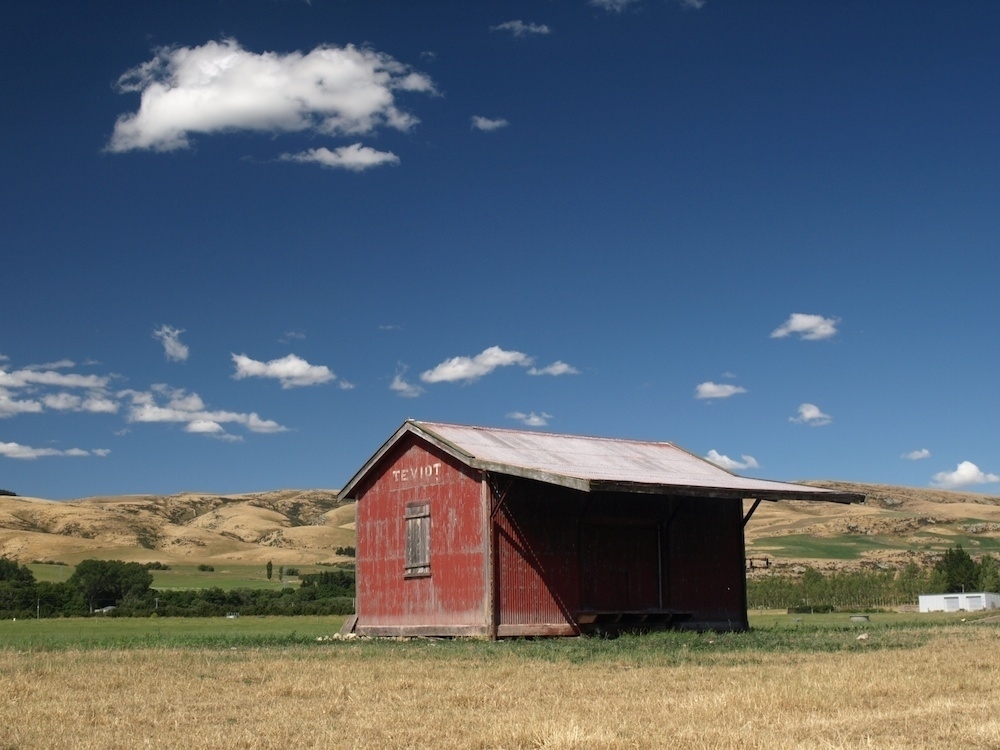
A bit further down the road, this shed is similar to that more famous one at Wedderburn on the Otago Central Rail Trail. What not many people know is that the original shed at Wedderburn was sold some years ago… and the shed that’s now at Wedderburn is a ring-in that the locals there purchased and took from the next station down the track on this line. There’s no such thing as genuine: how would you define it?
There’s always time for a couple days at the family crib at Lake Hāwea. I got out on the bike for a couple rides down the river trail and across Hāwea Flat, where I saw this striking, but I suppose not uncommon, sight:
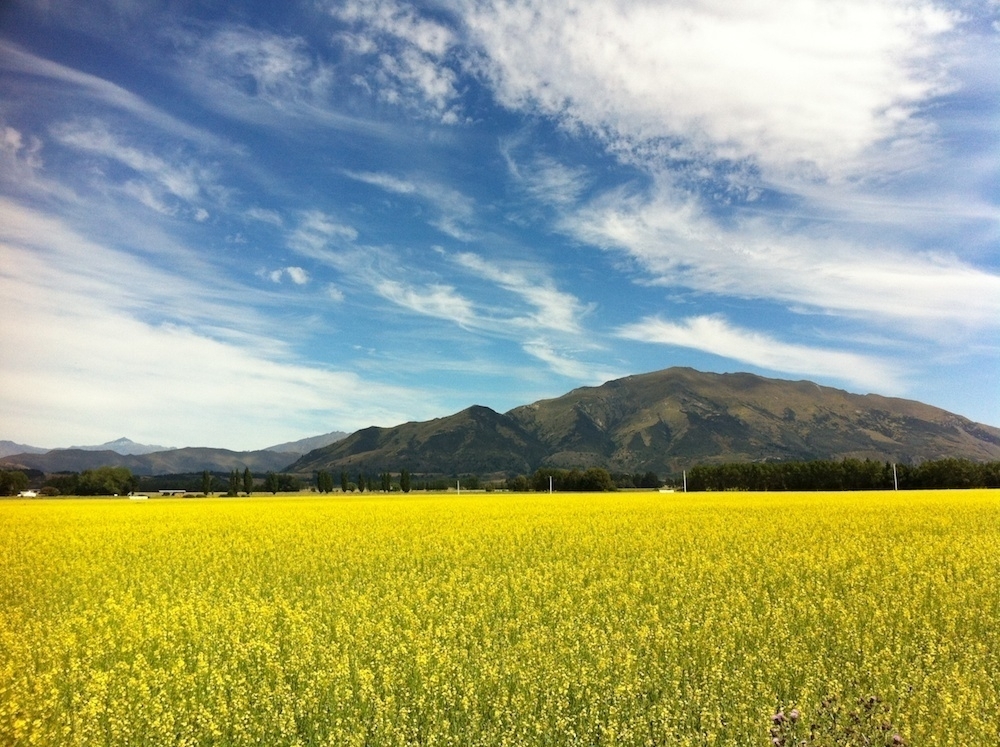
It’s a field of rapeseed, or what the Canadians rebranded Canola, presumably grown as winter feed for stock. That’s Mt Maude in the background, and a very nice walk to the top can be had if you are fittish (it’s about 900m above the plain). The other nice thing about this photo is the sky - the Upper Clutha Basin on hot days has the most beautiful skies.
The sky is the best feature in this photo too:

We’re down by Lake Hāwea, but instead of looking north for the conventional lake view this is back up the terminal moraine, past a dead tree I could probably have done more with. But those swirls of cloud!
And back at the crib, the small:
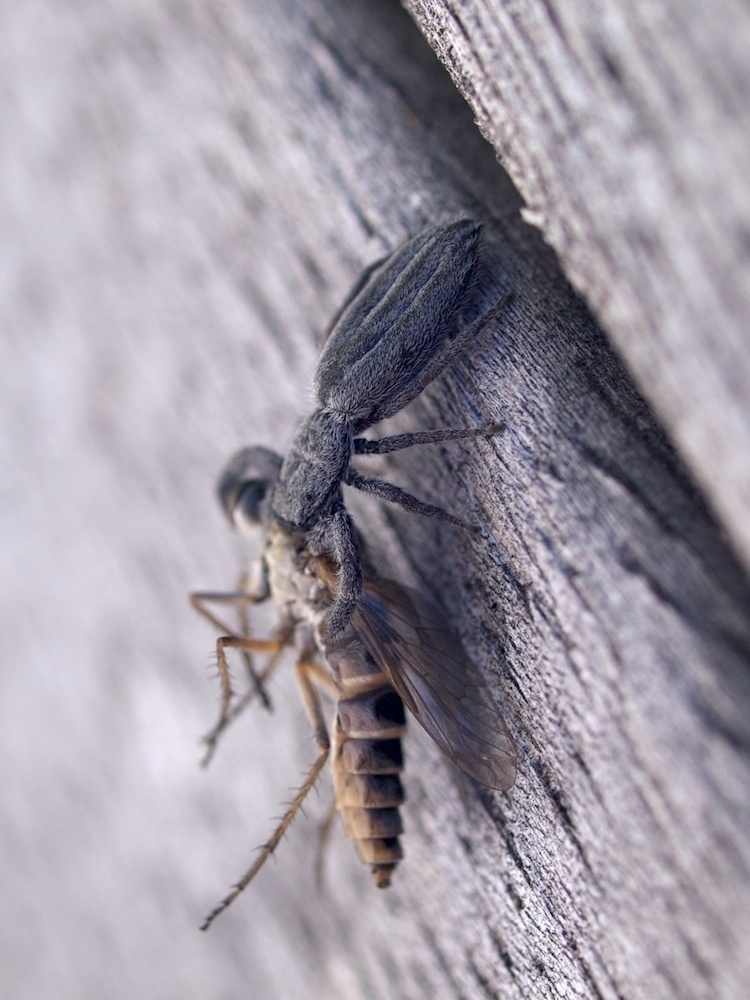
I was pretty impressed with this Holoplatys jumping spider catching such big prey. It wasn’t quite able to drag it back into the narrow gap between the boards, and so it stayed in a helpful-for-shooting spot for a some time. Despite this helpfulness, I still mucked up the depth of field on all of my photos of it.
Back on the farm we decided on a trip to somewhere we’d never been before: Oamaru. On the way, we stopped at the Moeraki Boulders:
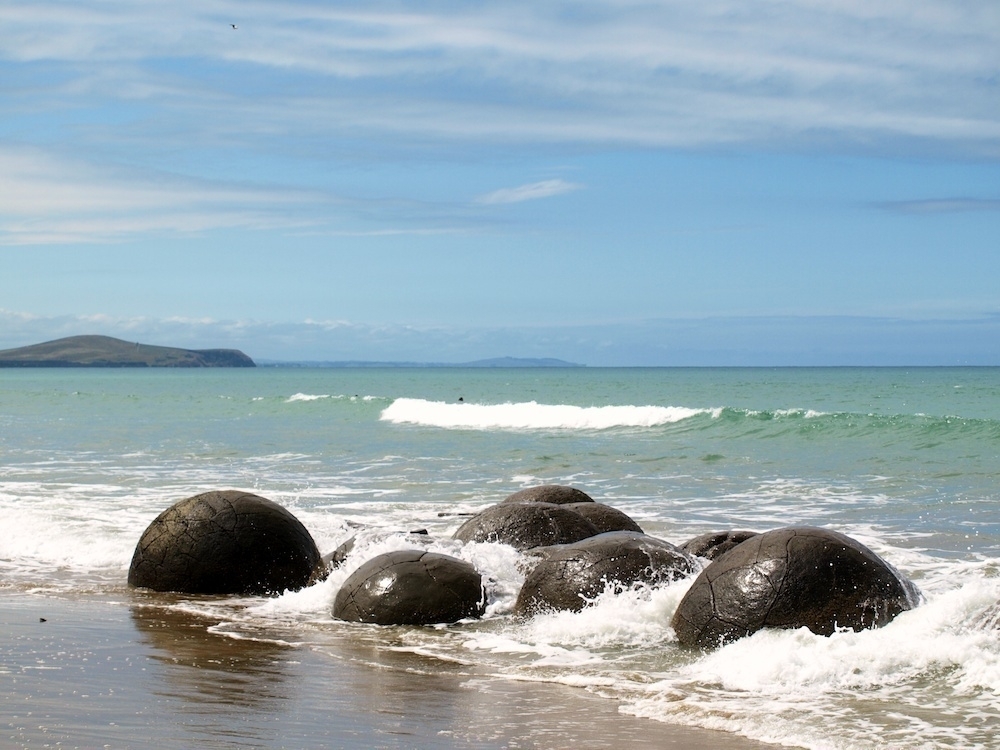
While the Boulders were pretty cool, the better thing for us was spotting a pod of Hector’s Dolphins working their way along the surf. There’s actually two in the above shot.
I got a bit over excited and tried repeatedly to capture a decent shot of the little dolphins. Sadly, this was the best I could manage:

At some point in the future we should go for a visit to Porpoise Bay in the Catlins, where there is a pod of Hector’s Dolphins almost always in residence. Some years ago when R. and I were passing by there on our way to Curio Bay nearby we watched them play in the surf with the kids from the local camping ground. After hearing this story both B₂ and R₂ liked the idea of the chance to do the same.
Oamaru is known by visitors for two things, mainly: its beautiful Victorian architecture, and its penguins. We had a pretty good look around the former, and in the evening went to a clifftop outside town where we could spy upon the latter–specifically the larger of the two local species, the Yellow-eyed Penguin:
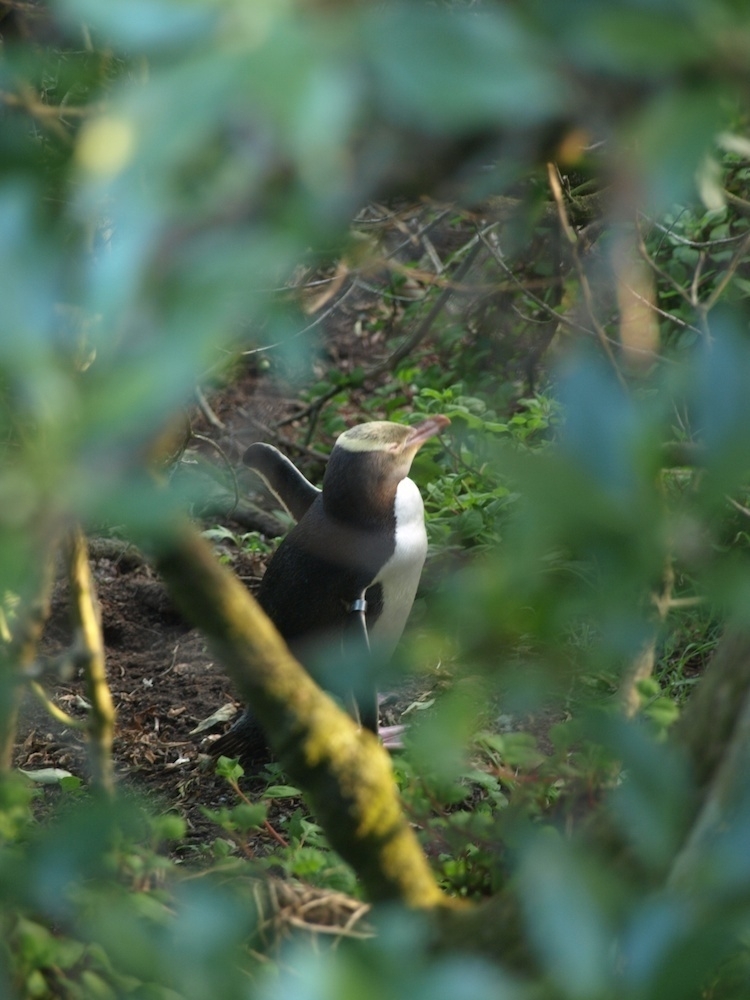
They were surprisingly noisy, the nesting bird calling to its mate (who sometimes we could even see, waddling out of the water and across the beach far below, past the seals and into the scrub at the beach edge).
The next day we drove back through the Waitaki Valley, following the Vanished World trail to Duntroon. Thoroughly recommended: fossils, strange limestone country, Māori rock art, and at the end quite a nice visitors' centre where the girls found some fossils of their very own in the blocks of limestone provided. Then we drove over the Dansey’s Pass to Naseby and the Maniototo and onwards back to the farm.
Not long after that we had to come home to Wellington. From then on for us summer was mainly Wellington; school; work; slowly drawing in days. Though this year was also a festival year we didn’t get out to much except one or two of the free events, like Arcane:
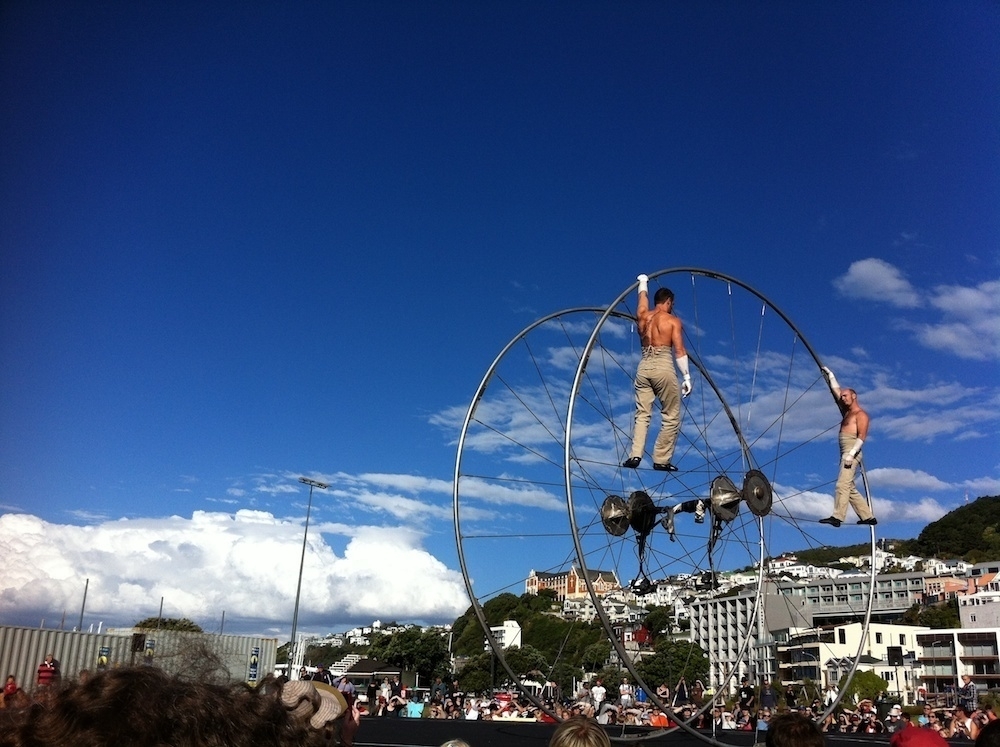
So there you have it: in one blog posting what I would have taken ten to do in earlier years. And I can barely wait for the warm dry weather to return. Roll on summer.
The weather has suddenly gone all settled and warm. This is perhaps not unusual for autumn, but given the crap summer most parts of the country have had for the past few months this is somewhat unexpected. In fact the forecast for Easter was so dire that it played a reasonable part in us deciding to hunker down at home.
Anyway, yesterday being another in this run of fine, fine days, I thought we should all trek into the Karori Wildlife Sanctuary, or Zealandia as it is now called. This, for those unfamiliar with it, is a large area of wooded valley not far from the centre of Wellington that has been enclosed by a rat/cat/possum/stoat-proof fence, with lots of fairly rare native species “liberated” inside. We’re members, but we never remember to visit often enough.
This time, I really wanted to get further up the valley into some areas I had not been to before, and also to see if I could spot and take photos of the resident falcons (Kārearea).
The first of these objectives was reached, but not the second. Lots of good exercise, and many not so good photos were taken…
The first animals we saw were the beautiful green geckos sunning themselves in their terrariums:

These are pretty hard to find, being so cryptic. Even in their terrarium it can sometimes take a bit of effort to spot them, such is their camouflage.
We’ve seen one in the wild once, while we were on a bush walk in the hills west of Napier some years ago. It was lying on the path, presumably close to death or it would have scuttled away. Another time, I found one of their more common cousins in a high-rise in the centre of town, which was a pretty peculiar occurrence… but that’s another story.
I find the texture of their scales very pretty indeed:
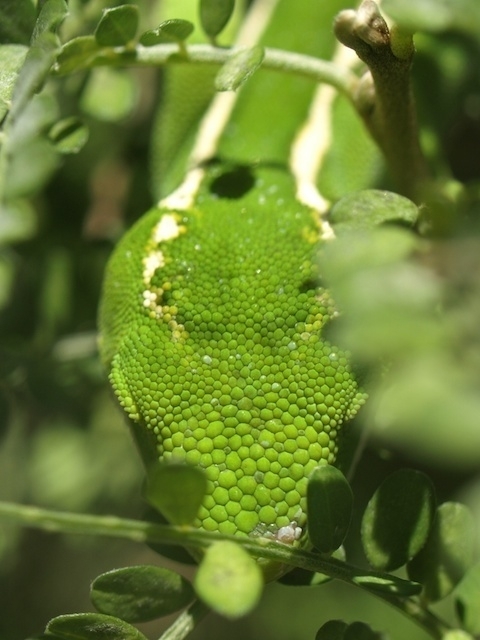
Sadly, these are not animals that can co-exist with rats, so we are unlikely to find any of these around our house, prime habitat though it is.
We were pretty keen to stay out of the way of the mass of people trundling along the flat, stroller-friendly valley floor. There are lots of tracks that twist up and through the pines and regenerating bush.
Up there, it’s clearly autumn:
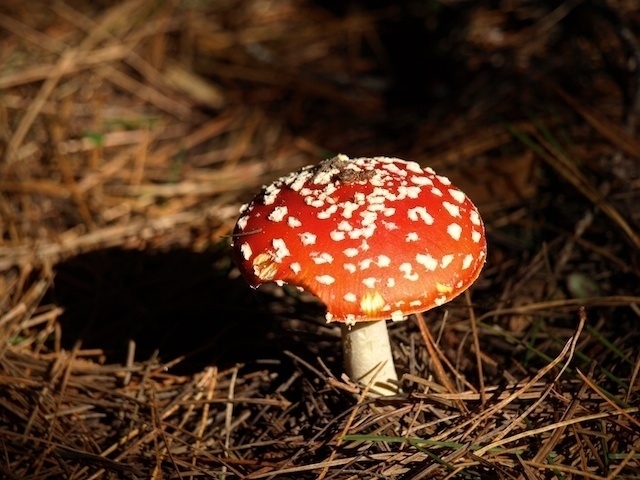
The dry, brown pine-needles also provide quite a nice contrast to the Hound’s Tongue fern that were everywhere under the pines:
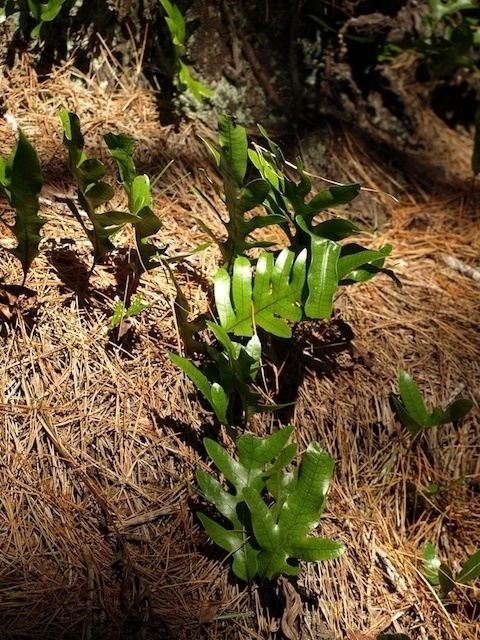
Then we heard a new (to us) birdcall. After a bit of careful observation R. found a pair of Stitchbirds (Hihi) in a bush full of berries beside a track further up the hill… but just as we were bringing the cameras to bear a pair of Tui (Tūī) arrived on the scene and chased them off. Tui are pretty aggressive and like to lord it over the local Stitchbirds and Bellbirds (Korimako), to the point where special supplementary feeders have had to be constructed that the larger Tui can’t get into.
That was the last we saw of the Stitchbirds. But there was still plenty to see and hear: particularly, noisy little flocks of Whiteheads (Pōpokotea), a few Waxeyes (Tauhou), the occasional Grey Warbler (Riroriro), and the omnipresent Tuis - the latter three species we have around our house every day. (The Tui only since the Sanctuary was founded - they’ve gotten enough numbers now to spread right out across the city whereas before they were rare here.)
One rare bird we did see a lot of was the North Island Robin (Toutouwai), particularly further up the valley past the top lake. Like their cousins, the Tomtits–who we saw on a very similar autumn day three years ago–the robins tend to be a bit territorial and will stand their ground, often advancing quite close.
It certainly makes them easier to photo:
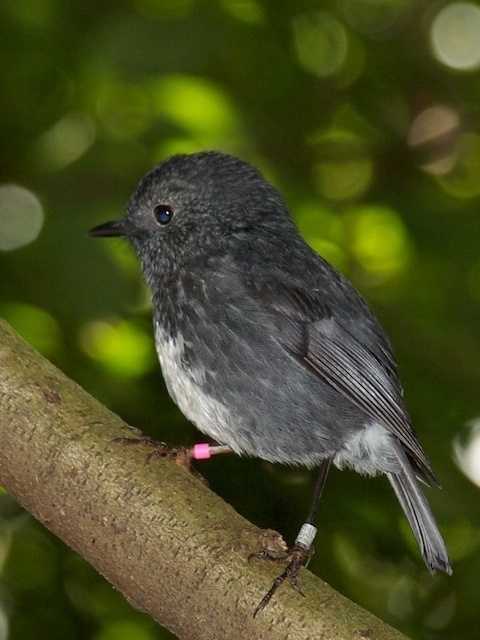
That one was banded - the numbers on the metal ID are fairly readable.
And judging by the angle on this photo you can see how close the robins get. This bird was almost under my feet.

I shouldn’t call these wee birds cute. But I will. They’re cute.
The other rare bird we saw a lot of was the Saddleback (Tieke). This was a slightly amusing point, as we were passed at one stage by a chap whose fondest wish was to spot one. There was one here just a minute ago, we told him, but he steamed on. Of course, once he was gone, the saddleback returned.
Sadly, they seemed to hang out in the most shady spots and our photos aren’t that fantastic.
We have a blurry saddleback:
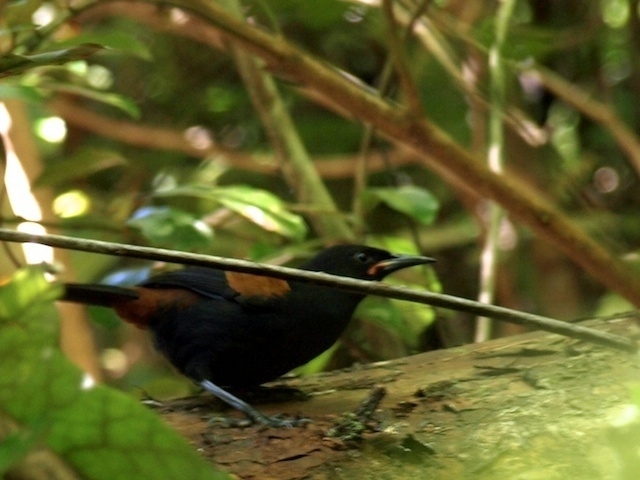
One on a twig:
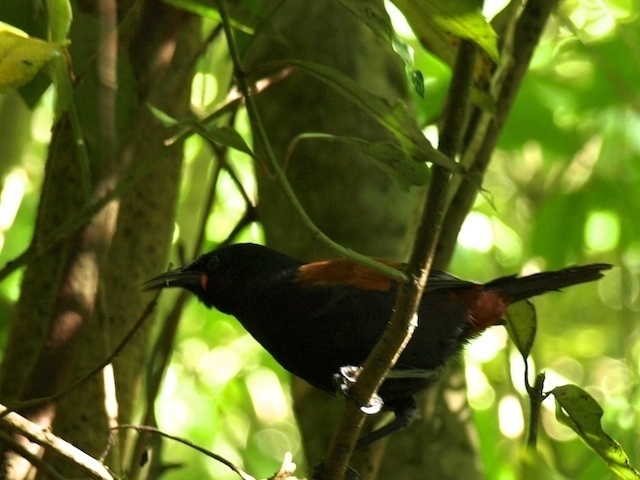
The same one - but check out those wattles!
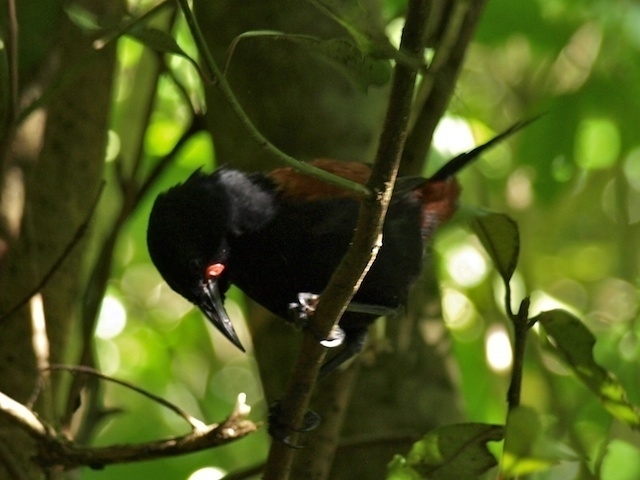
(OK, that wasn’t that impressive.)
But I console myself that I probably managed to get the best picture ever taken of a saddleback’s arse.

But aside from trying to take photos of them, they were lovely to observe. I watched one bound up and down tree boughs, inspecting little leaf-falls and bark clumps for insects. When it had caught something, it would bounce back through the branches arching over the track to another saddleback. The second bird performed what looked like begging movements: bobbing and wing flickering. It got the food - so it must have been a pretty much fully fledged chick.
Lazy bugger needed to leave home, I thought.
We rounded the upper lake and rejoined the main track back down the valley. Sadly, all the Kaka (Kākā) were out and about - on fine days they apparently don’t like to hang around the Sanctuary and instead venture out into the suburbs and beyond.
(One fine day in springtime last year we had a kaka visit our house, four km from the Sanctuary. Judging by the various videos and photos taken by people living close by, it appears kaka have learned that if a house has a deck, then one can obtain food by boogieing up and down the deck railing in a fetching manner (as our visitor did). We weren’t smart enough to figure out what it wanted… but then we wouldn’t have fed it either. It flew away before I could get a photo.)
We passed the terraria containing baby Tuatara. The girls and R. thought they’d grown quite a bit since January when they were last here:
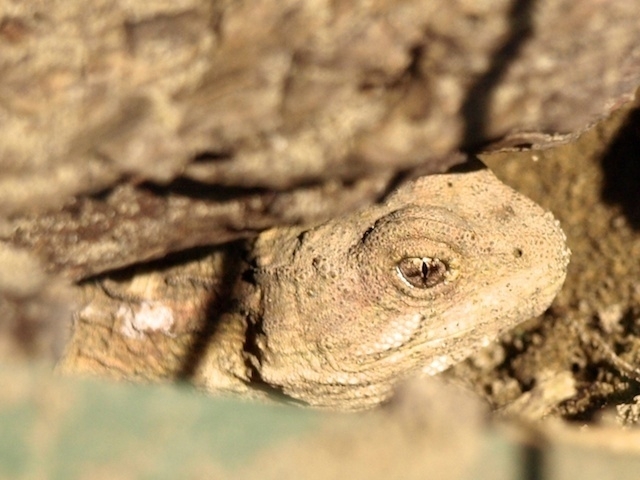
Like the geckos, they actually took a little bit of spotting in their little scrapes under pieces of bark.
But as for me, all that walking, together with the name “Tuatara”, was making me feel thirsty for beer. I am a chap of simple needs.
And so on to the top of the lake, where there was a couple of Takahe (Takahē) lurking. OK, so they’re practically tame and wander about at your feet, so pictures are easy:
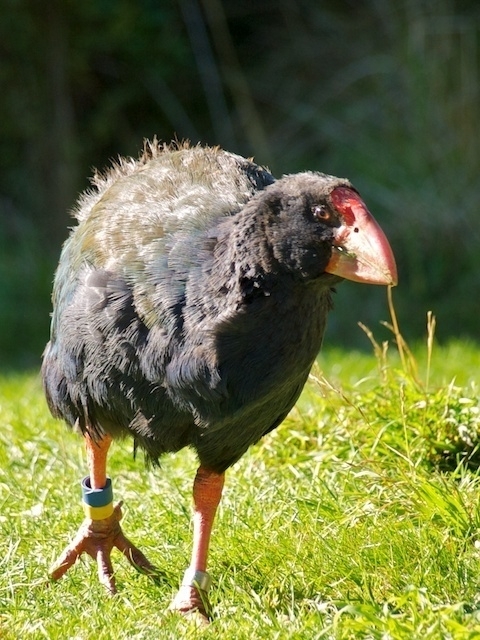
I don’t think it’s an especially pretty bird (not that that matters, and of course opinions vary), but I like the way the sun catches its eye.
Since the last time I’d been to the Sanctuary they’ve spent up large and built an “attraction” - an exhibition and café. We skipped the café and had a quick look at the exhibition.
I found the whole thing a bit of a downer really: really interesting, but very very sad. Stuffed birds yes, but lots of good info and interactive displays. But in the stairwell to the upper level there were plaques for a whole lot of extinct species I’d never even heard of. And then there was the thing they show every half an hour, a five minute montage of the last 1,000 years of biological history, a epic disaster movie showing just how all those species were lost. It was so sad and disturbing our youngest couldn’t watch it.
I ended up wondering if, given how badly the human race had f••ked up on these islands, was it worth trying to save anything that couldn’t now save itself? If all we humans disappeared tomorrow, the Sanctuary would be overrun with pests and every one of the rare species killed within just a few years. Is this “mainland island” a sustainable approach to conservation?
But I suppose the point is not so much sustainable conservation, as awareness that things need doing. But frankly, I’m not sure we’re up to the task of doing it. Humans themselves are a plague, a dangerous monoculture of maximal resource utilisation at the expense of all others. We’re at a stage now where there’s decreasing room for other species, except those that can live in parasitic or commensal relationships with us.
What a happy thought.
I never got to see the falcons close up - maybe another time. Even so, I’m not likely to get photos as good as these by Steve Attwood, who hung out in the Sanctuary for days getting them.
Still, we had a lovely walk of around eight kilometres, which made me happy. Then back at home, I had my beer, which made me happier.
Easter was not wasted.
I know it wouldn’t be top of the list for most people, but I’m a bit pleased about the new walking route to work I figured out last week. (In case you haven’t noticed, I lead a quiet life.)
I live in the suburbia behind Te Ahumairangi Hill, and to get into town I must traverse the hill’s shoulders (over the top is doable, but not paved). For the last ten years I’ve walked around the southern end of the hill; and this has been from where I’ve taken a series of 211 photos over the past seven.
But it turns out that my new way, around the northern shoulder of the hill, is about 500m shorter, and quite a bit faster with a long shallow gradient that can be walked down at speed. And I get to look at a whole new bunch of things on the way.
This morning I had to go to work a little earlier than usual and the sun was just over the eastern rim of the harbour. I was rewarded with this photo down Wade Street:
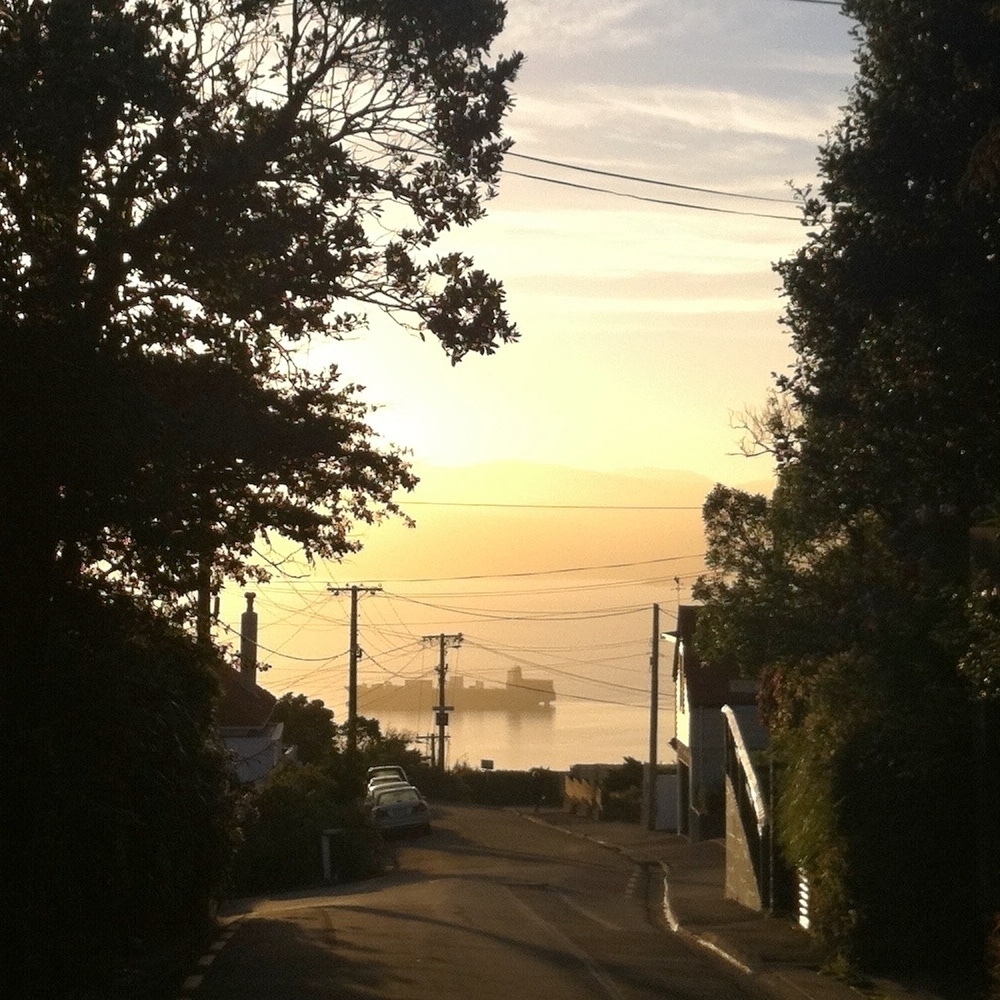
And closer to town there was this rather large chap:
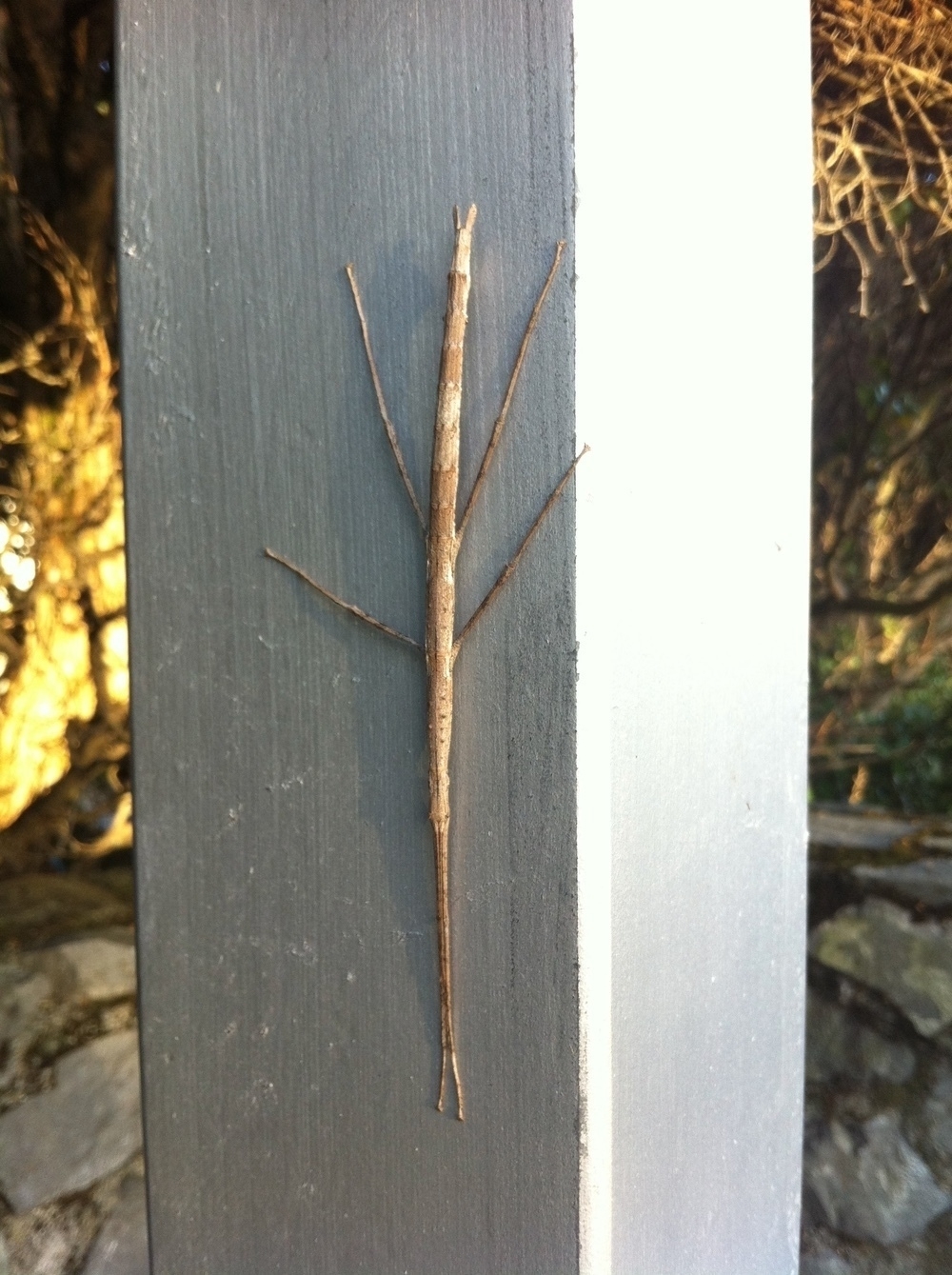
It (probably a “she”, but I’m not sure) had been sitting on a pole beside the Molesworth Street overbridge most of last week, the only nearby cover a patch of low and likely inedible conifers, and I meant to shift it into the undergrowth before it got eaten or otherwise killed.
Each day I would note the beast but keep walking on, fixated on reaching work in time (why, I know not). Usually a couple hundred metres down Molesworth Street I’d think I should have rescued it but of course by then I was never going to circle back for it.
Even after the weekend’s storm I was surprised to see it was still there today, so I picked it off and carried it into the nearest patch of likely looking native plants, its legs slow windmilling until it found purchase on a broadleaf.
This was, I am pleased to report, the highlight of my working day.
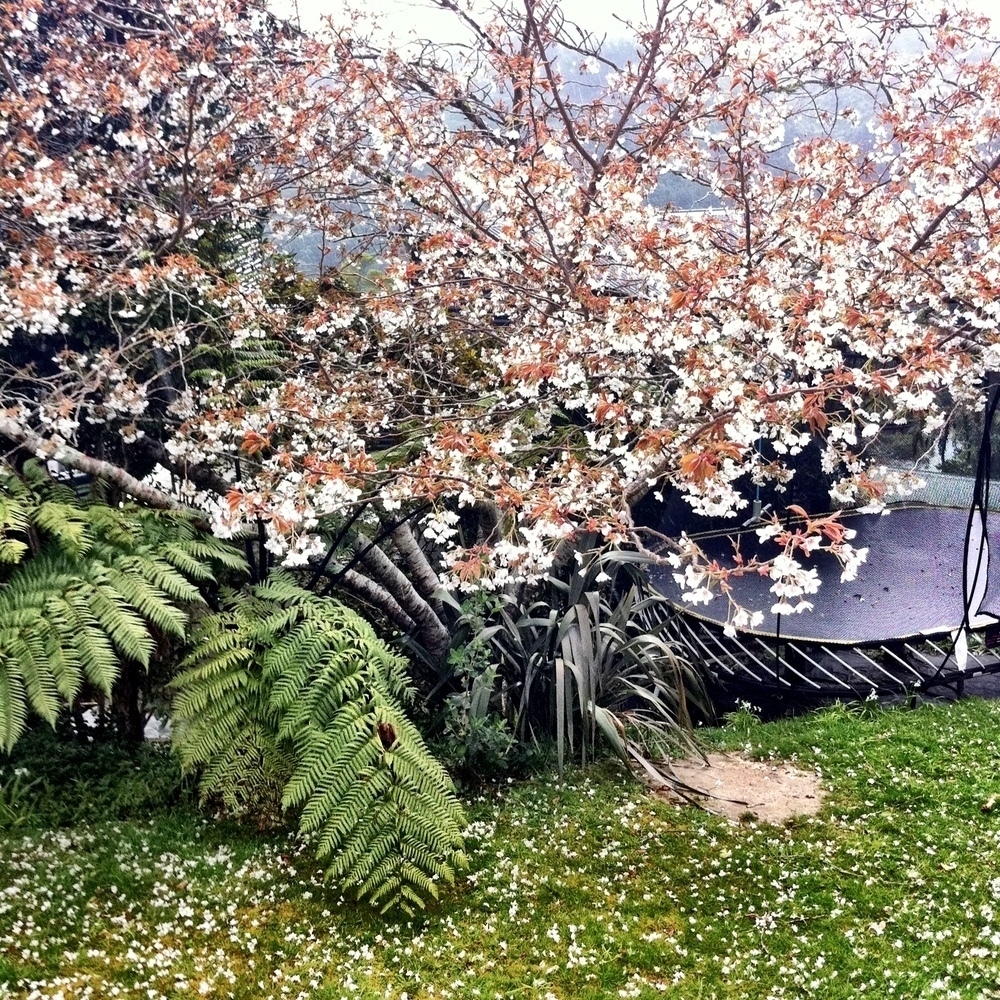
And I regret now the freakshow filter I put on this hastily shot iPhone photo. But here are plenty from earlier years to make up for it.
Previous springtimes:
Knowing how happy I am to find stick insects, B₂ called me outside this morning to have a look at this one, whose exact like we had not seen before:
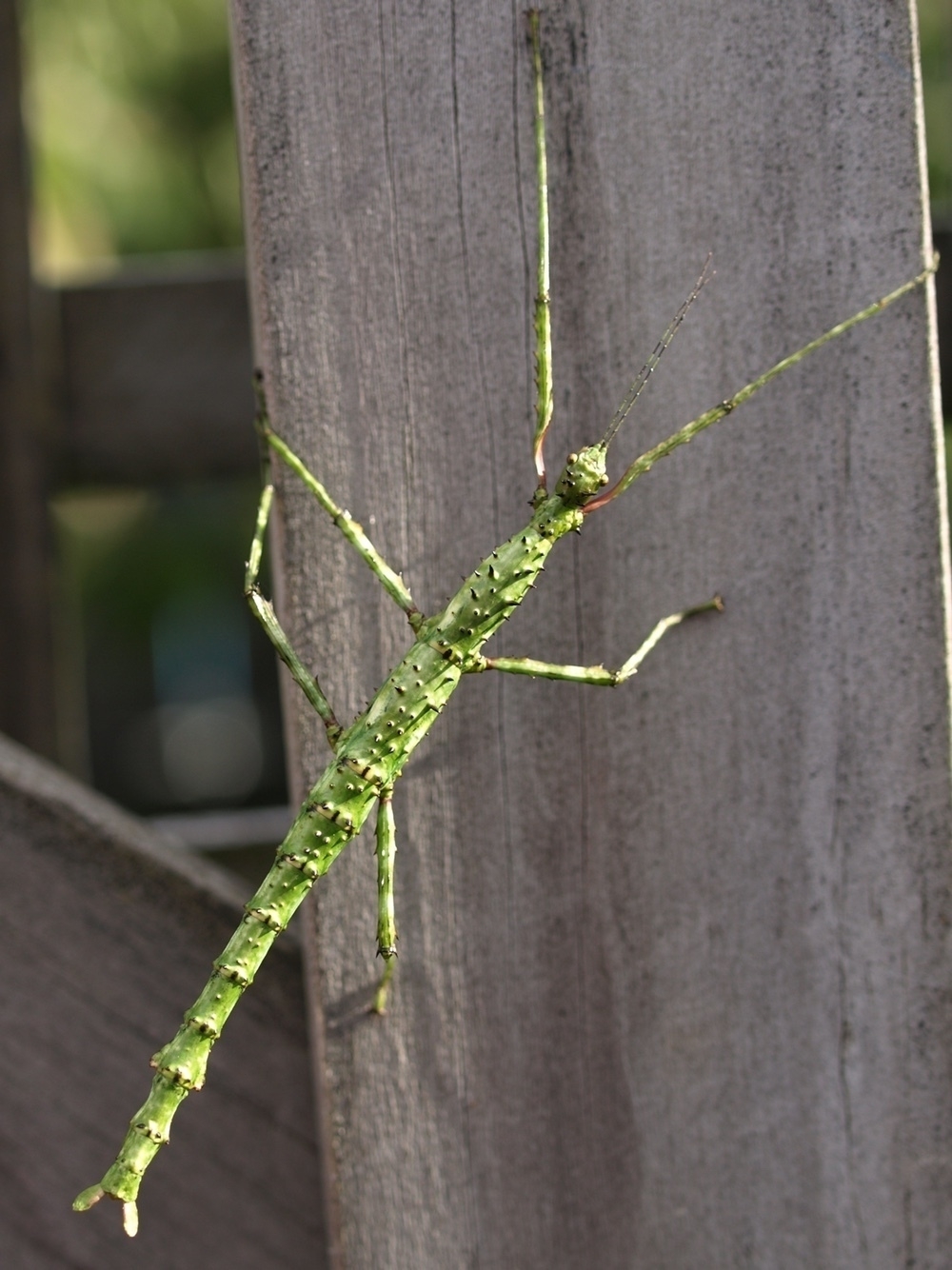
We have lots of the smooth green ones, and plenty of the brown variants of those, and occasionally some pretty fearsome looking brown and spiky ones.
But there’s so much variation of colour, size and texture that even today’s one probably belongs to one of our previously seen species.
It was probably a member of Genus Acanthoxyla, I thought after I had a good poke about in the Stick Insect pages at Landcare Research.
I particularly like her spines (it’s easily a “she”, because apparently no males have ever been observed for species in this genus, and it would be pretty unlikely for me to be the one finding the exception):
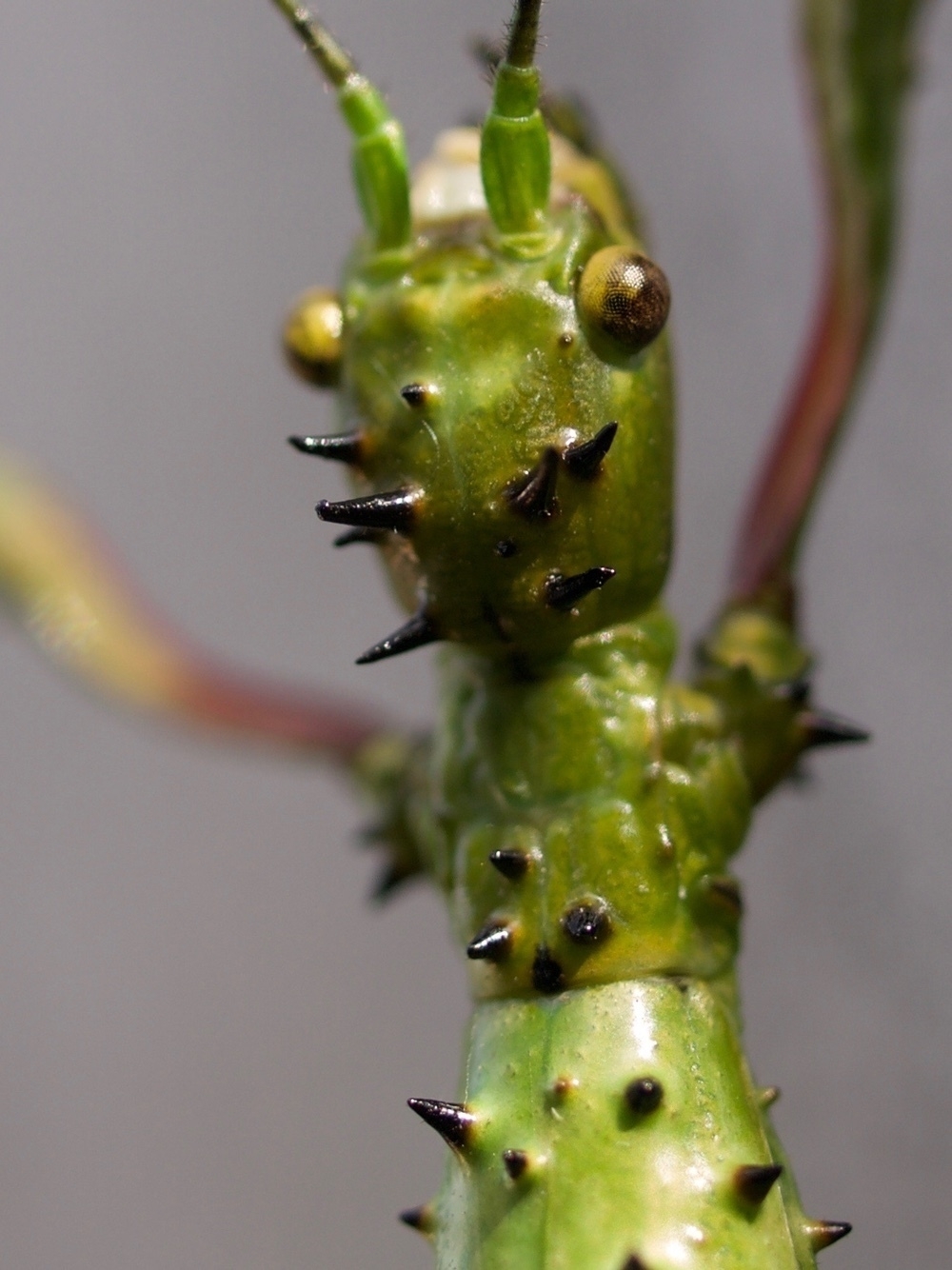
And also I like the rather nice biomechanical look of her segments, and the variegated colour patches which taken in the whole really contribute to the overall camouflage effect:
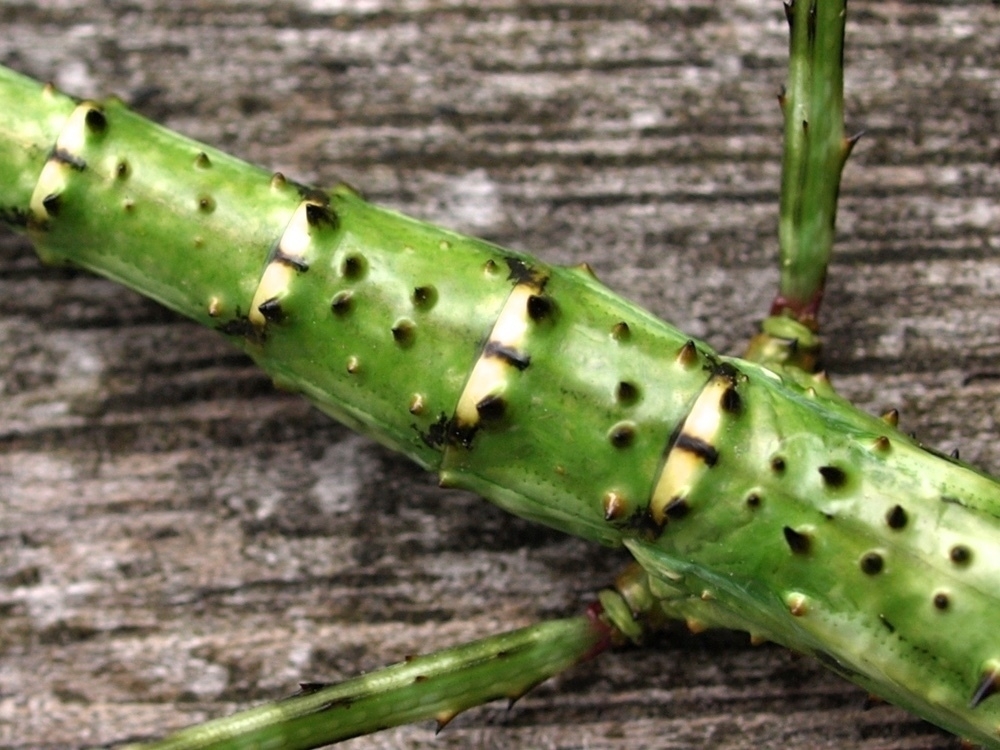
And then there’s the sheer alienness of her gaze, her incomprehensible mouth, and the rather pretty red patches on her forelimbs:
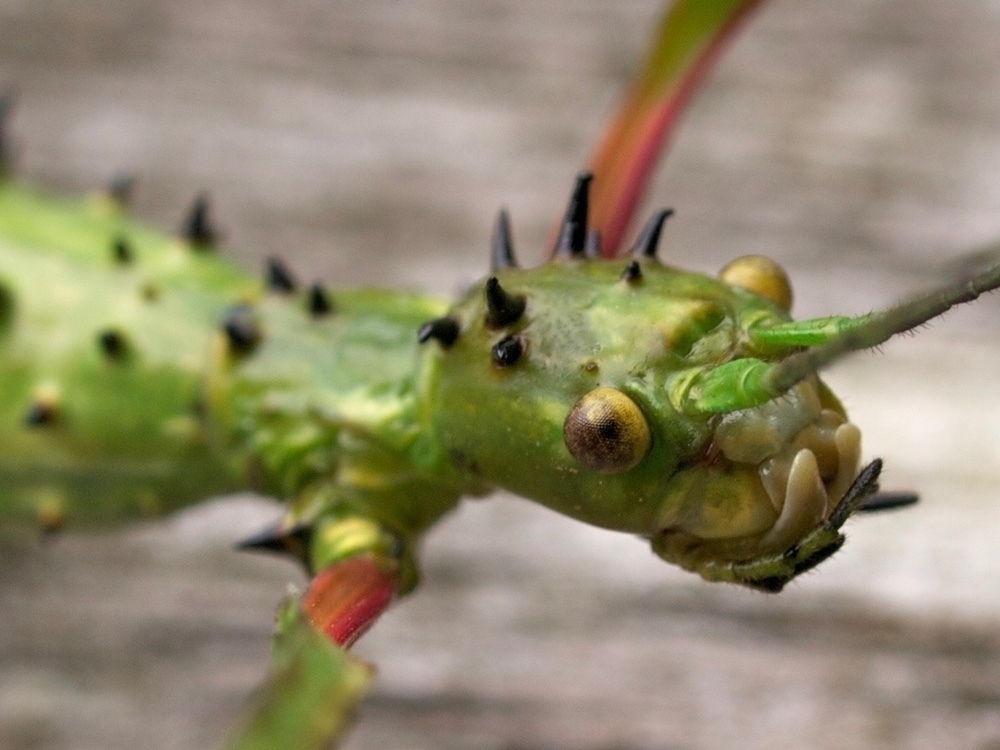
Yep. Weird. But cool.
I’m so happy we have wee beasties like this around our house.
Yesterday we had been watching out the window as the little common skinks came out of the grass to bask in the sun on the retaining wall outside the kitchen window. They’re pretty spooky though, so I’d never managed to take any photos. They’re another one of those animals that seems to be intensely aware of when it’s being observed: the moment your eye flickers away it will disappear. Like magic.
Later I was mowing a very long patch of grass (we had a few left over from our holiday) when I noticed a sinuous movement across the sparsely grassed dirt left behind by the mower. It was another little skink, now trapped in the open.
Rather than trying to dash for cover, it kept freezing and hoping I would fail to notice it. I corralled it easily, and when it climbed on my right hand I quickly cupped it with my left.
I called for R₂ to get her insect viewer, and we were able to place it in and have a good look1.
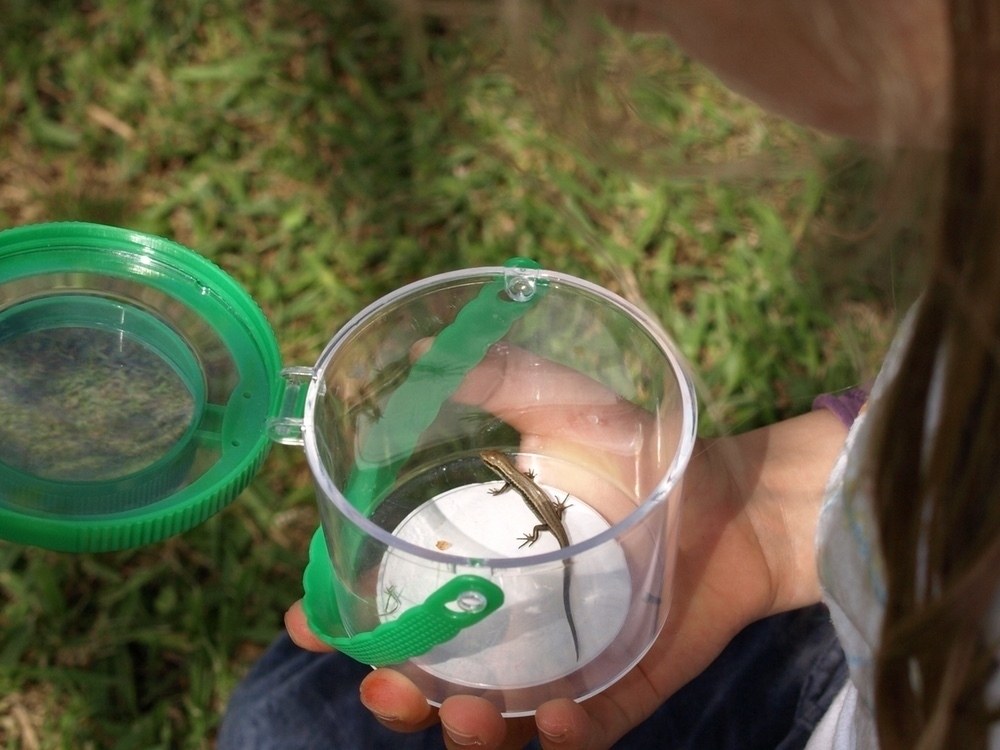
It was very beautiful; all stripes and scales:
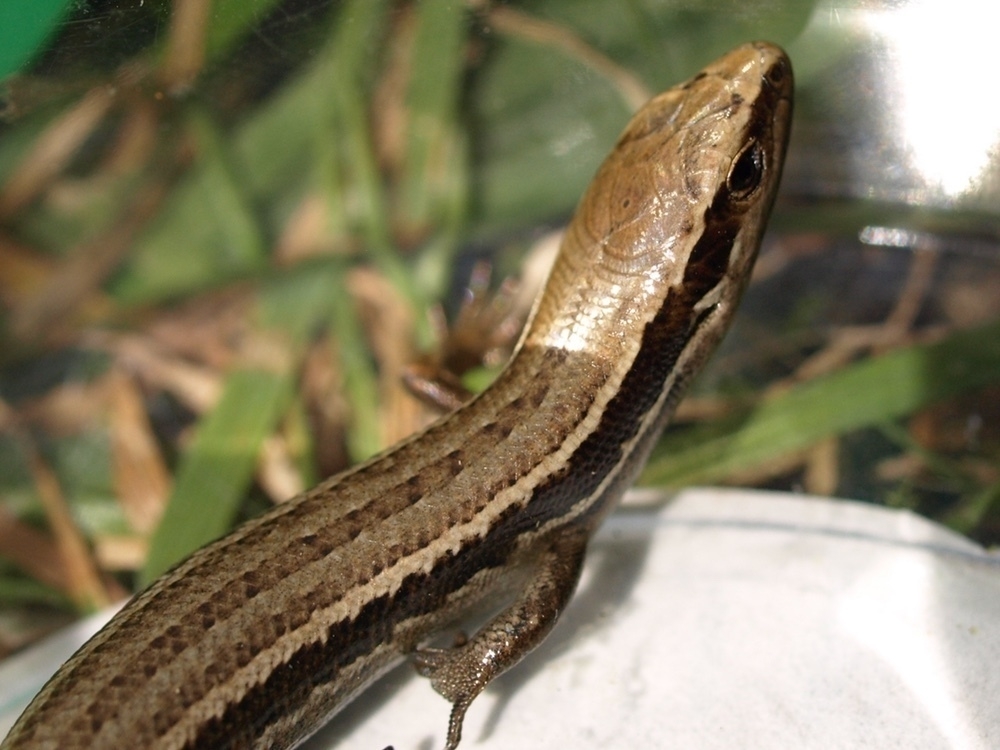
As it customary, the girls awarded it a name (“Chocolate, the brown lizard”), and R₂ even tried to pat it. Unfortunately little wild lizards are not calmed by stroking, and it got a little agitated.
We thought we’d better put it back, so we found a spot on the lawn not far from some good cover, in the hope that we could observe its run across the mown grass to safety. To our surprise it did something else:
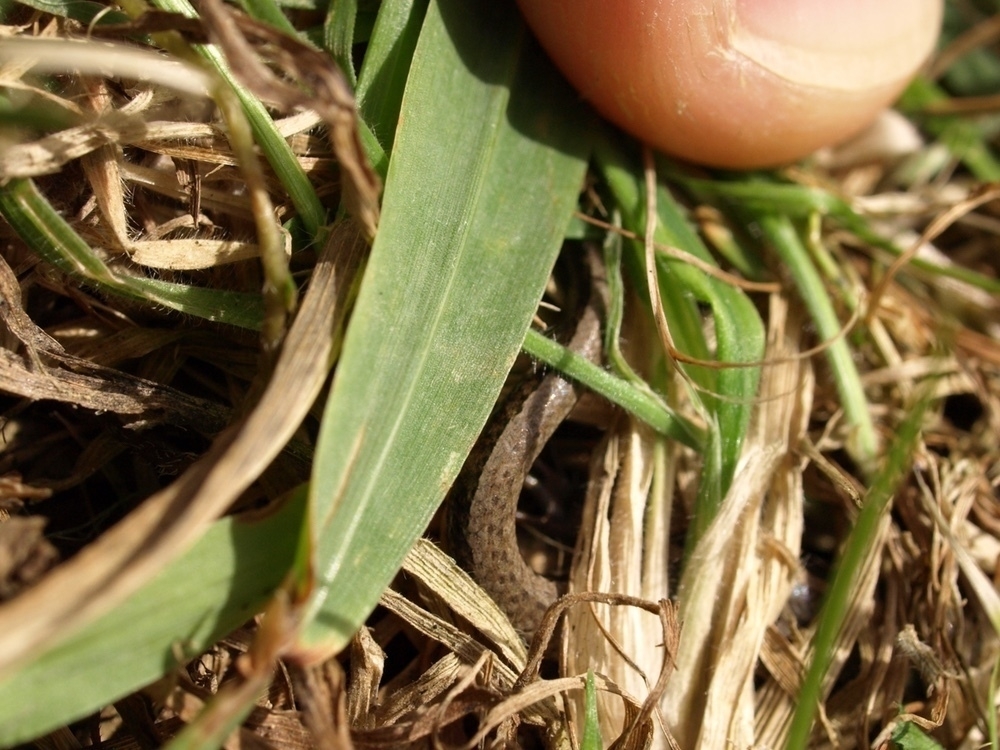
It had dived right under the grass, into the gaps between the shoots, with the interlocking sward above it providing cover. We tried to follow its progress by looking for the vibrations in the grass, which worked for a little while, until a moment’s inattention lost it from view.
It was easy now to re-imagine it as a terrifying beast of the grass-jungle, squeezing and twisting between the “trees” in search of prey: ants, slaters, and grasshoppers; and it is possible my colourful description may yet prove counterproductive to R₂'s sleeping-patterns. We shall see.
And meanwhile, little Chocolate is, I hope, none the worse for its own terrifying experience at our hands.
The last time I tried this, when I was a kid, it all went pretty badly. Not that the lizard–a larger one–tried to bite me, but that it voided its bowels all over my fingers, leaving a stink that took several days of hand-washing to disperse. ↩︎
In neglecting this blog I’ve also been neglecting my related hobby of posting arachno-porn.
Time to fix this. A little.
Well, the other week down by the Taieri River we (or more correctly, that nice Scottish-Kiwi family from Auckland who we kept crossing paths with on the Rail Trail) found a pair of lovely and large water spiders (Dolomedes aquaticus, according to Forster & Forster):

Once I changed lenses I was able to get a nice close-up of the smaller, probably male, individual (though, as always, I never quite get enough depth of field):
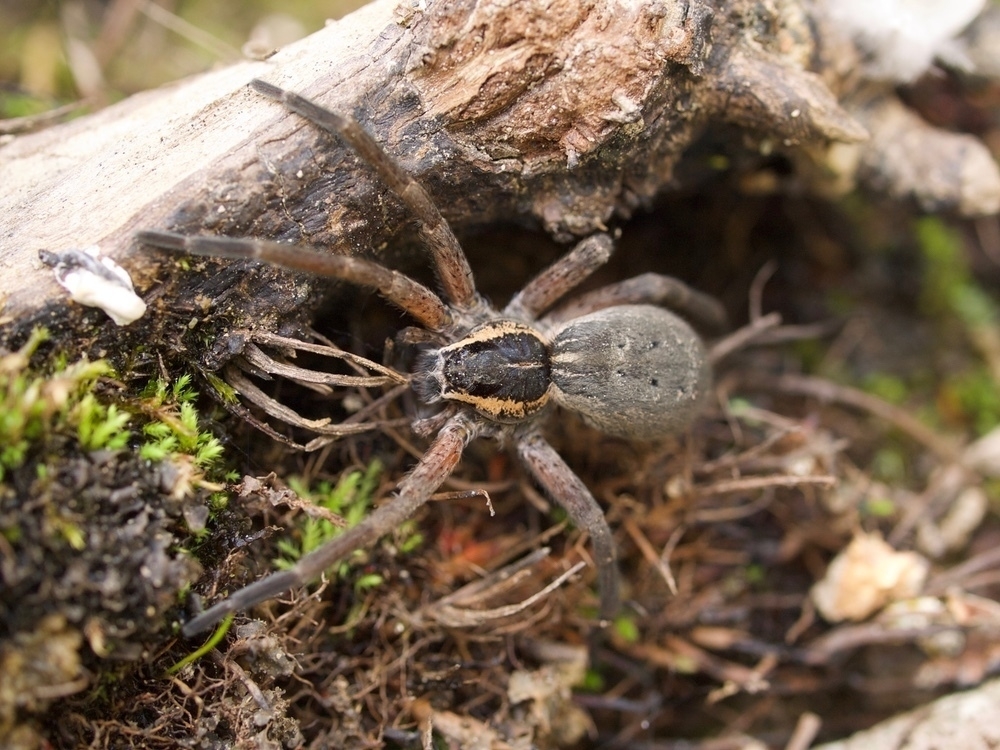
Meanwhile, the other one had disappeared around the side of a rock under the water. It sat there and didn’t move, the trapped air around its body providing a silvery aqualung.
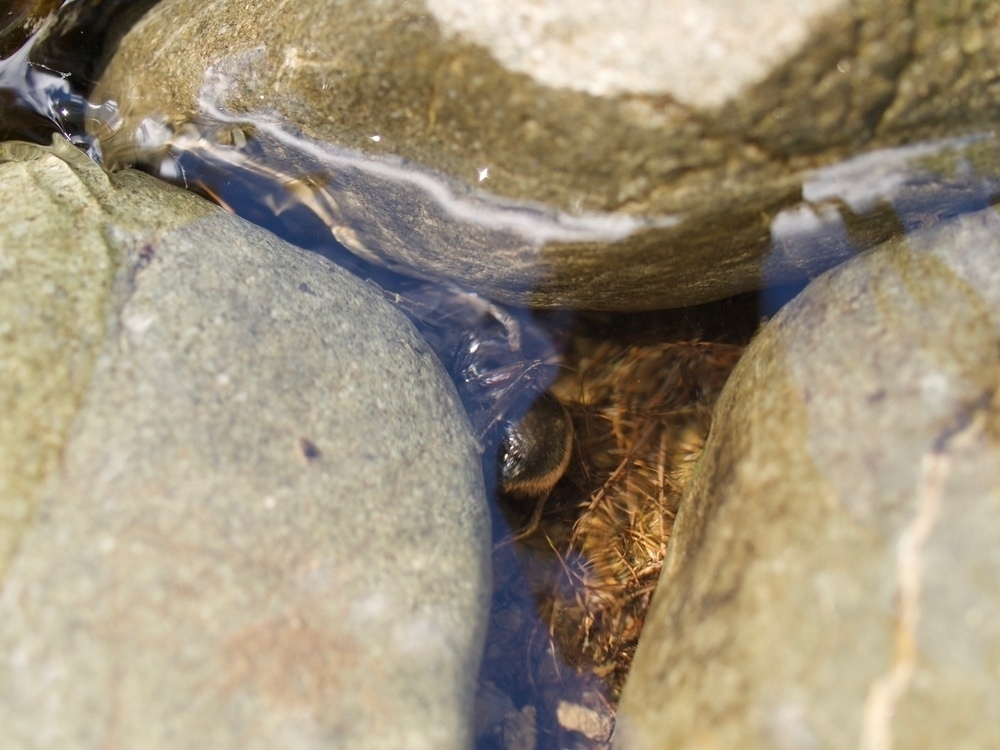
Given that this handsome pair were probably in the middle of some sort of courtship process when they were disturbed, I’m thinking this fully qualifies as arachno-porn.
So enough for now.
Five years ago I came across a very weird arachnid in a clump of grass by the side of the house. It was a harvestman - so eight legs like a spider (though much longer and finer), but with more of an all-in-one body shape.
But three things distinguished it from the standard grey-brown european harvestmen we commonly see: it was black and velvety; it had orange stripes; and most obvious of all, it had massively overgrown mouthparts (chelicerae).
By overgrown, I mean HUGE - thicker than its legs, though not longer. Weird and interesting enough that I’ve been hoping to come across another. Which I did, today.
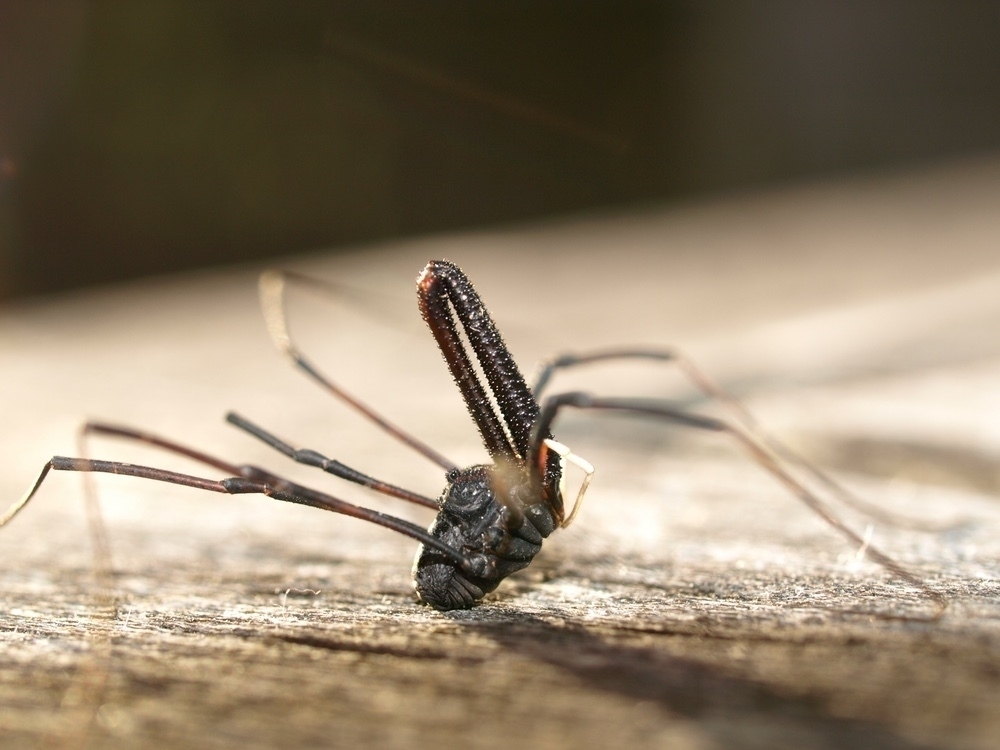
We’d been carting old wool packs of rubbish down the steps to the trailer, filling it up for a trip to the quintessentially suburban Sunday destination, the rubbish tip. And there it was, just inside the top, looking a bit battered.
I carried it back up the hill, and all the while it beat against the inside of my cupped hands. I figured it wasn’t a biter, based on the shape of those mouthparts.
And then, out in the sunshine for some photo modelling. This one didn’t have the same orange stripes, but otherwise it was velvety black and outrageously equipped:
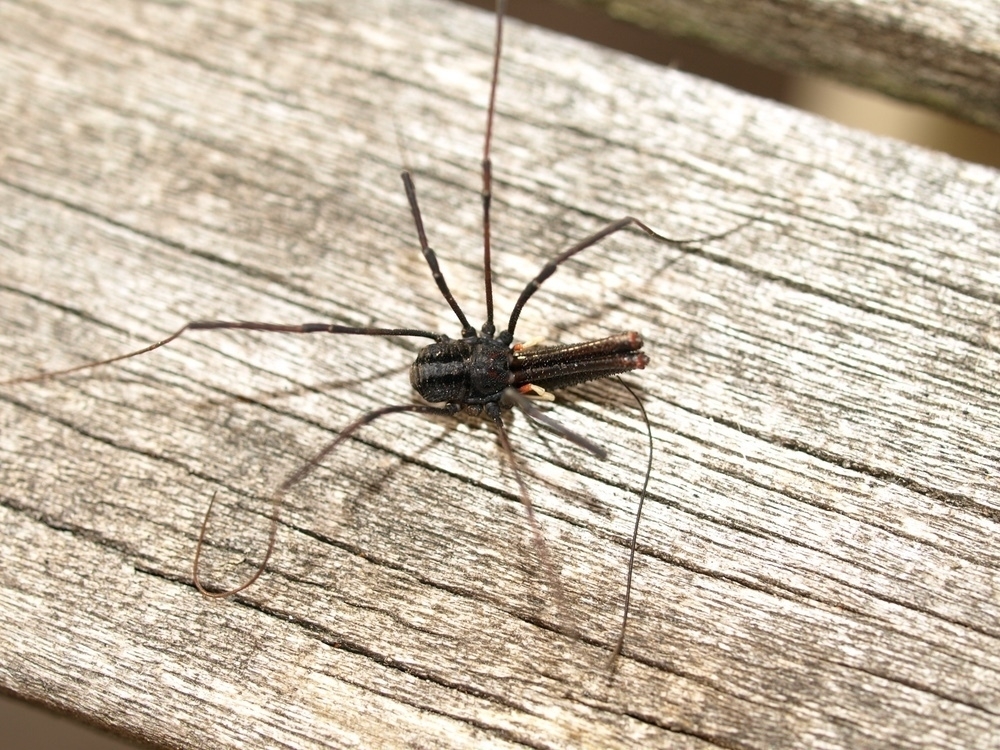
The females, on the other hand, are completely different: orange-brown and lacking in the giant chelicerae–so different that for many years they were thought to be a different species. I caught one of these a few months ago, but neglected to take photos. Small mercies, eh?
Anyway, what else will I find this summer? Wouldn’t mind one of those tailed spiders again…

Just as we were dashing out the door, R₂ spotted this.
They often seem to get “trapped” in the side of our house, something that I think the local blackbirds (and the tuī that are increasingly emulating them) take advantage of.
Yes, our house is painted a revolting pink. And yes, the stick insect is quite the virulent green colour (only slightly heightened by Instagram, in this photo).
We are big fans of stick insects here, yes we are.
…et cetera et cetera, though of course it’s September rather than May. Even so, it’s time for the annual blossom photo.
It has been very windy in the last week, what with that somewhat overhyped spring “storm”1 covering the country for the last week or so. So our view of the cherry tree has been mainly this sort of thing:
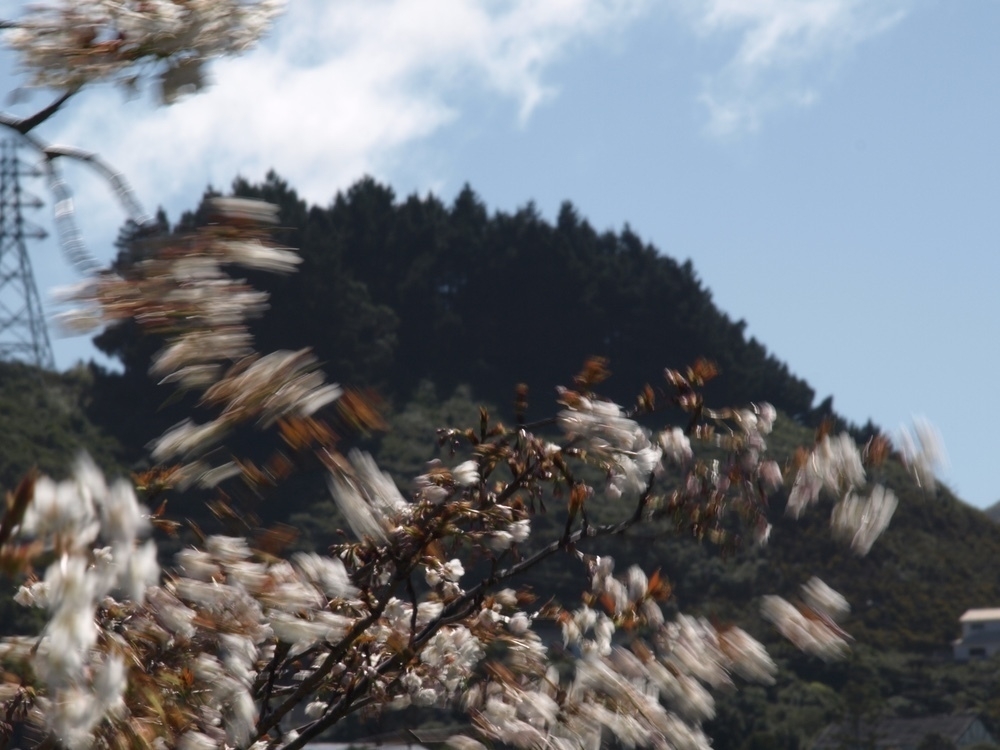
And to top off all that thrashing around, once the wind dies down those the sparrows from two years ago return, attacking the flowers at their base and damaging many enough to have them fall to the (overgrown) lawn below.

You’d think that those territorial tuī in the tree would have something to say about all this. But they’re too busy huffing and puffing at each other to bother chasing the sparrows away every time. There’ll be something left for the them and the kererū in November, but probably not a lot.
But that’s life, for another year.
Previous springtimes:
Later: I’m thinking that I should clarify that “overhyped” applies to a Wellington city-dweller’s experience of the storm and its media precursors, rather than the experience on the farm, which in many places was pretty bloody awful. ↩︎
The sunsets here are insanely great. And the days are not far behind. There’s a simplicity to the autumn; the cool south-easterly transmuted by the mountains behind us into a humid breeze carrying the occasional fat raindrops. Out to sea, under the swing of the sun, it’s raining. We are on the Land’s Edge, here.
The girls have been cracking macadamias; but the bananas have been eaten by earlier visitors and the avocadoes are not quite ready yet. R₂ and B₂ are in and out of their togs all day, begging us to take them to the swimming pool.
We haven’t even made it down to the beach. There hasn’t been time. The girls have done their reconnection tour though, first thing. Flying Fox: check! Trampoline: check! Mini-golf: check!
Later:
I walk up the hill behind where we’re staying. There’s a path through the bush to a lookout at the top.
The first time we came here I found a giant stick insect, mottled in shades of green like the fern runners clingling to the trees. I suppose I think I’m just going to find another one.
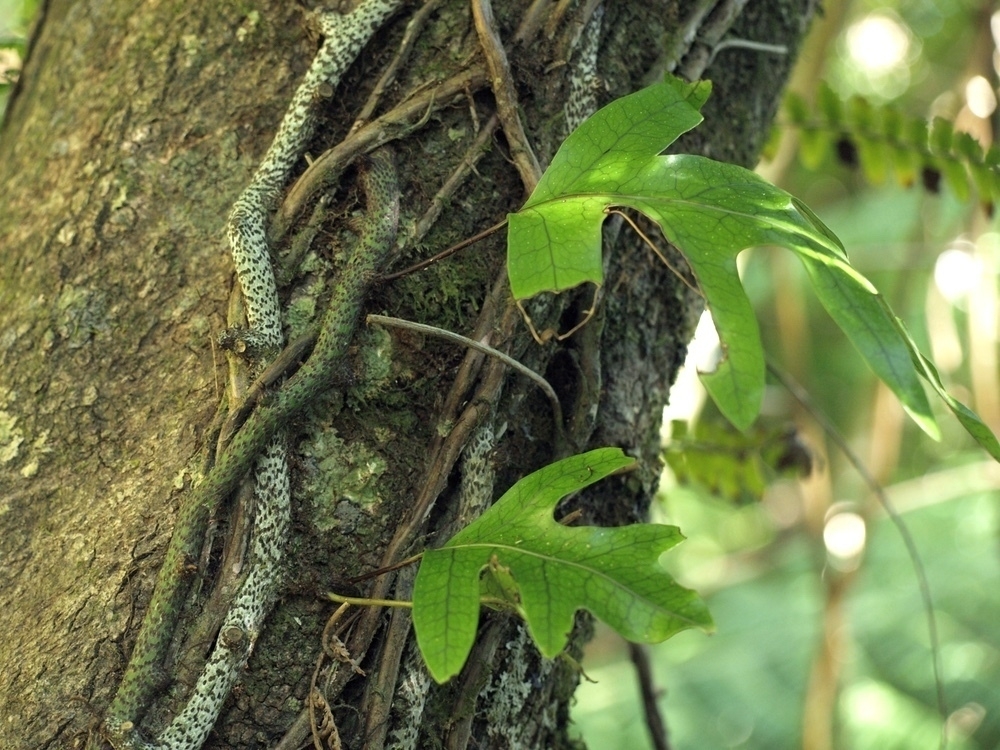
An opportunistic but welcome pīwakawaka follows me, hawking in my trail.
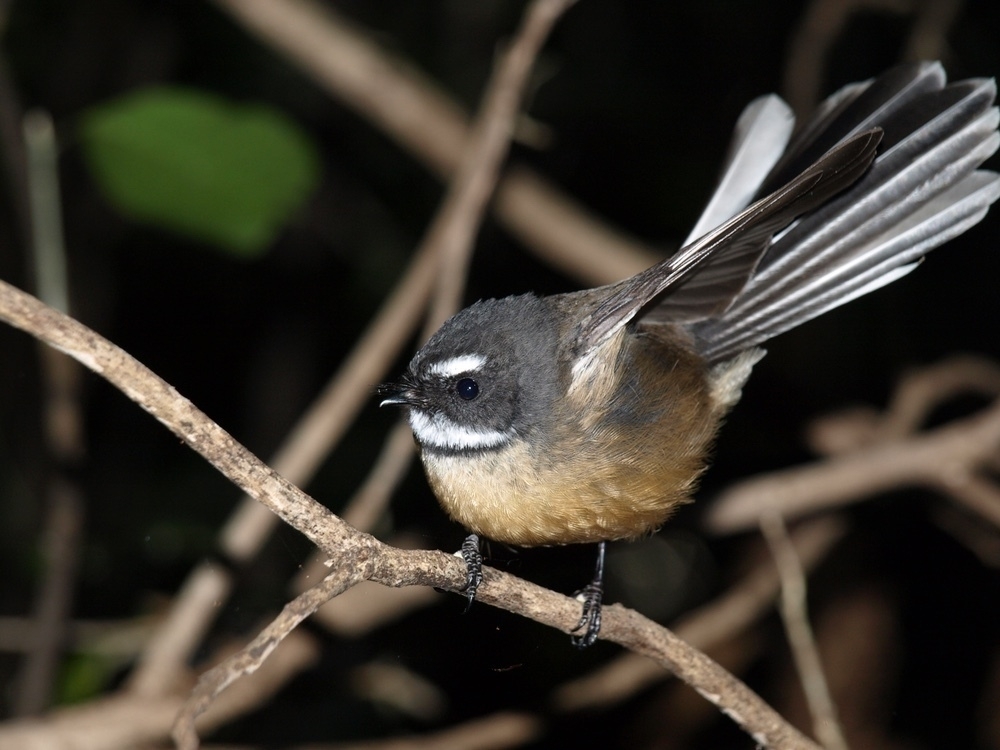
Further up, I get into a singing contest with a pair of korimako. They win, of course, though not without a certain amount of huffiness on their part at the impertinence of the challenge.
At the top the view is immense, and only a little can be taken in at once.
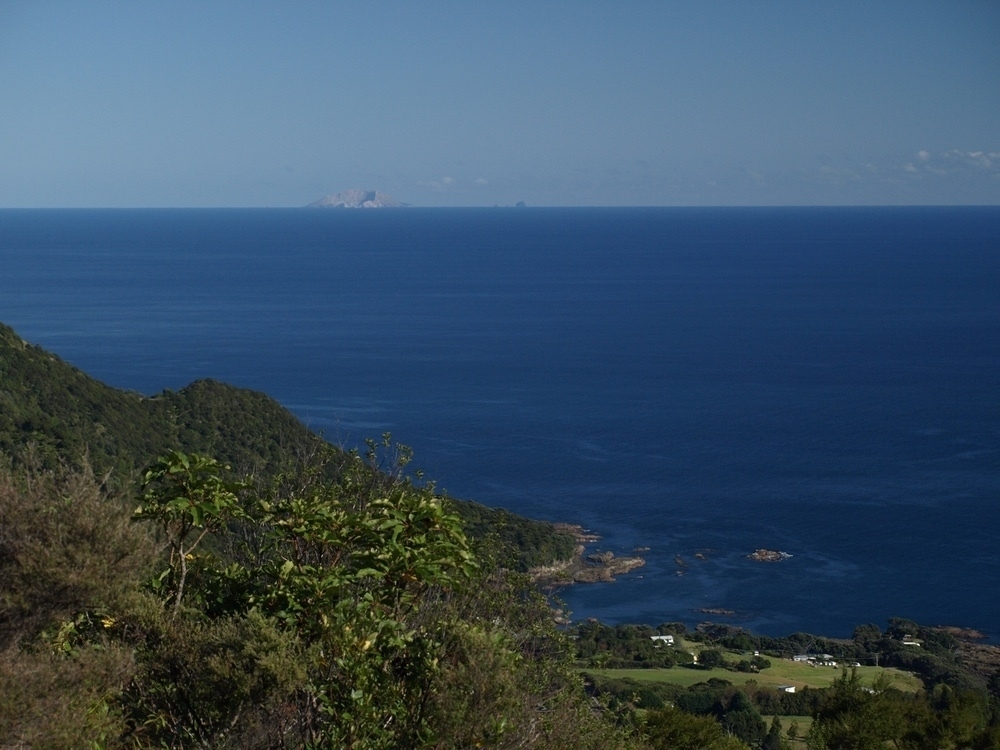
The sea is occasionally speckled with fishing boats; the island volcano lying coiled and quiet, not even steaming. There is a cool breeze from the endless rumpled hills of bush at my back, and the birds make a constant song. The only discordant notes are, as before, the ever-present buzz of wasps; trucks passing far below, and a dog, its bark snatched by the wind and passed far up into the air.
I can see the road as it winds up and down bushy hills; along flats planted in maize and kiwifruit; around rocky headlands where the pohutukawa lean out over the water with outstretched arms.
There’s more detail that can’t be seen from up here: but on that road is a sign that says “Pig Dog Training School”. Underneath, in a different colour, “Bookbinder”. I know that chickens peck the long acre, apparently unperturbed by the pig dogs.
Later again:
Apparently there was snow on top of Hikurangi last night, explaining the cold night; but yet this morning we are in t-shirts and shorts again, almost tempted to break out the sunscreen despite the lateness of the season. It’s hot, though a cool breeze is stirring the pohutukawas as I watch out for the tiny boat that they’ve gone to lift the crayfish pots with. I don’t like boats.
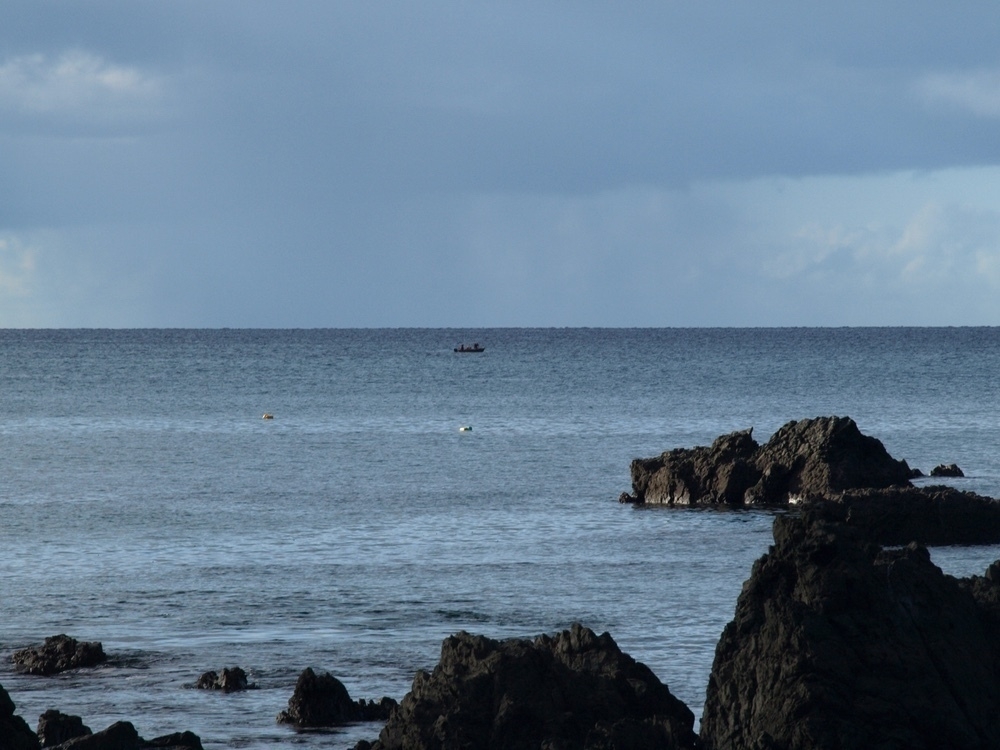
I’m also keeping an eye on a lovely stick insect, green with a creamy white stripe down both sides, that fell on to R. while we dragged the boat out from under the tree. Though I place it in a pohutukawa tree, where it started tentatively munching a leaf, by the time I come back with the decent camera it was gone.
And we have fish for dinner.
In the bathroom, a lost boy had found someone to fight with:
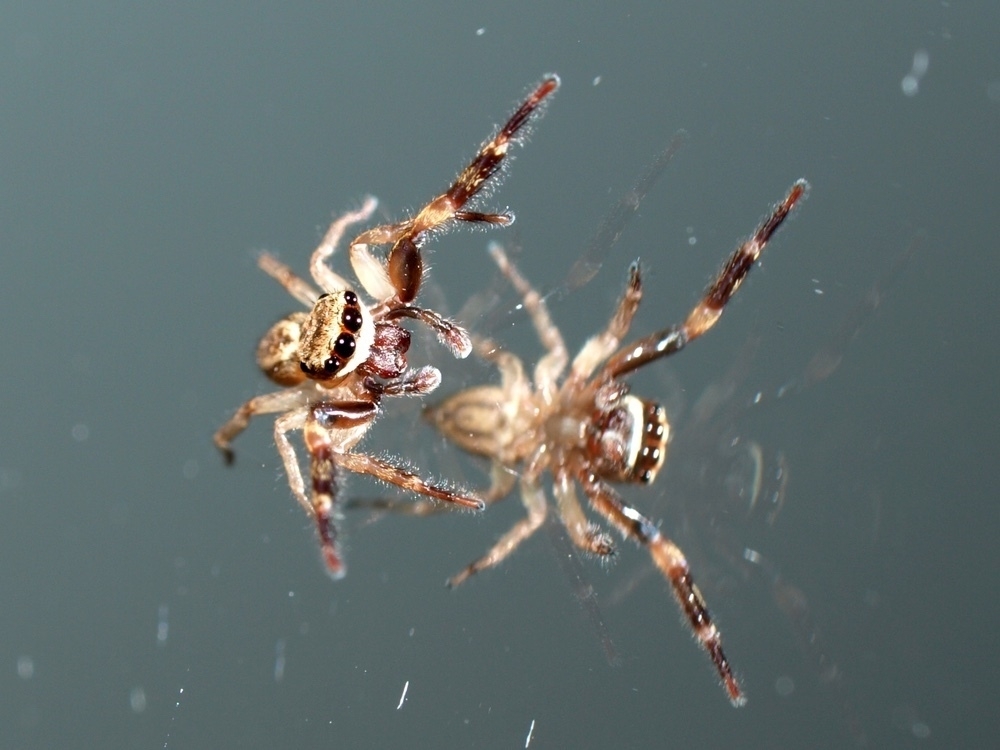
This is a fairly common jumping spider, Trite auricoma. It doesn’t seem to have a common name, so you’d have to wonder how common it really is, but there are plenty of them around here.
It had wandered onto the mirror, and now refused to take notice of anything except its “opponent”.

It started doing the same as I’ve seen them do when facing each other down for real: place its front pair of legs as wide as possible, and vibrate them slightly.
Eventually it did take some notice of the large flashing object getting in its face:
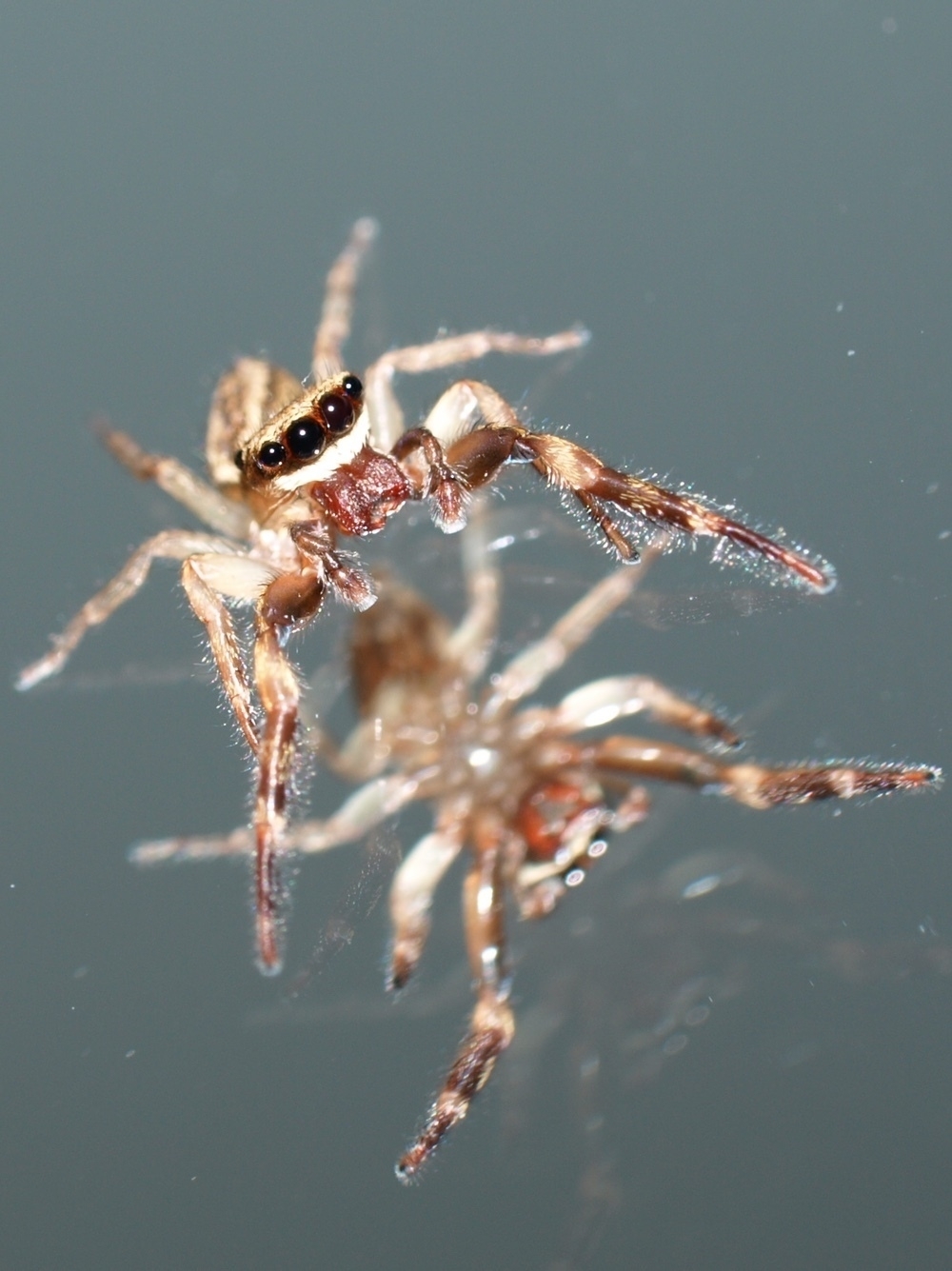
At this point I would have expected it to jump onto the camera but it turned and went back to its business with the other spider. And there it remained.
I should really have rescued it and taken it outside; but when this finally occurred to me (after I had taken all the photos and gone) it had disappeared.
Hopefully it will turn up again tomorrow.
A nice thing about holidays is the chance to allow one’s obsessions to take their proper place among one’s daily activities.
Thus, when I spotted an interesting looking little jumping spider climbing up the wall of our family crib here in Hāwea yesterday, I was able to drop what I was doing, capture it, and take some photos.

It was a very fast mover, and in order to get it to slow down a bit I had to cheat and put it in the fridge. About half an hour later I could take it outside into the sunlight for some shots.
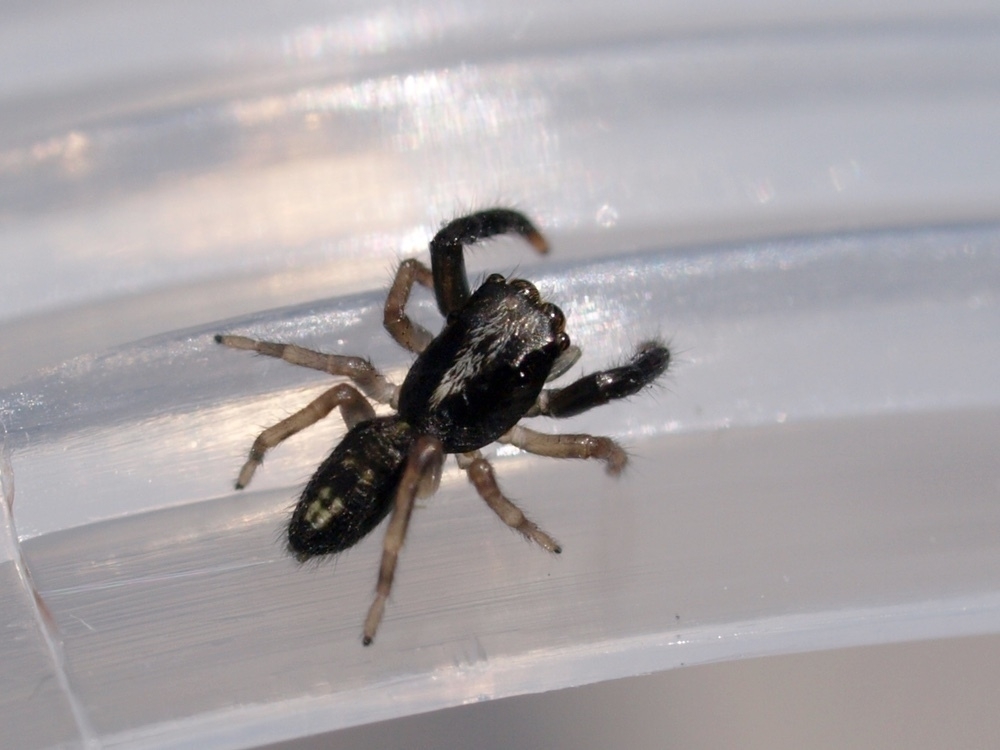
OK, so it’s not hugely interesting, this one, but it’s new to me. It’s clearly a close relation of that large Black-Headed jumping spider (Trite planiceps) we see a lot of up north in Wellington and that I have photographed lots of in the past. However this specimen at least was quite a bit smaller (about 7mm long) and instead of a green stripe on its abdomen had an interesting, and distinctive, little cluster of dots.
Hopefully I can find another to see whether this is typical or not. But even if I don’t, at least I’ve found another jumping spider to add to my List Of Jumping Spiders I Have Found - and what’s more, one that’s not mentioned in my usual go-to book on New Zealand arachnids. Win!
Our cherry tree is now in full fruit, which makes it a pretty exciting place for the local blackbirds and thrushes. Usually we have lots of starlings and regular kererū too, but since we redid the roof last summer, we haven’t seen so many starlings about, and for some reason the big dumb kererū haven’t found the tree yet.
This morning was lovely and sunny, so I stationed myself quietly on the deck with the camera and waited.
Shortly there came a constant squeak, which turned out to be a very hungry baby thrush, looking very fluffy and with only half grown tail feathers:
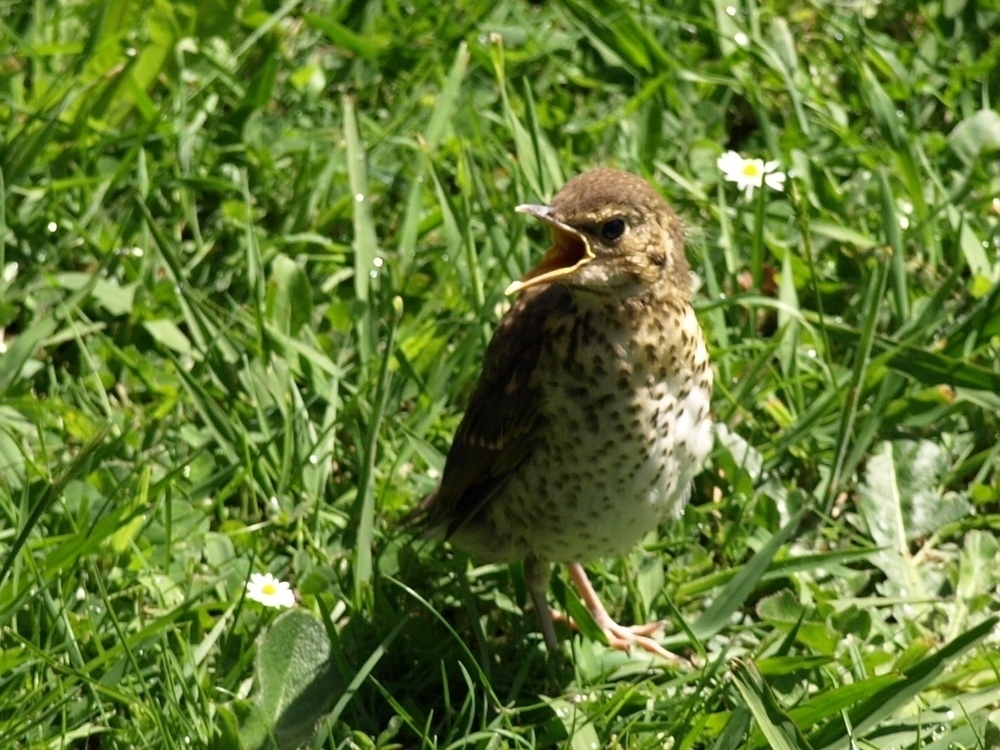
Sure enough, up in the tree there was Mrs Thrush (though it is dodgy of me to name it so - both the male and female thrushes look the same so it could equally as well be “Mr Thrush”):
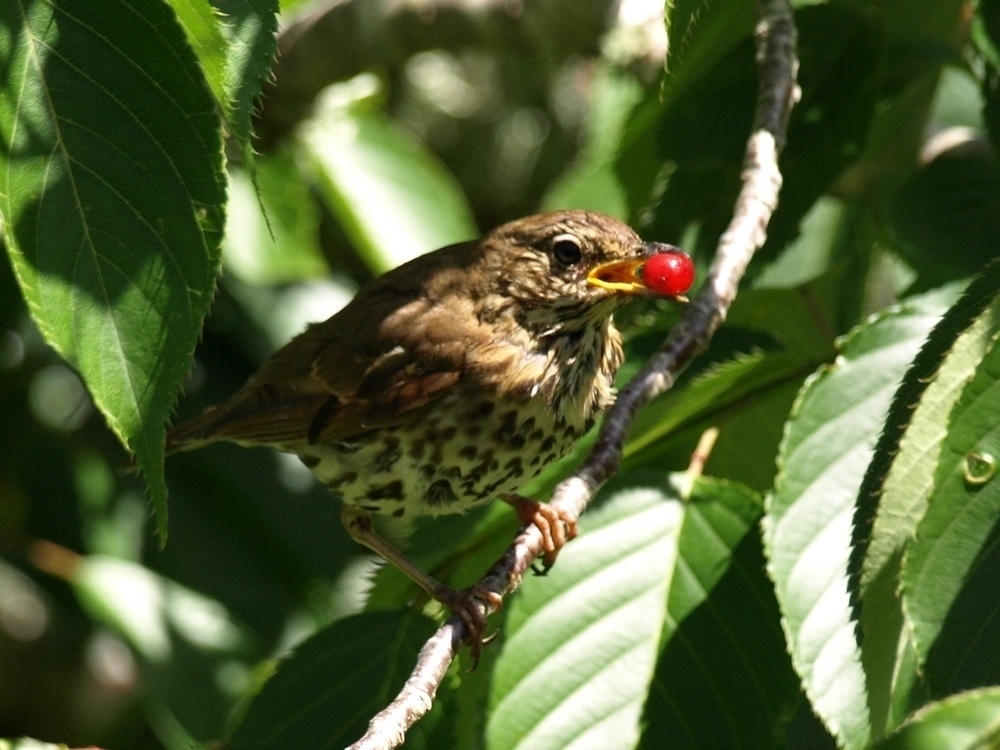
“She” flew down to the lawn, and presented the cherry to the chick:
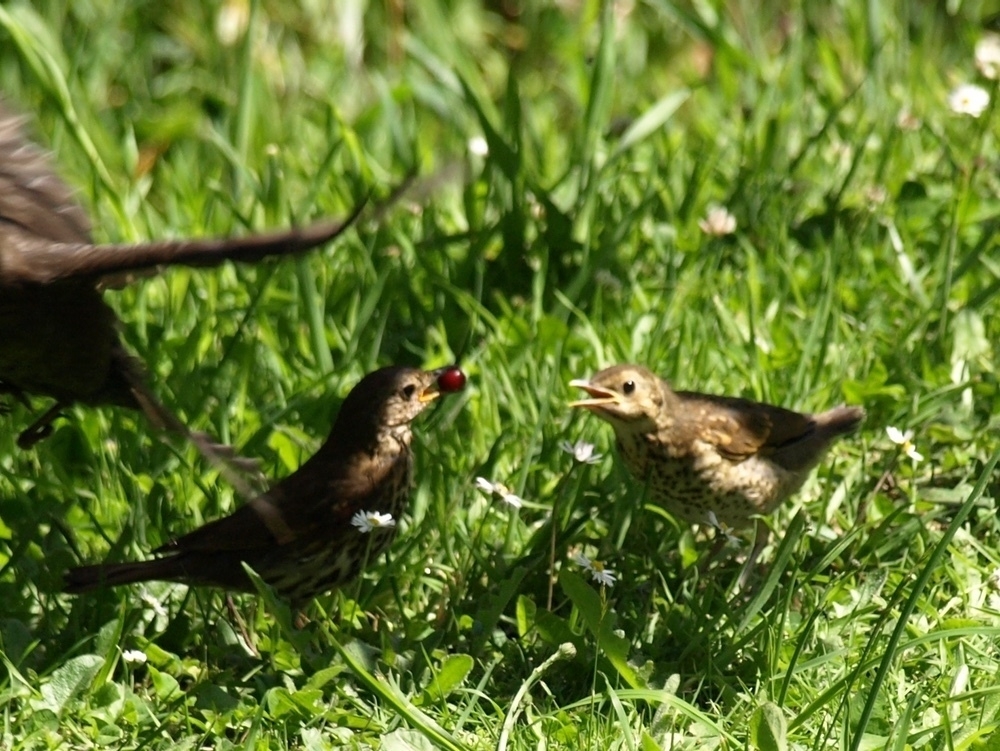
(That’s a female blackbird flying out of shot there. At any one time this morning there were usually three or four thrushes and blackbirds working the lawn for worms and other insects.)
Lovely, just lovely. I could have watched for a lot longer… but I needed to cook lunch for my own.
Later, I swapped stories with my Mum down south; much the same story I’ve related here, plus our kārearea (Falcon) sightings over the house from a couple weeks ago. She trumped all that by telling me about the pair of Tomtits she’s seen in her garden, which is some thirty kilometres from the nearest decent sized patch of bush.
This is something of a mystery, which I hope to investigate a bit further when I’m down there at Christmas time. Could they be nesting nearby?
As we get further into spring, not only do we get outdoors more, and at the same time the outdoor fauna becomes more active.
For example, the House Hoppers are becoming more active on the outside of the house, and I caught both a male and this very beautiful female, surely as pulchritudinous as some cartoon representation of a homely, anthropomorphic spider:
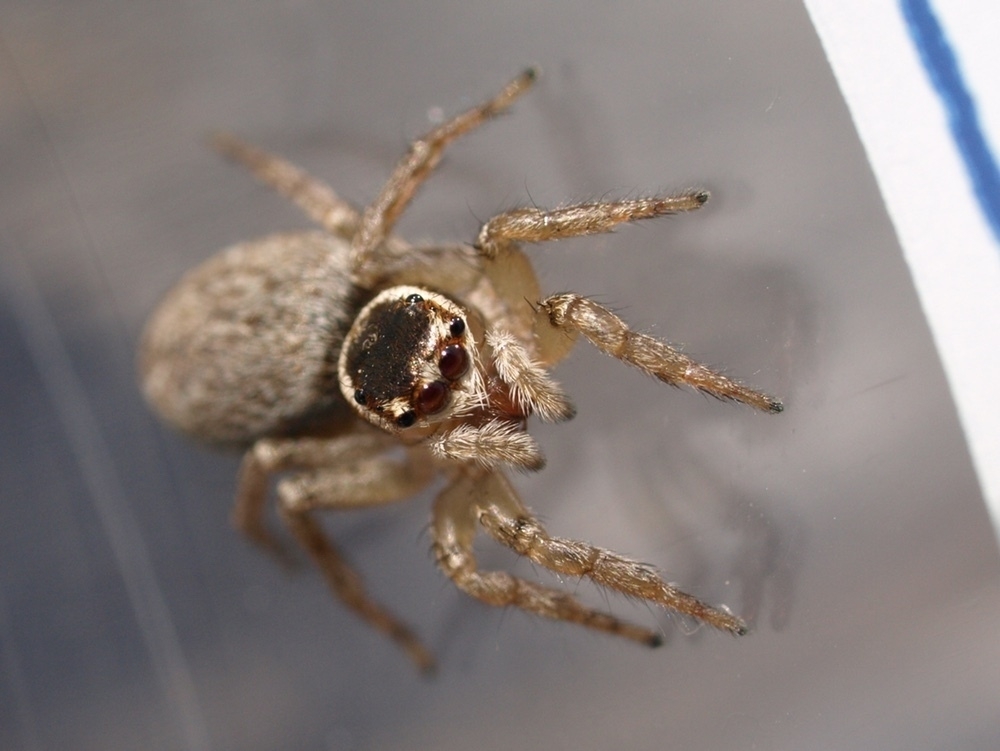
The male was a cheeky wee chappie, like all his jumping spider kin - they remain my favourite kind of spider. I’m assuming he was a “he”, and of the same species, but I’m just not sure. His legs were much stripier, but I’m not enough of an arachnologist to have any idea what to look for.
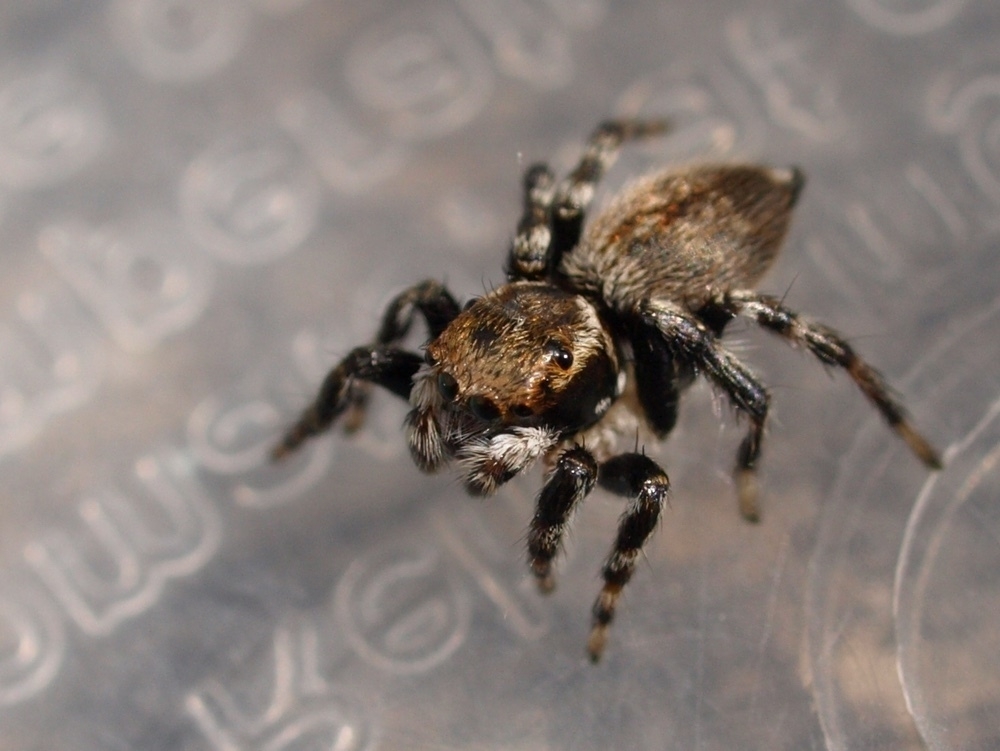
Not so pretty was the large female tunnelweb spider R. found under a sack of bark chips that had been undisturbed since last summer.
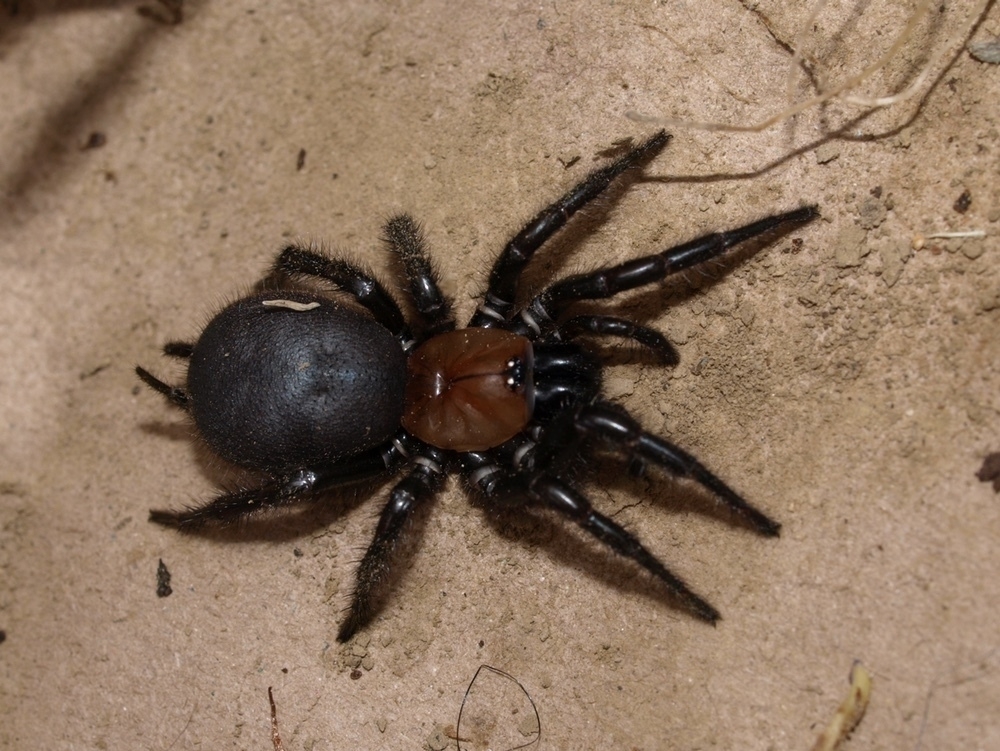
These are very common around our house; the most pleasing thing about them is that they are not wanderers and are seldom seen inside. However they are very large, from head to end about three centimeters not including the legs, and I never like being surprised by them when I’m in the garden. It is said they have a reasonable bite on them too, though I am not very willing to test it.
In my last posting, on the mantis hatchlings, I mentioned the large black-armed jumping spider we had inside. I took it outside in case we get any more hatchlings overnight tonight.
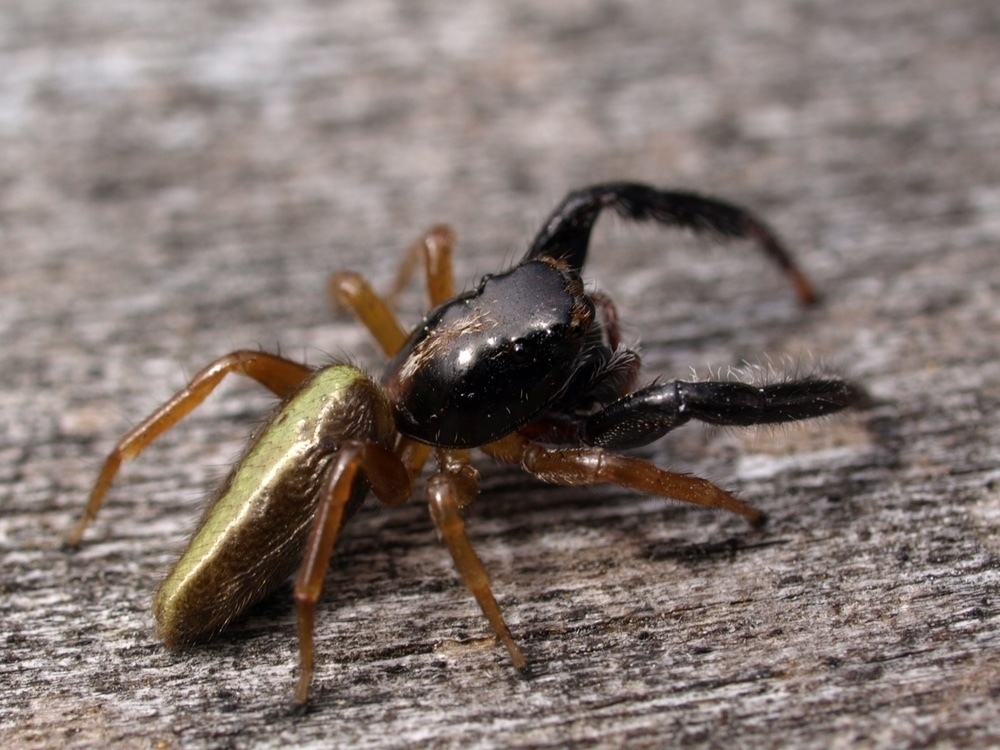
These, particularly the males, are common inside during the warmer months (and their cousins, a smaller brown stripy species, seem to be year-round indoor visitors). With their binocular vision they do like to turn to face objects of interest, which allows us to anthropomorphise their actions to a shameful degree. But whatever - these are cool spiders.
No doubt I’ll be taking more photos over summer, particularly on sunny days when I have a decent amount of light. You have been warned.
Mantis babies, we’re talking about.
Though we never did get around to removing the mantis ootheca (egg case) from the car - it’s still there now - R. did find another one on a piece of rosemary she’d pruned back in Autumn; and since then it’s been sitting on the windowsill.
Finally, this week there was some action.
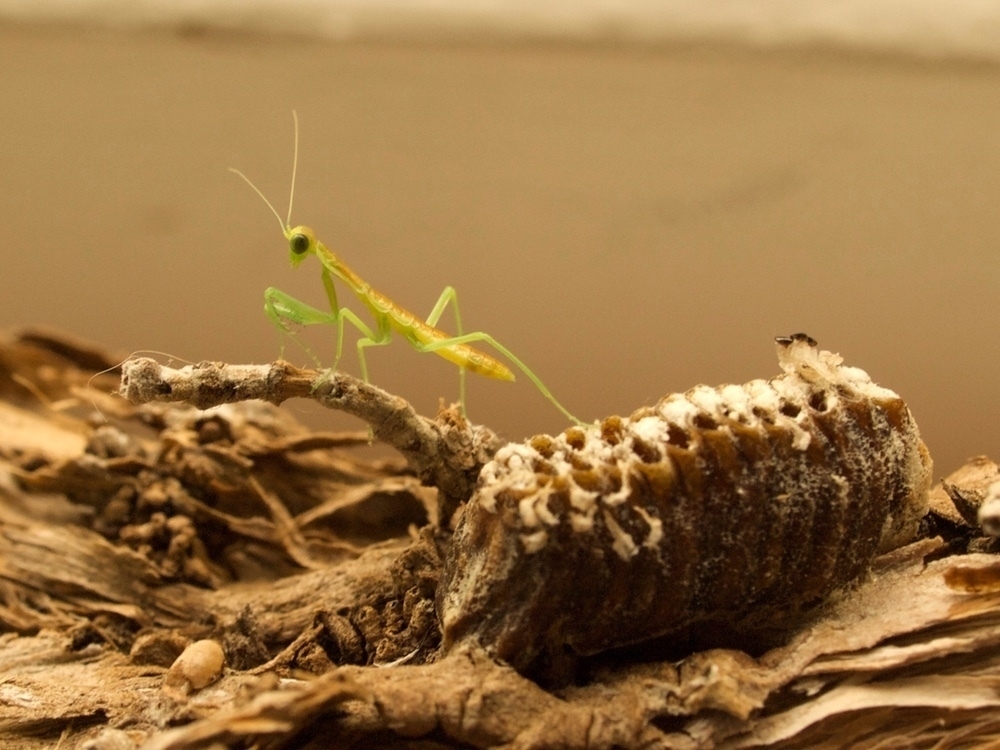
On Thursday when the blind was rolled up for the morning the sill was aswarm with about a dozen little mantises. Two got squashed flat in the roller blind, where they remain (I must get them out of there), but R. and the girls released the rest outside.
They noticed a colour change occurring: when newly hatched, the mantises are a sort of translucent green; but over a couple hours they darken up and gain their juvenile brown stripe down their back.
On Friday: another six new mantises, and the girls took three each to school to show their friends and release there.
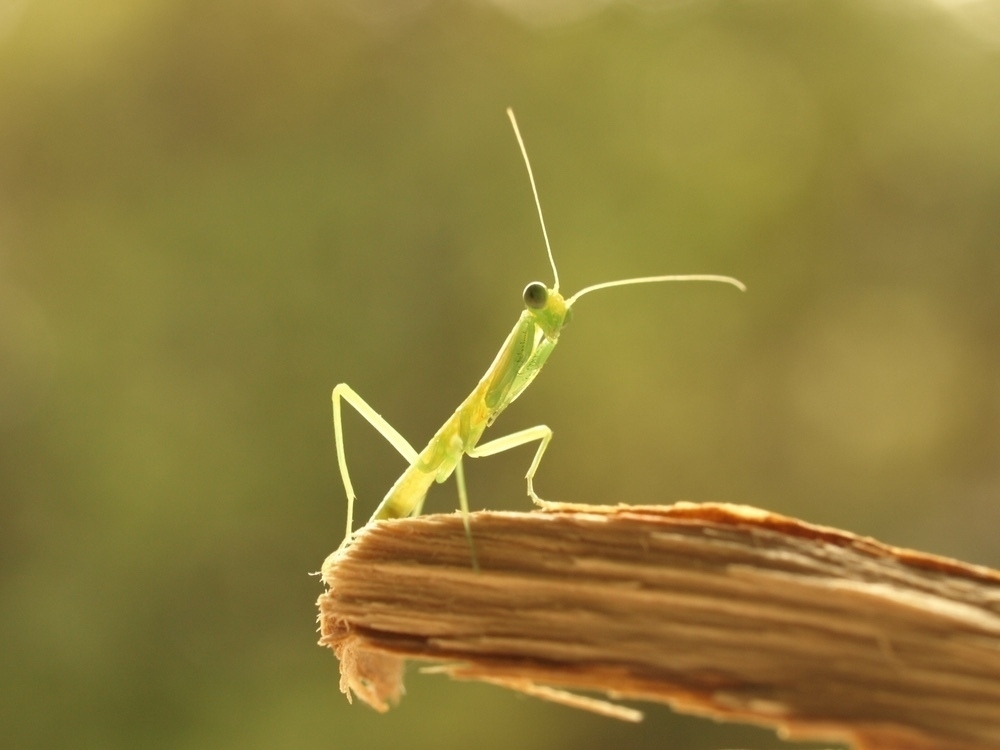
On Saturday: another six or so. One problem we didn’t think about with having the windowsill as a hatching space is spray residue from years of using flyspray there, not that we use much of the stuff. Worse was when they dropped to the floor by the french doors, a well used ant pathway and consequently fairly heavily sprayed by us over time. Any small mantis wandering there we would see die in about half an hour. Not so good.
Also problematical indoors: our other wandering fauna. At the moment there is a large black armed jumping spider roaming the area, who would like nothing better than mantis for breakfast. Not to mention the inevitable Pholcus that seem to be impossible to get rid of.
So I gathered our babies up fairly quickly and took them outside.
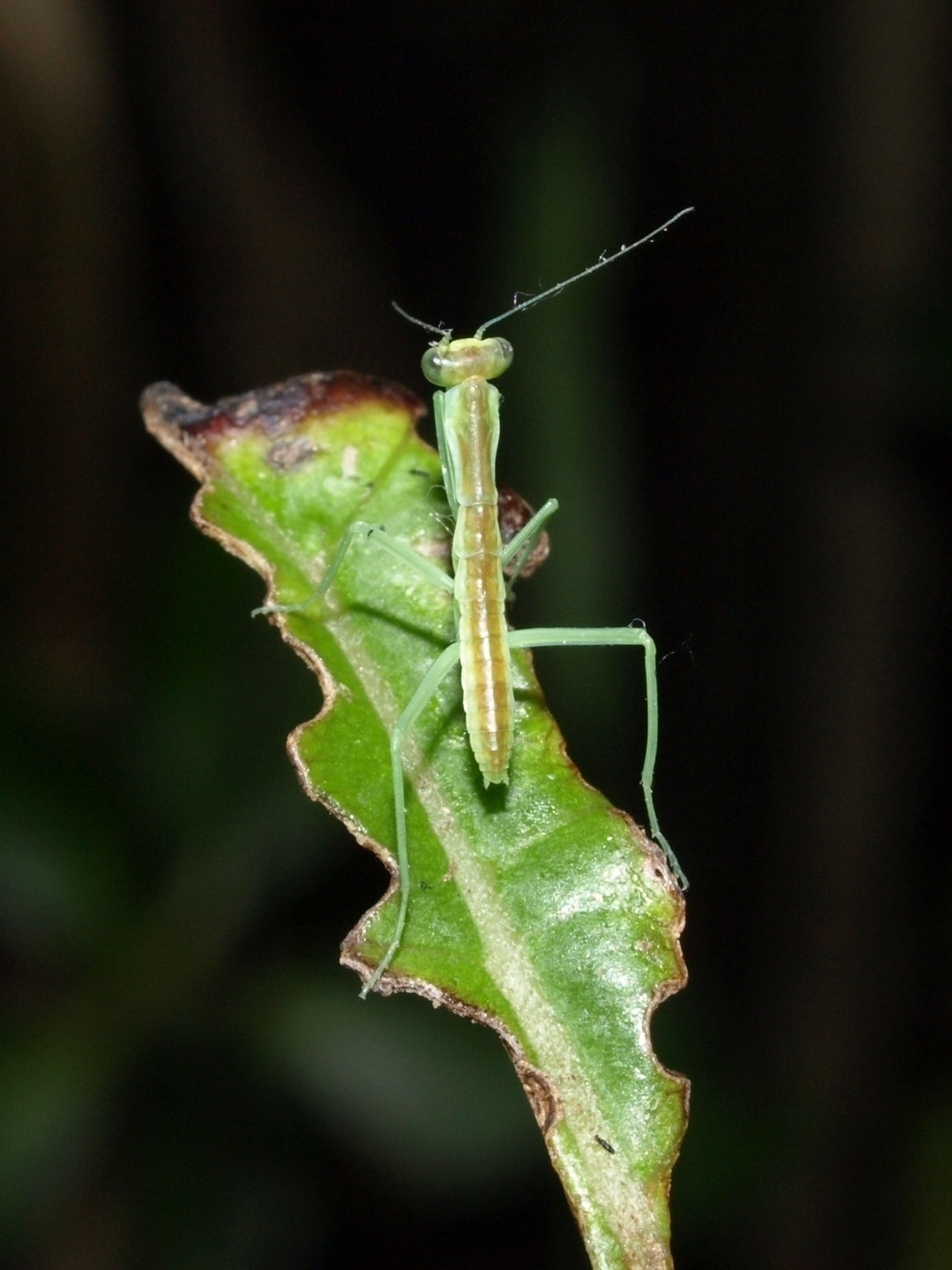
On Sunday: no new mantises. But today, there were another fourteen. These too, are now outside. Not that outside is any safer for them, but at least there’s no flyspray there.
The ootheca looks empty now. But I’m still wondering how so many managed to be packed in there!
The workers we have in our garden at the moment have hairy arses.
Not through some horticultural equivalent of builders' crack, but because that’s just they way they are:
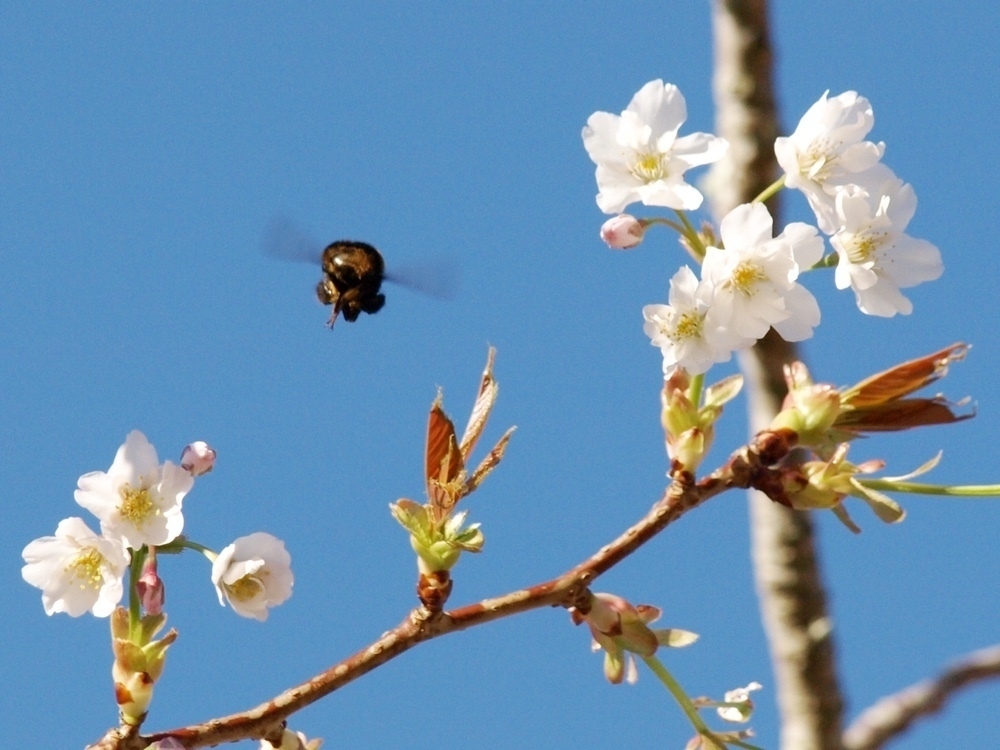
I should be out digging over the potato patch or something. But hard work is always best observed rather than partaken of. So I have contented myself with taking a few photos of the workers instead.
We seem to be having another early spring here, with the cherry tree in full blossom a week earlier than in 2005 and 2006.
This picture was taken this morning:

I really like how that particular tree, which dominates the view out our front window, really marks the passing of seasons for us. In spring, it flowers beautifully, keeping the tuī, waxeyes, and sparrows in high energy good-lovin' food; in early summer it fruits, providing plenty of meals for kererū and blackbirds; throughout summer its leaves provide us cool shade for the paddling pool; and in autumn the colour of its leaves warn of winter to come. And in winter, it is bare, letting past the maximum of sun and light to the house.
Yes, I can wholeheartedly recommend a large flowering cherry as a useful garden plant. And these guys would recommend it too:

Previous springtimes:
That’s the word of the day. Ootheca.
After we got back from lunch I happened to be flicking the fallen leaves out of the car’s gutters when I saw a praying mantis down in the gutter between the back window and the boot lid.
It turned out to be a female creating (what is the right word here?) her ootheca. (It seems to be the time of the year for it - here’s my one of a few years back.)
I got R., the kids and their grandparents out and we crowded around for a closer look.
She was extruding a foamy meringue-like substance that actually looked rather tasty (I’m salivating thinking about brandy-snaps right about now):

The whole process took about an hour, and afterwards I got her to model for a photo or two before releasing her to the sanctuary of a nearby walnut tree.
Meanwhile, we now have an awful responsibility. What are we going to do with the ootheca? It will eventually pop off the flexible rubber seal that it’s been laid on, and will be washed away by the action of air or water. I can’t bear the thought of all those lovely mantis babies being lost.
I guess we’ll just have to peel it away tomorrow, once it hardens, and keep it safely in a jar until hatching time. Could be interesting.
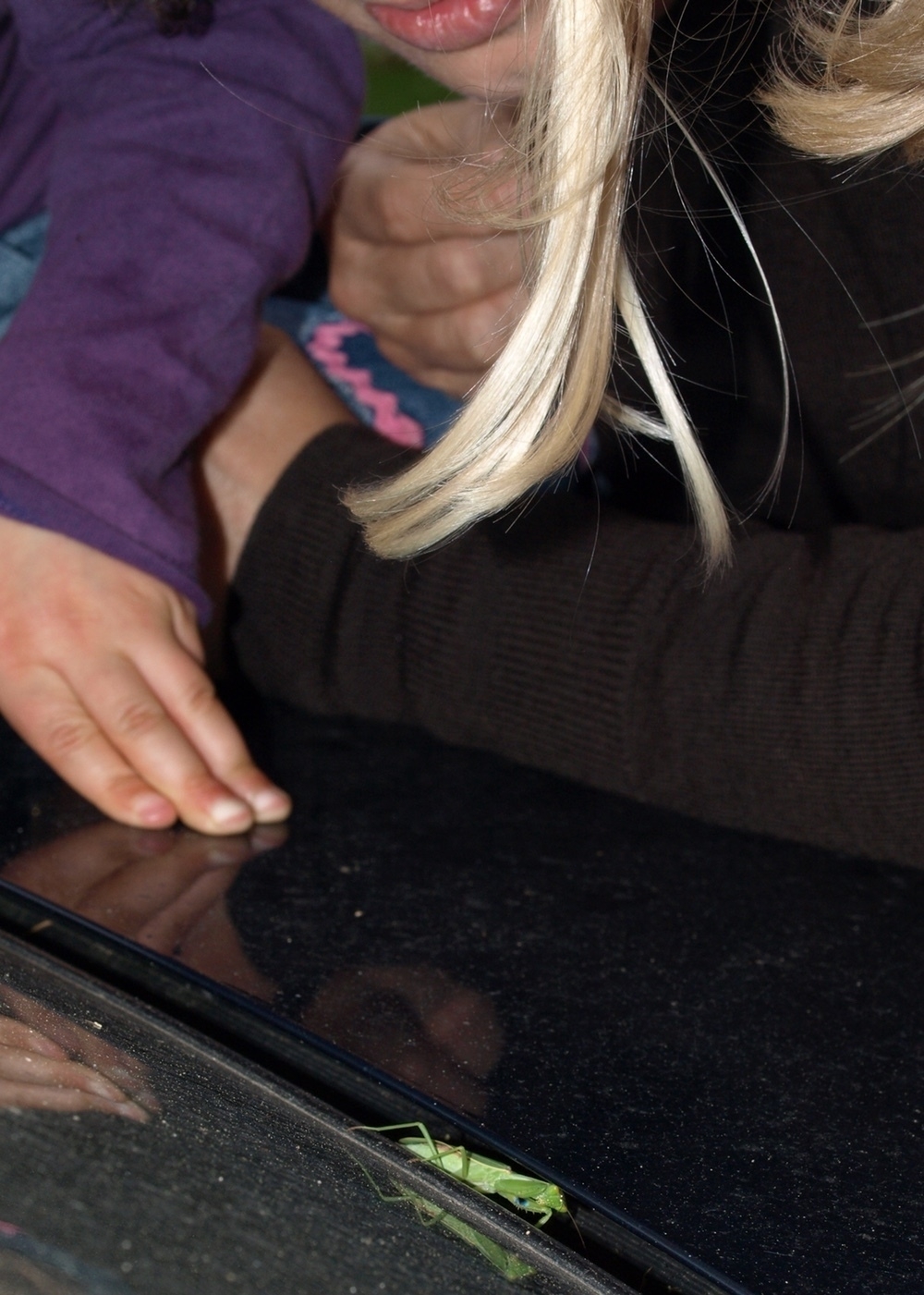
I needn’t let all that listening to Morrissey get me down, as I can always find a friend:
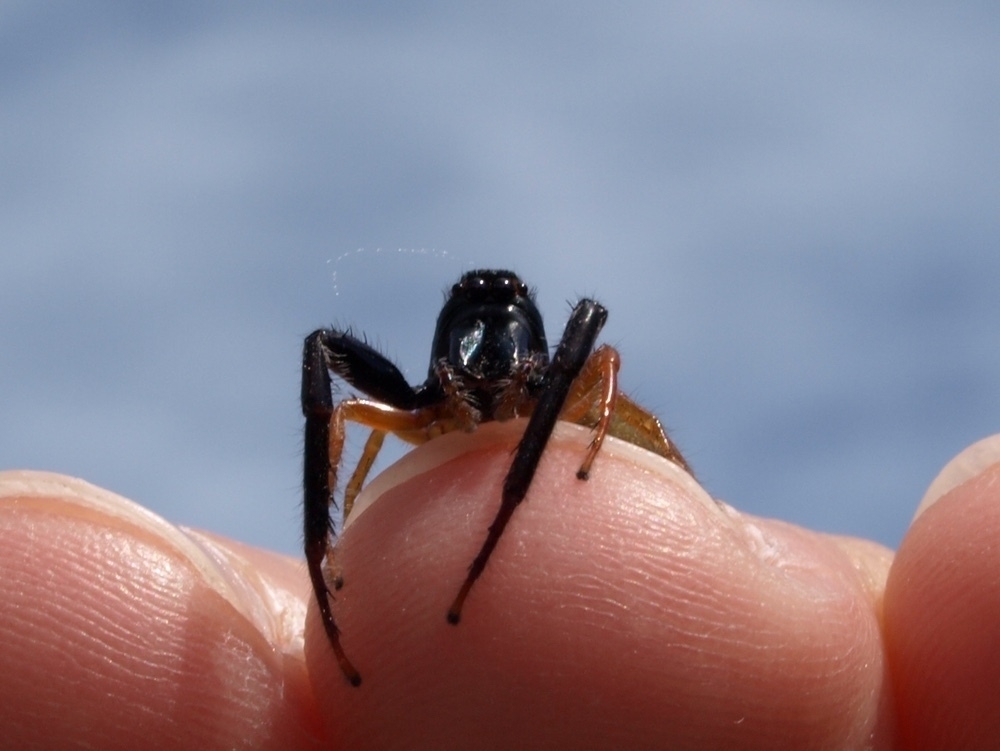
I have of course had many photos and blog postings of these ones before - they’re quite common in Wellington and, like this one, the males will often wander inside at this time of year.
It’s Trite planiceps, a species with a number of common names usually referring to the blackness of the “arms” and “head”. They’re completely harmless; rather fun, and not at all concerned by people. This one was quite “happy” to jump on to my hand and be photographed.
If only all spiders were like this.
And eventually I will come up with something else to write a blog posting about.
Today’s spider comes to us, once again, from my girls; B₂ this time, who found this lovely green crab spider hiding in a hebe flower spike.
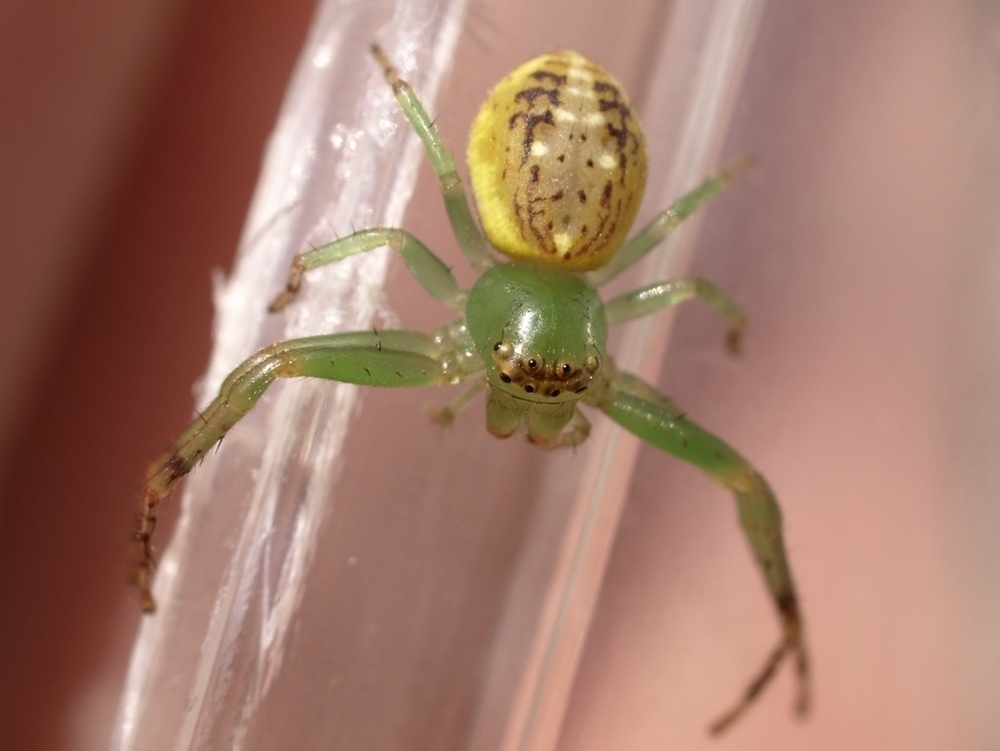
It’s some species of the Diaea genus, and they’re pretty common too, although not often seen. Apparently all you need to is lay out a white sheet under a shrub and shake it vigorously, and out of all the assorted beasties falling to the ground there should be some of these.
Or, of course: have a pair of apprentice amateur arachnologists on the case finding photogenic animals for you. That’s even easier.
Today’s wee beastie comes courtesy of my girls, who were amusing themselves tossing small pinecones down the steps away from the house when they found this very nice spider (“Dad! Dad! Come and see this cool spider!"):
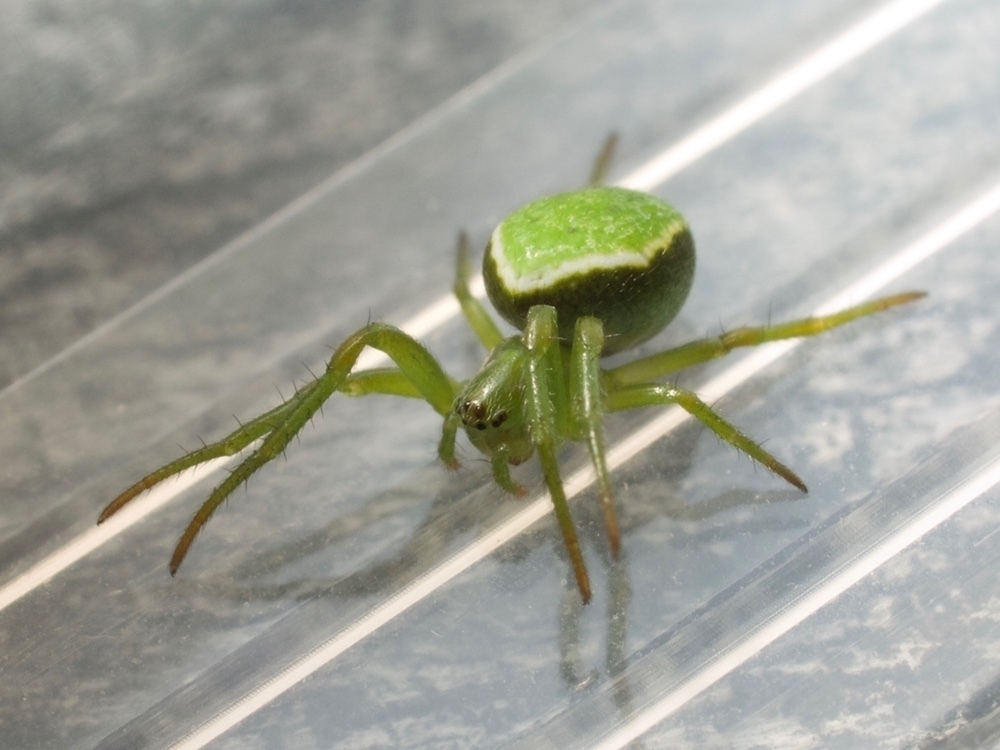
It’s a fairly large, as far as they go (maybe 6-7mm) specimen of Coloaranea viriditas - a reasonably common little orbweb spider that comes in an array of colours apparently (although I’ve only ever seen this green variety).
I really should have another look for some more of the rather spectacular, though tiny, flower spiders though.
This is the time of year that I usually post some photo or other of the flowering cherry on our front lawn. This year though, the blossoms are looking a bit thin, something I put down to the crap weather. So no photos thus far.
But then we noticed the sparrows attacking the blossoms. They seem to be snipping the blossoms near their bases, presumably to get nectar. This is new behaviour for this year, at least around here, and I wonder where they got it from? Maybe they copied the tuis, whose longer beaks allow access to the flowers without damaging them?
Unfortunately, the sparrows have created quite a bit of damage, with most flowers now looking like this:
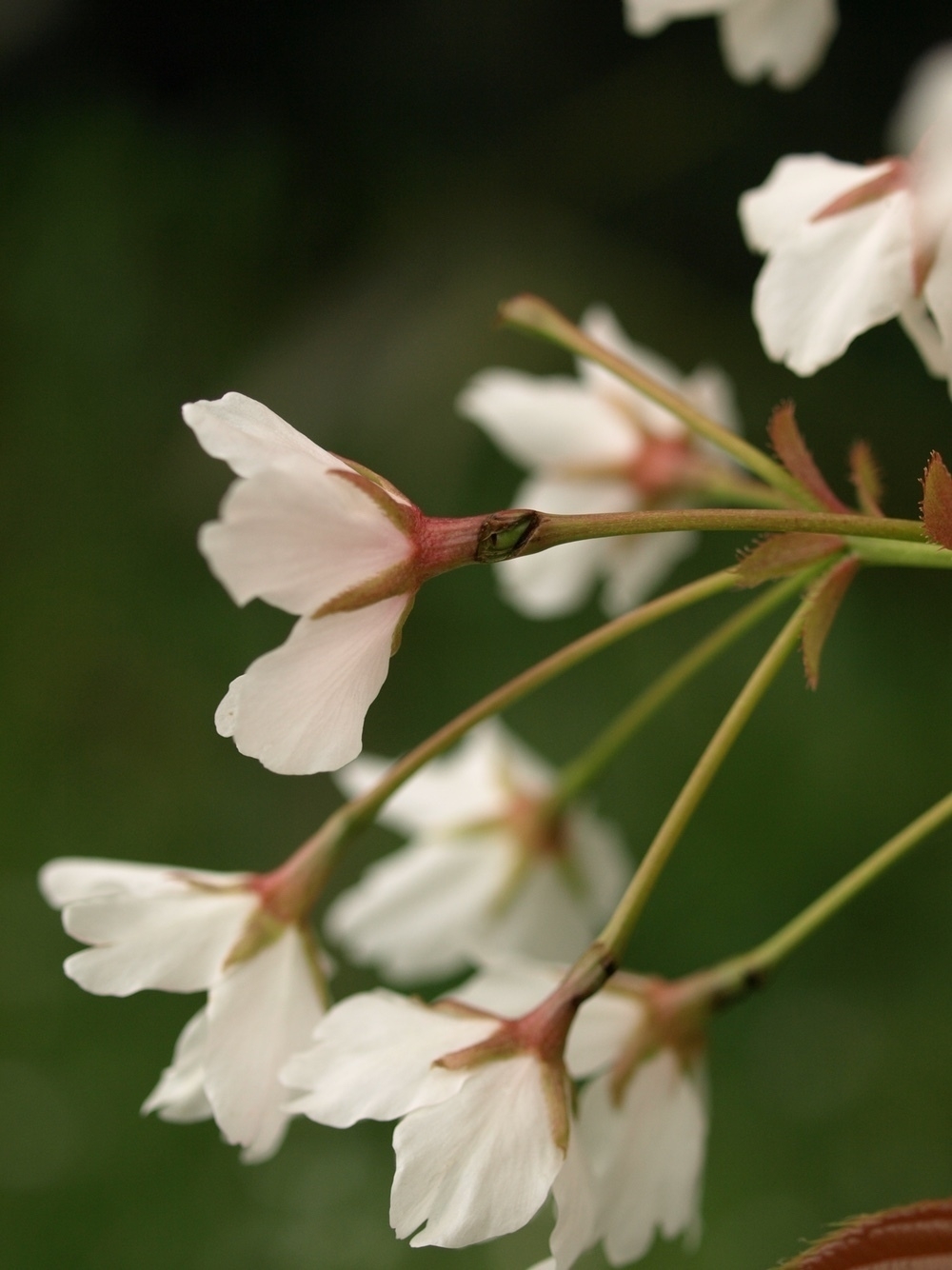
Worse, many of the flowers just drop on to the lawn. I’m getting a bit concerned that our favoured tūī will miss out; and later on, in November, the kererū won’t have any cherries.
We can chase the little blighters off, but half an hour or so they’re back: a little flock of avian destroyers.
I want to KILL them ALL.
Or… maybe there’s a whole new export industry there in the making: once we catch them, we can export them to China.
Seeing as how we probably won’t be sending much milk powder there in future, an alternative export opportunity right now probably wouldn’t go amiss.
Previous springtimes:
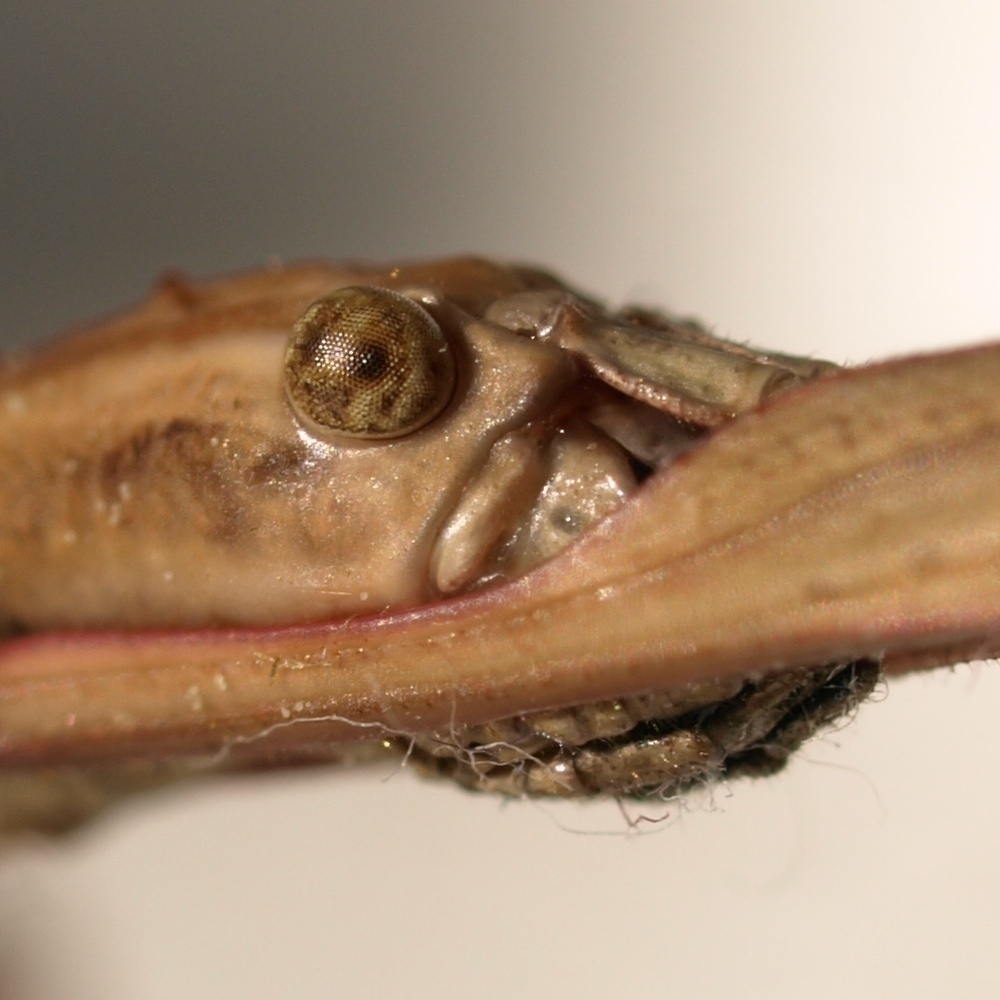
So this poor beastie wandered inside, and had gotten lost in the hallway, its claws collecting the dust-bunnies as it skittered across the wooden floor.
It was very large for this time of year - the body alone being around 12cm with the legs adding considerable extra length.
After getting it to model for me I took it outside and placed into the cover of our most expansive and indisciplined rose bush, where hopefully the beastie will go forth and multiply.
There are at least another two varieties of these to be found locally - this brown, and the similar green being most common, with an outrageously spiky brown also to be found. I shall inflict these on you as the opportunity arises…
I like spiders. I don’t know why. Maybe it started because I knew my mother hated and feared them beyond almost anything else… and to a small boy that’s a pretty good recommendation.
The variety of spider I remember the most from the farm were flat and grey and lived in the cracks in the old and weathered fence posts between the lawn and the cow paddock. They were always there when I went to look for them, especially on sunny days, but they were sufficiently cryptic to escape the notice of anyone else. I felt like they were all mine.
So you’ll be pleased to know they’re up here in Wellington (and further north too), not that they’re super-easy to spot. They’re called Holoplatys, according to my spider book, and I took a blurry photo of one, like an eight legged bigfoot, late last year on the fence around our deck. It was perfectly camouflaged, and it darted away before I could get a better shot. I hadn’t seen any here before, and I hadn’t seen any more… until today.
Later this afternoon it actually got warm, as the southerly died down and the sun shone. I opened a window, and there it was: a Holoplatys. I caught it and put it into lid of a plastic bowl. Which it tried to get out of immediately.
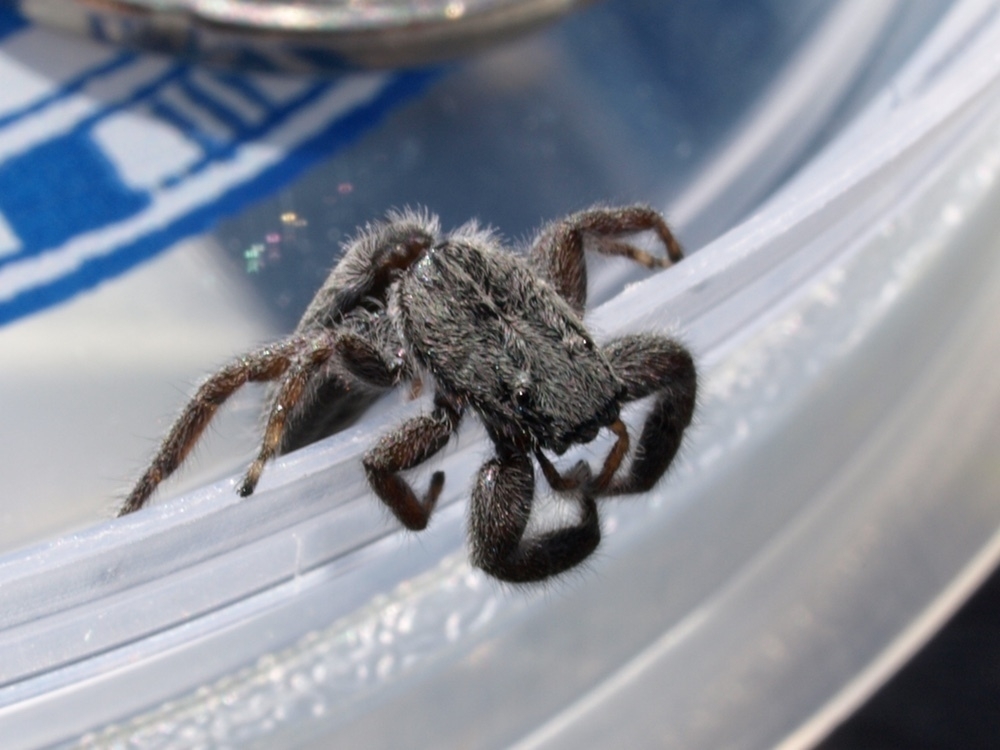
As you can see, they have dark bodies, but in addition their camouflage is provided by a thick covering of grey fur that renders them the same colour as weathered wood.
And according to Forster & Forster, these spiders exhibit a behaviour called thigmotaxis, an urge to have both upper and lower body surfaces in contact with with something. In other words, they like to sidle into cracks. So if you pick one up, it’ll try and squeeze between your fingers:
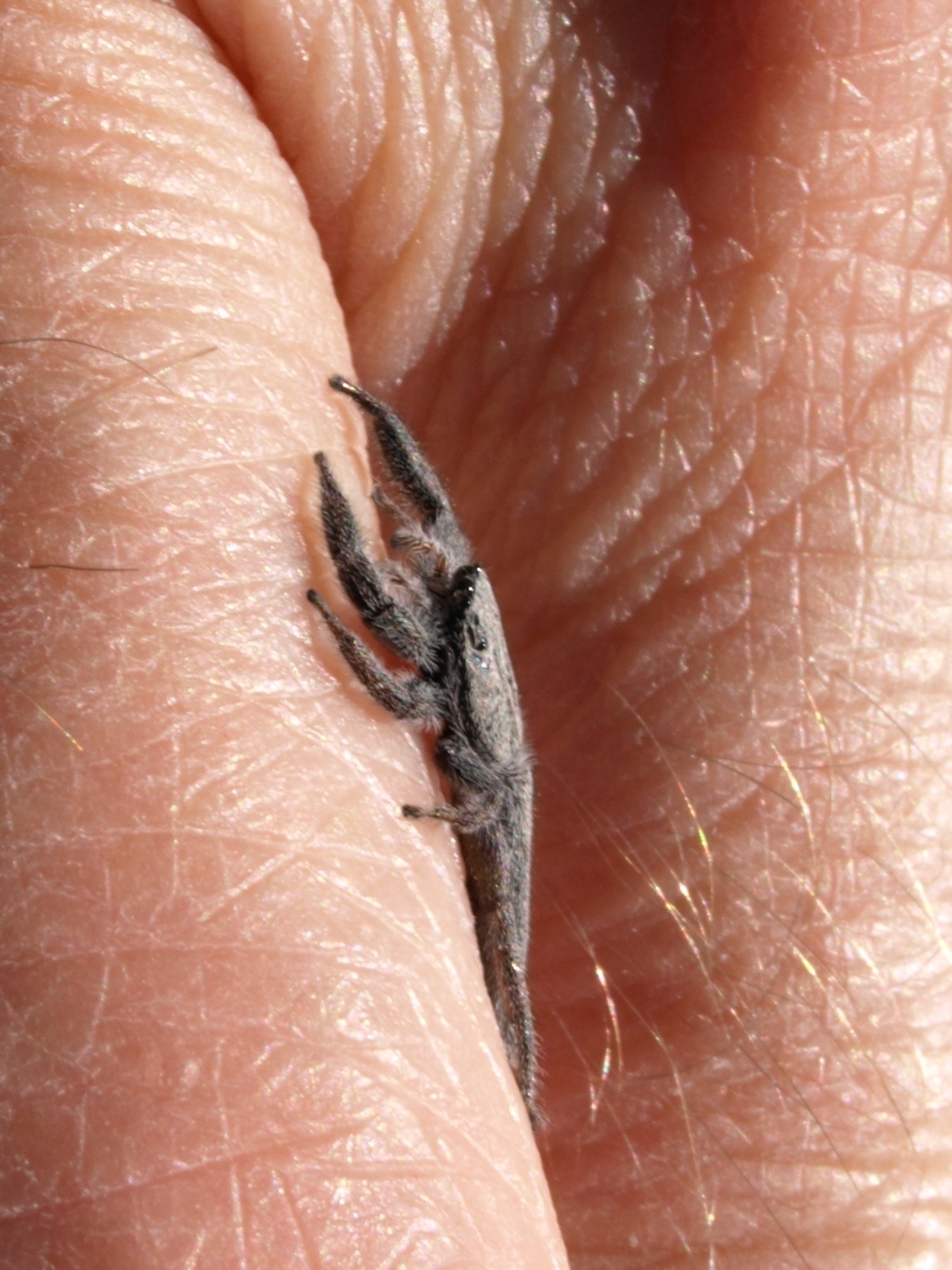
How cool is that?
Next thing would be to look for the brown variety that lives in the flax. Apparently.
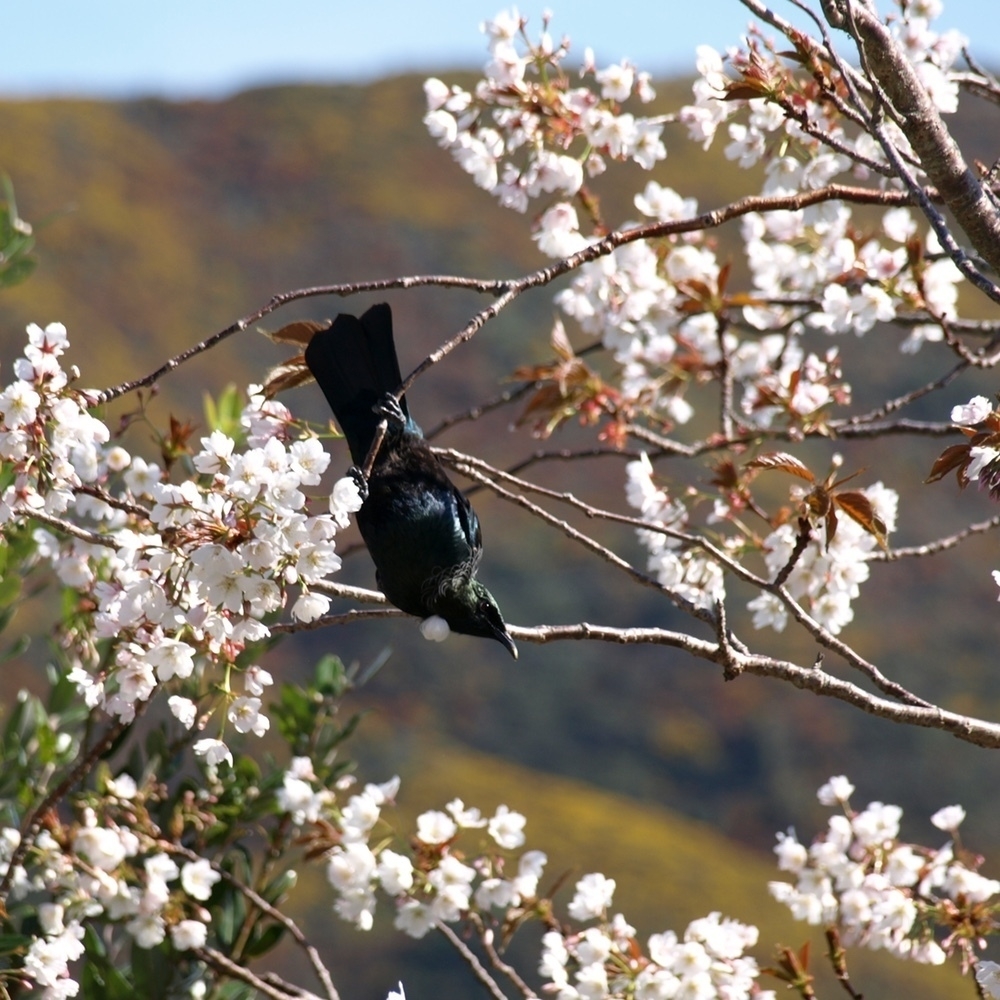
Previously:
Almost by accident, as I was trying to photo a tiny wild orchid growing on the retaining wall behind the house, I spotted this:
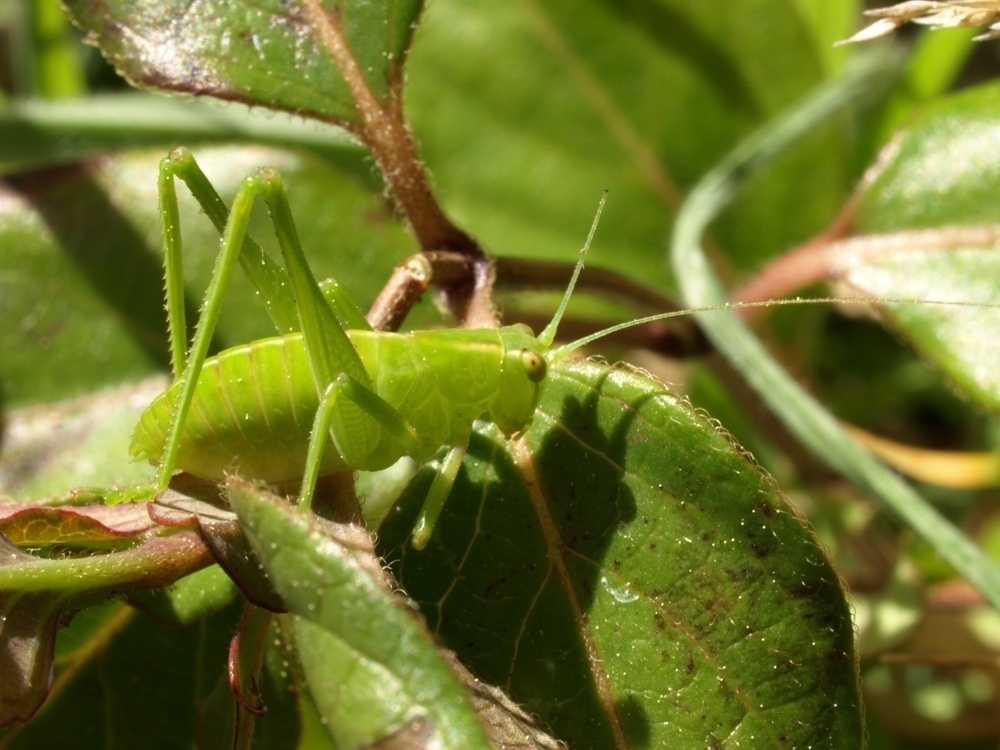
It’s not a normal cricket - those would have long gone before I could have thrust the lens into its face. No, I think it may be a juvenile katydid. They seem to have a cow-like equanimity that allows them to be photographed easily.
Those yellow dust flecks you see? That’s pollen from the large stand of pine trees a couple hundred metres to the north of us. Great, eh? It’s everywhere at the moment.
And so when will I see a stick insect? Or a mantis? I guess we’ll have to get through spring yet.
We’d been keeping a lookout for more blue moon butterflies… but without success. We are three weeks later in the season than when we were here two years ago, and maybe all the butterfly debutantes have already come out.
Instead though, we came across one of these pretty things, which I have not noticed in Wellington:
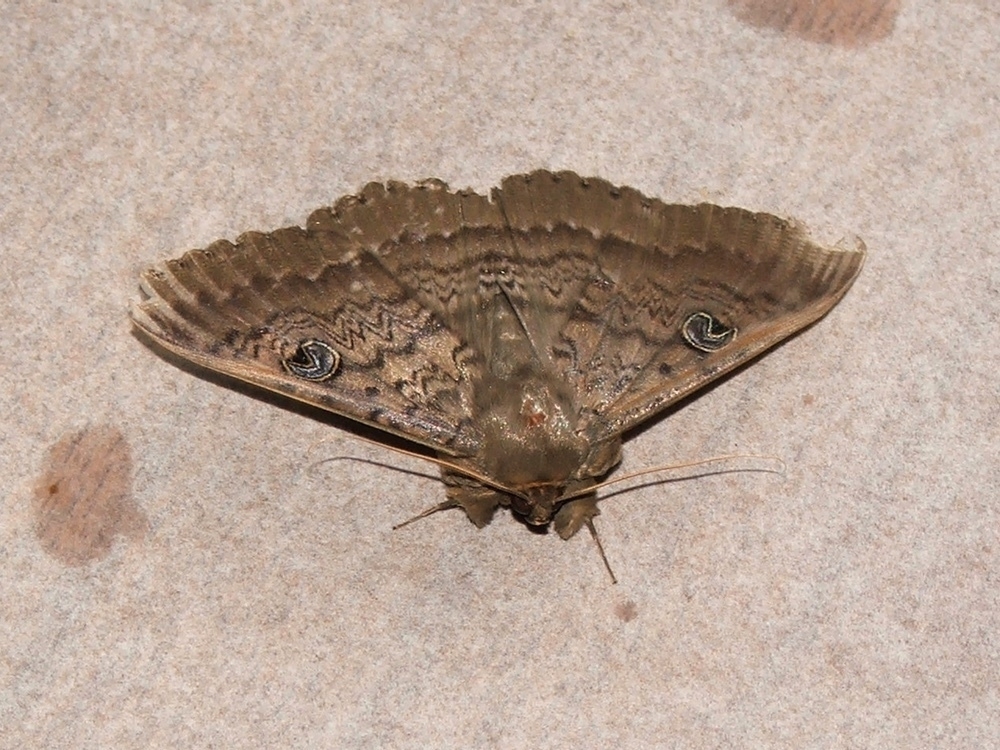
Or rather, it was attached to the wall in the girls' room last night and I had to get it out before they’d consent to even try sleeping in there.
It’s a wattle moth, also known as a moon moth on account of the eyes on the wings (according to B₂, reading from Andrew Crowe’s the Life-size Guide to Insects).
Those girls are quite the entomologists, these days.
Favourite spider family, that is. Salticids are more commonly known as jumping spiders.
Like this chirpy little chappie:

R. found him(?) this afternoon on the last of our variegated flaxes and called me over to take the requisite photos. I’d not see one like this before: more slender than the black-armed jumping spider (Trite planiceps) that he most resembled, and having a bright orange head besides.
Checking it out later, my usual NZ spider bible (Forster & Forster’s Spiders of New Zealand) could offer no clues, although B₂ and R₂ thought it looked a bit like Aussie import Helpis minitabunda. I’m not so sure, as it didn’t really correspond to examples I later found on the web. Even so, our orange headed friend is the fifth species of salticid in our garden I’ve found so far. Fantastic!
Anyway, I took several photos, getting closer each time. The thing about these guys, is that they don’t always run away.
In fact quite the opposite, as this photo shows.
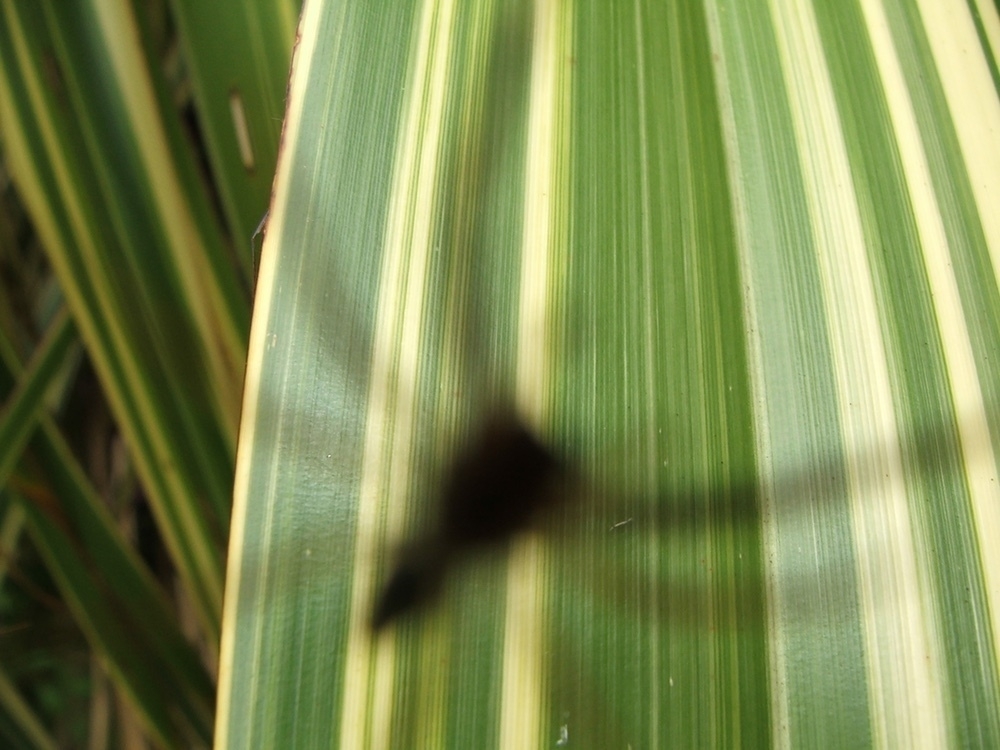
And it’s that sort of behaviour that is so endearing. Instead of running, many salticids wheel around to face any human approaching, presumably scanning for anything resembling prey with their acute eyesight. That’s why you get so many face shots of salticids on Flickr.
Often, when they meet each other, they go through quite elaborate greeting rituals too. Particularly in the summer months, the males of the black armed variety wander about inside our house, occasionally bumping into each other and having a bit of a staredown. Always entertaining. I know I’m anthropomorphising, but it’s hard to avoid when encountering these spiders.
And lastly, they are relatively common. They’re among the first animals our daughters ever took special notice of (with both Trite planiceps and Trite auricoma having their own nicknames in our house) and as such can always be relied upon for some diversion on a slow day.
So keep an eye out.
At a slightly loose end this afternoon (through my own laziness really) I picked up the camera and headed outside. The nice thing about our garden, being a fairly overgrown and wild place, is that interesting beasties are always close by.
And now this:
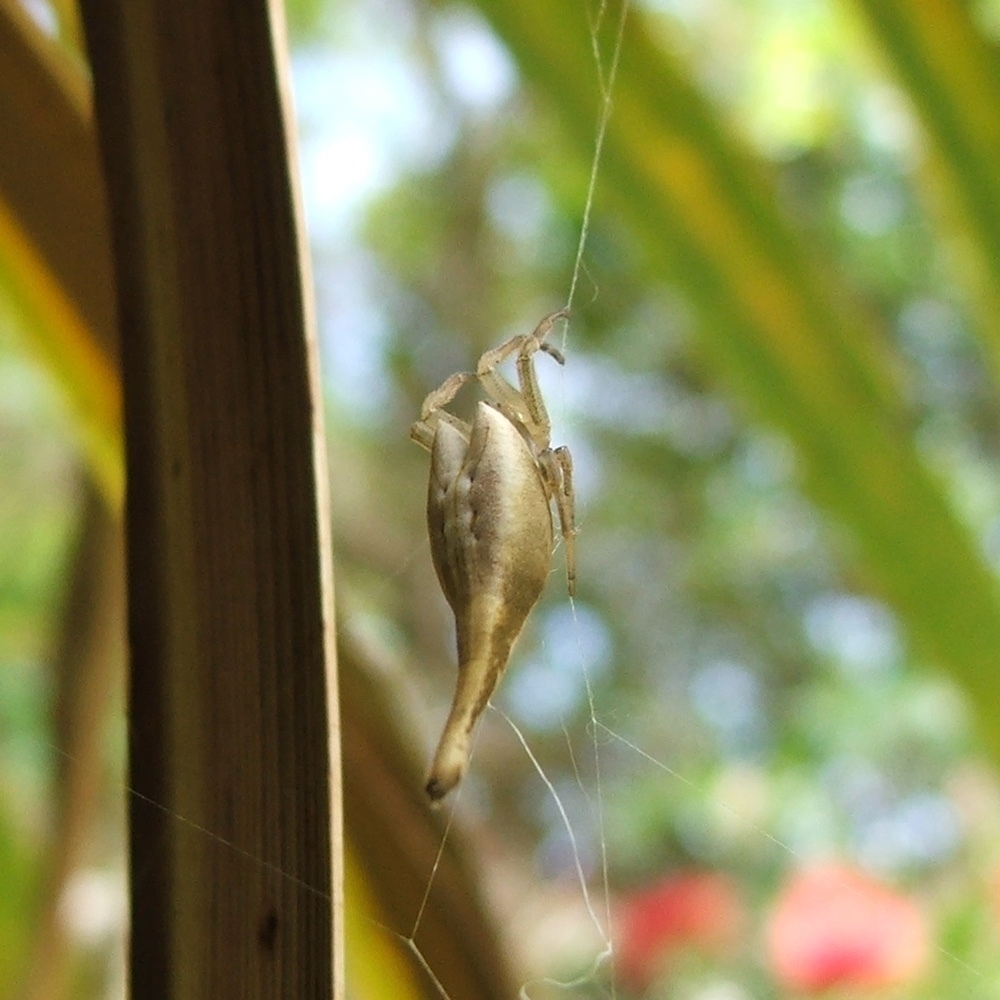
She’s apparently a tailed spider, Arachnura feredayi according to Forster & Forster. I’d never seen one before, except in the book. She was hanging off a tatty web on one of our cabbage trees. Just as described, she looked like a piece of broken twig or bark about a centimetre long caught in a web - until she moved. I picked her off her web. The strands were strong and very sticky, snapping with an audible pop.
Her tail was quite flexible and twitched away from my finger. Weird. I took her away to where I could photo her better, but the light was too bright (some sunshine! at last!). So back she went to her cabbage tree.
And once again, I learn that it’s a hard road taking the perfect spider photo. I suspect that no matter how good the camera, one would still need to take lots to get the good(ish) ones, as happened again today. There’s a lot I have to learn about capturing images of small things…
So there I was, charging out the lift doors on a Friday night, off home for a dinner, a couple beers and a good kip. Burger was already ordered, R. and the girls waiting in the car a couple blocks away.
Someone giggled nervously. A woman was looking at something on the floor, wriggling across the polished tiles. A lizard. A gecko, in fact. Lost in urbia, just like another wild life some time back.
I thought I’d better do something this time. I got the Kathmandu sale catalogue out of my bag, opened it up, and encouraged the gecko to hop on. I rolled it up gently inside, so it would be firmly held (and also hoping this would accord with its natural instinct to find some narrow place to hide in), and then went out the sliding glass doors.
Where to take it? The mean plantings up the side of the pathway to The Terrace would not sustain a lizard’s life for long. And it would too easily get lost again, far (in small animal terms) from a decent sized habitat.
I’d have to go for a little walk.
And so over the Terrace, down the side of the motorway off-ramp and under the motorway to the other side, where a steep scrubby bank lay. There, perhaps, the gecko could find a place to live.
I gently unrolled the catalogue and let the lizard out onto a steeply inclined wall of stones. It lay there. I remembered my cameraphone:
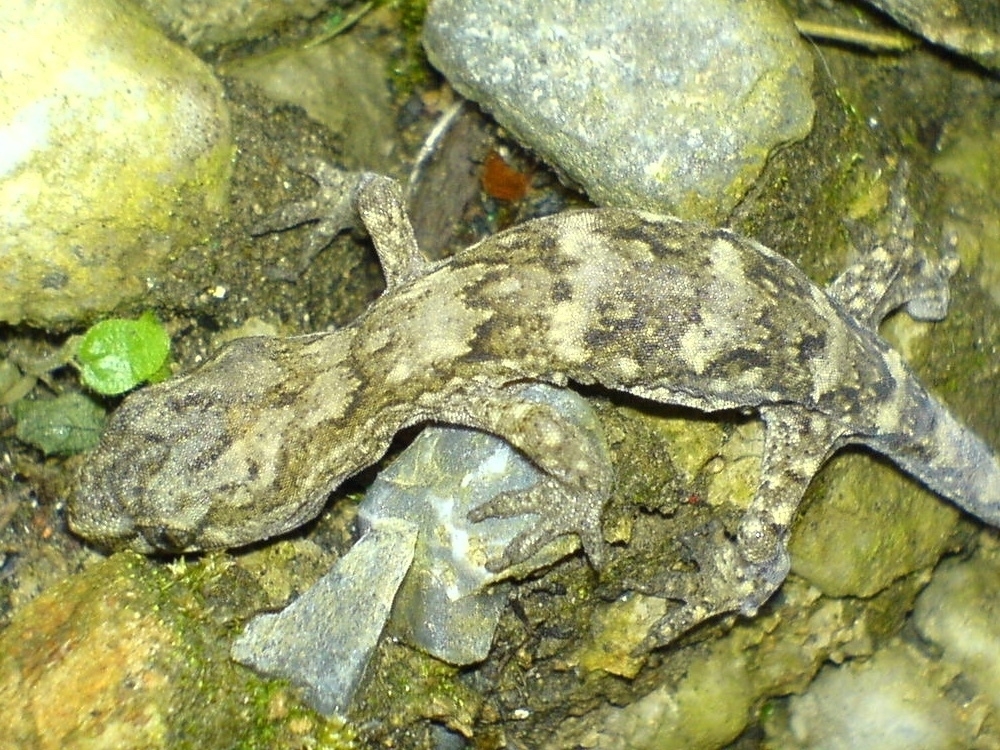
It sluggishly moved away, up a little. I thought I’d better leave it alone. I turned and walked away, people looking at me strangely on the way to their cars.
It was a nice way to end the week.
I have had this habit of posting a photo from each year’s blossoming of the cherry tree on our front lawn. This year is no different. And, I am actually quite pleased with this shot, with the dark fern fronds making quite a good background:

My attempts to catch (photographically) some of the tui that are swarming the tree have been less successful. Every time they see me, they bugger off.
Previously:
The blossom seems quite a bit earlier this year… but maybe it hasn’t fully come out yet.
It came in with R., after she’d hung out some washing: the largest of these we have yet seen.
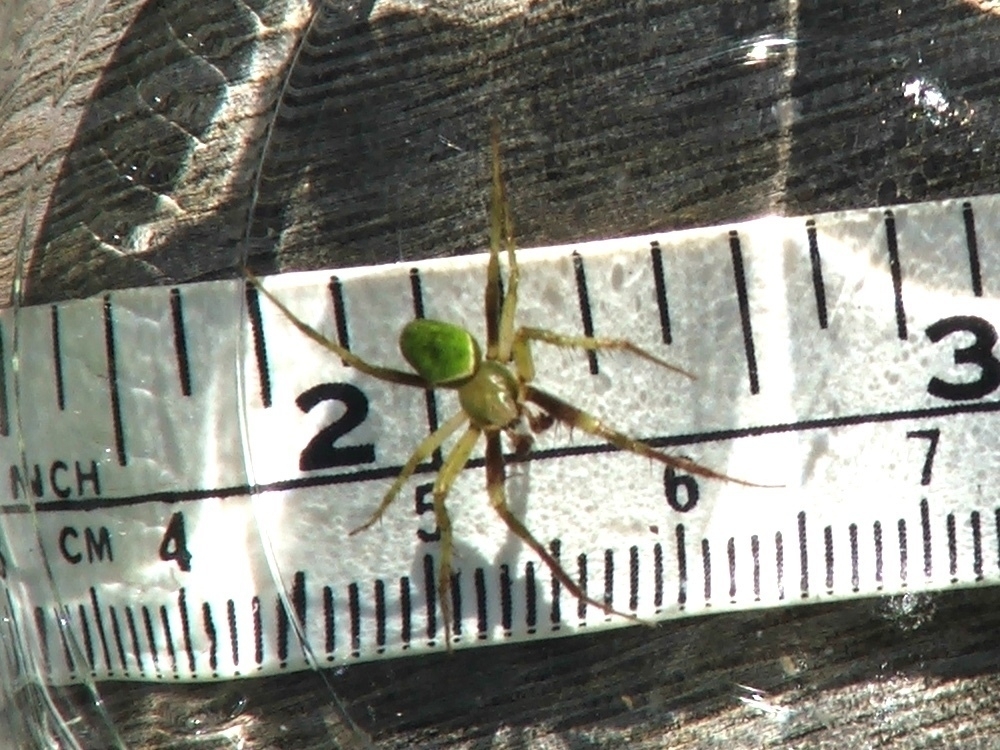
Once again consulting Forster & Forster I found it was an orbweb spider: Coloaranea viriditas, a very poetic and appropriate name given its colour. Supposedly quite common, although who would know: it’s not an easy one to spot.
I wanted to take a decent photo of it, but the damn thing moved too quickly, much too quickly for my clumsy attempts at manually focussing the s5500. Even putting it in the fridge for a couple hours didn’t slow it down much.
So here’s a best of a bad bunch: a somewhat contrived arrangement of a green spider on a red (and probably dead) succulent.
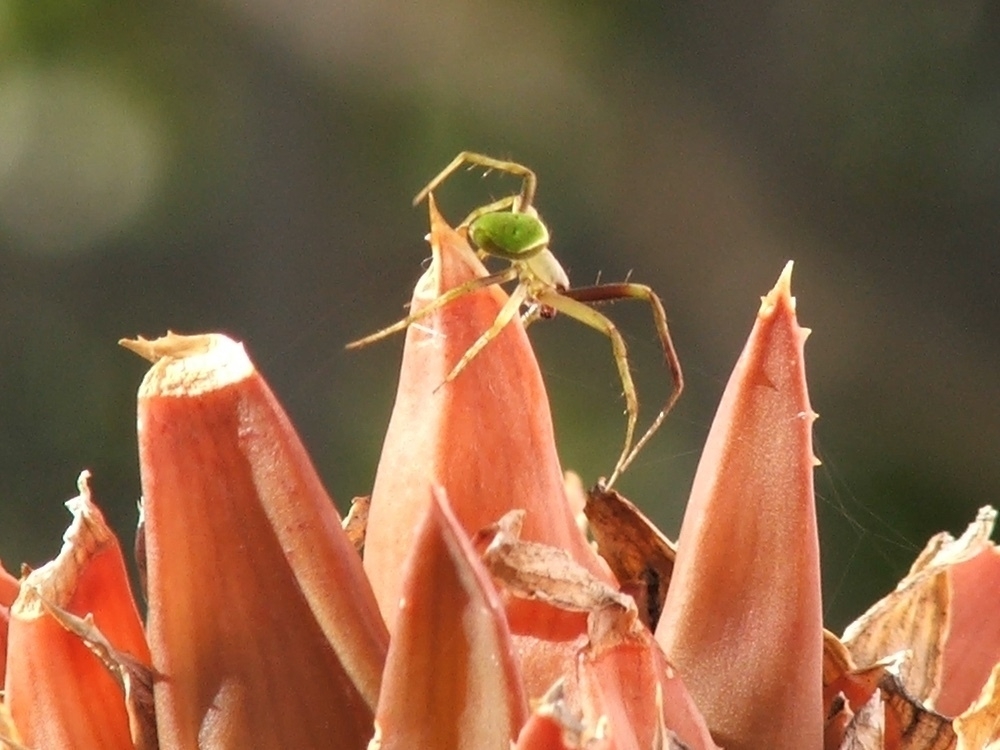
Roll on the day when I get hold of a digital SLR with a decent and speedy macro system…
Four weeks ago to the day, the girls and I watched as a monarch caterpillar transformed itself into a beautiful chrysalis.
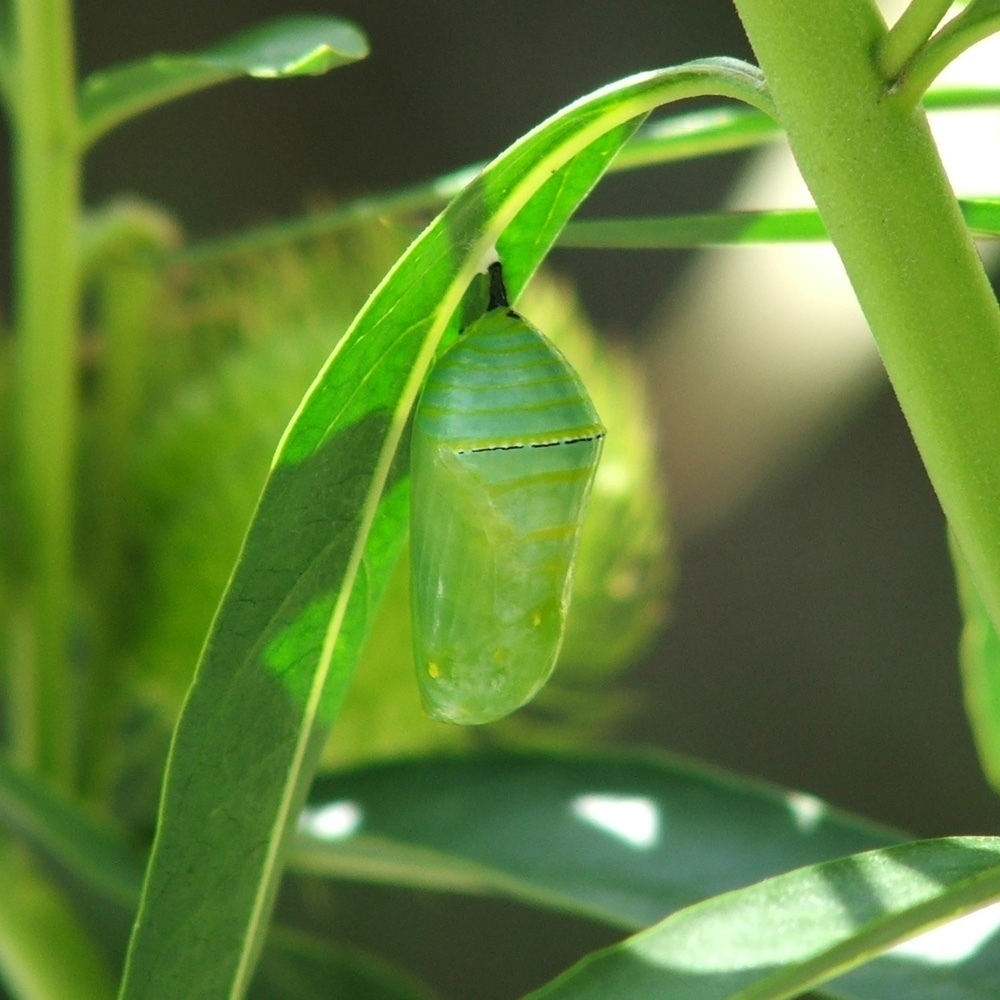
Most of the sources on the web talk of the chrysalis stage (or pupation) taking nine to fifteen days (with some of the New Zealand sites stating nine to twenty-one days). Last weekend, after three weeks, I feared the worst. Especially after reading the tragic story of B₂'s friend Hazel’s caterpillar.
Fortunately, during last week the chrysalis started changing again, darkening up and eventually this morning becoming obviously ready to open. Fantastic timing, being Sunday and therefore I would be around all day to capture the happy moment, like some over-enthusiastic father in the birthing unit.
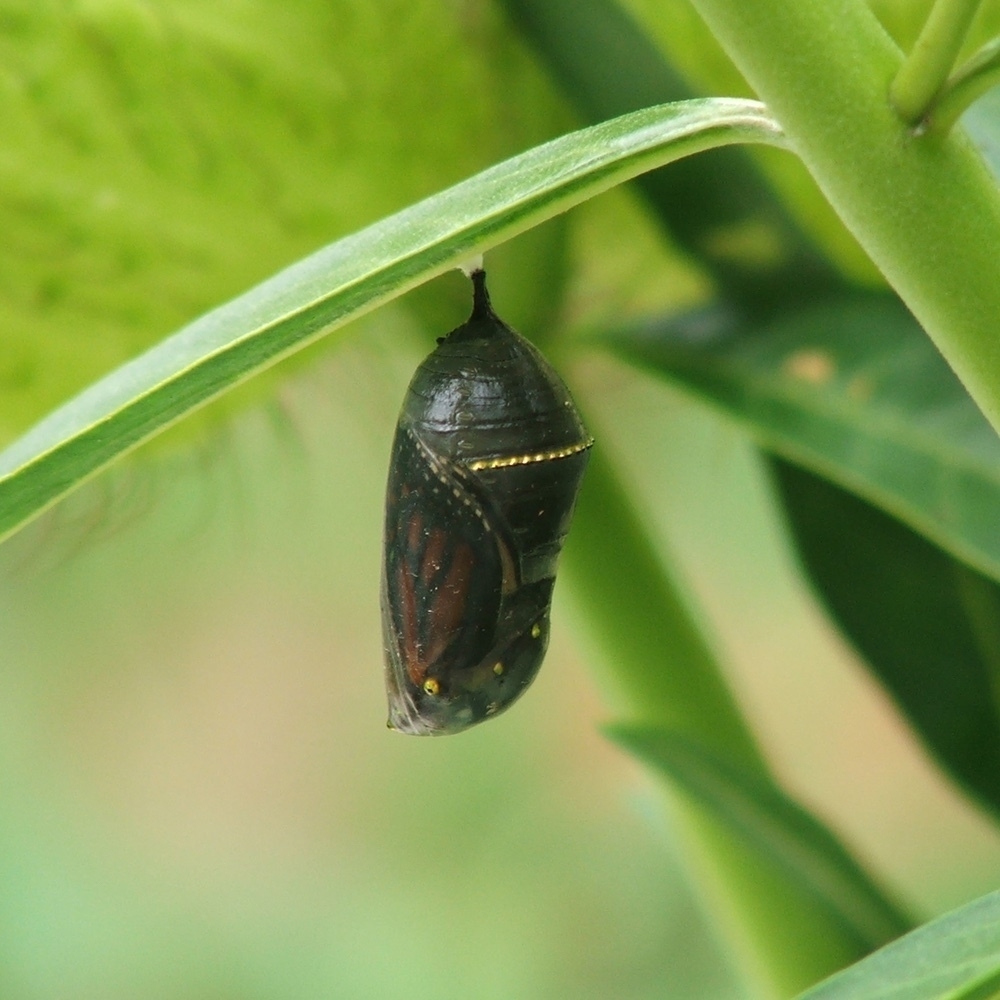
Unfortunately though nothing happened. Well, not for a long time. Every 15 minutes I would take a look out the window. Nope, no change. The sky grew overcast and dark; the air cooler. Nothing would happen today. I’m guessing that they are fairly temperature dependent: with an unhurried 28 day pupation what’s another day inside their chrysalis?
It was while I was making afternoon tea for the girls and R. that something made me check out the window again.
Bugger.
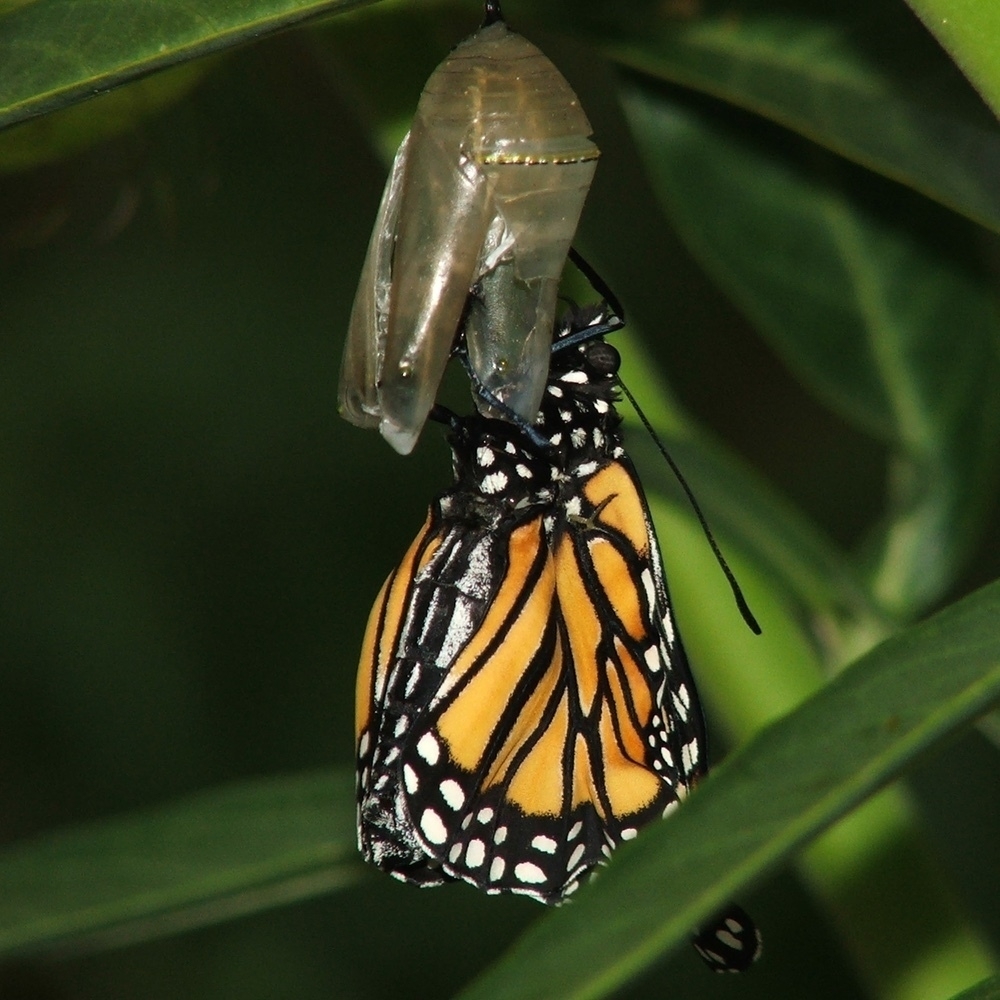
I was too late. It had emerged not too long previously though, by the look of it. You could see its fat body, still full of liquid, busy pumping its wings up…

Just a few minutes later the wings are almost fully extended…

And then in another 10 minutes it looks ready to go:
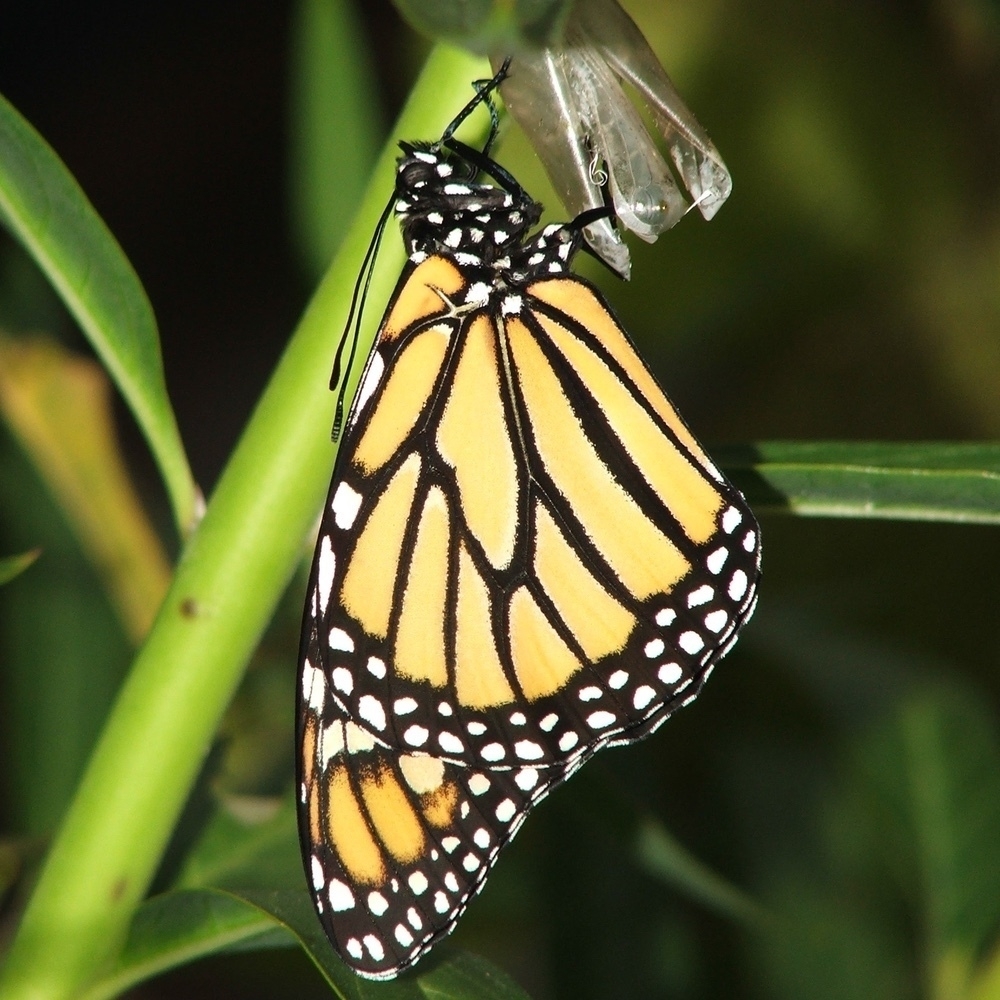
But of course it didn’t. The last one we had stayed where it was for the better part of 24 hours before flying off. And shortly after I took this photo, it started to rain.
It’ll still be there tomorrow, no doubt. Then it’ll flutter off to find its one and only late season doomed love, any offspring condemned to die of the cold as winter encroaches on Wellington gardens.
What a cheery thought.
Now, is she not beautiful? Please, click on the photo for a really nice close up…
Just look at those velvety stripes…!
Reading the wonderful Forster & Forster reveals the interesting life of these spiders (Dolomedes minor). For five weeks over summer, the female carries a sac the size of a pea, full of eggs, around with her. Somehow she knows when the spiderlings are about to hatch, because at that point she climbs a nearby shrub to spin the nurseryweb around the egg sac.
Not long after, the spiderlings hatch. The mother stays around for a week or so to guard the nursery.
And by the second week both the mother and the spiderlings have gone, leaving behind just the tattered nursery web…
Last year, or maybe even the year before, R. planted a swan plant in her herb garden in the hope of attracting some Monarch Butterflies (Danaus plexippus). Which of course it did, and regular culling was required to make sure it grew unmolested for a full year so that it would be strong enough to support a population of caterpillars and still survive.
This summer we have four caterpillars on it.
Yesterday, we noticed two of them hanging from their tails, clearly ready to go into their chrysalises. At some point during a couple hours of us not looking, one of them did, and I was completely mystified as to how they did it. The shell of the chrysalis looked to shiny to have been spun, and in any case it happened too quickly for that.
So how do they go from this:
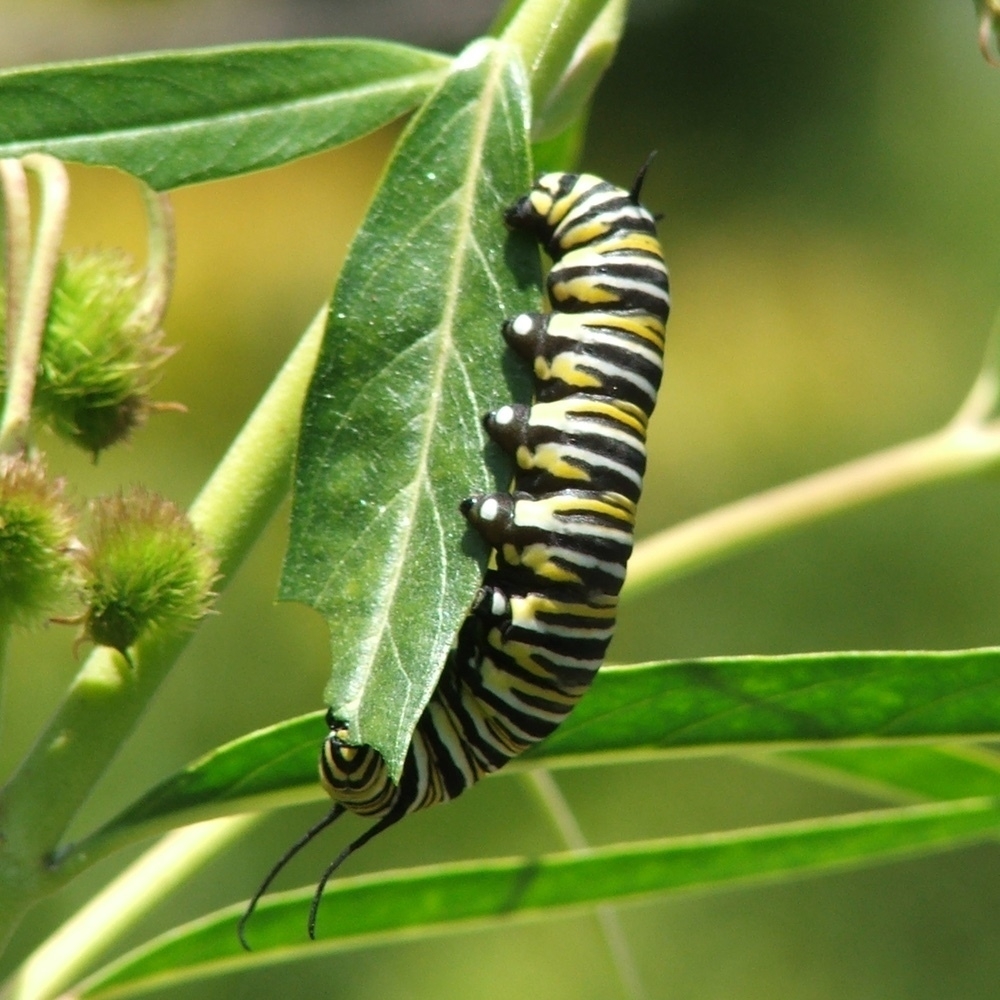
To this:
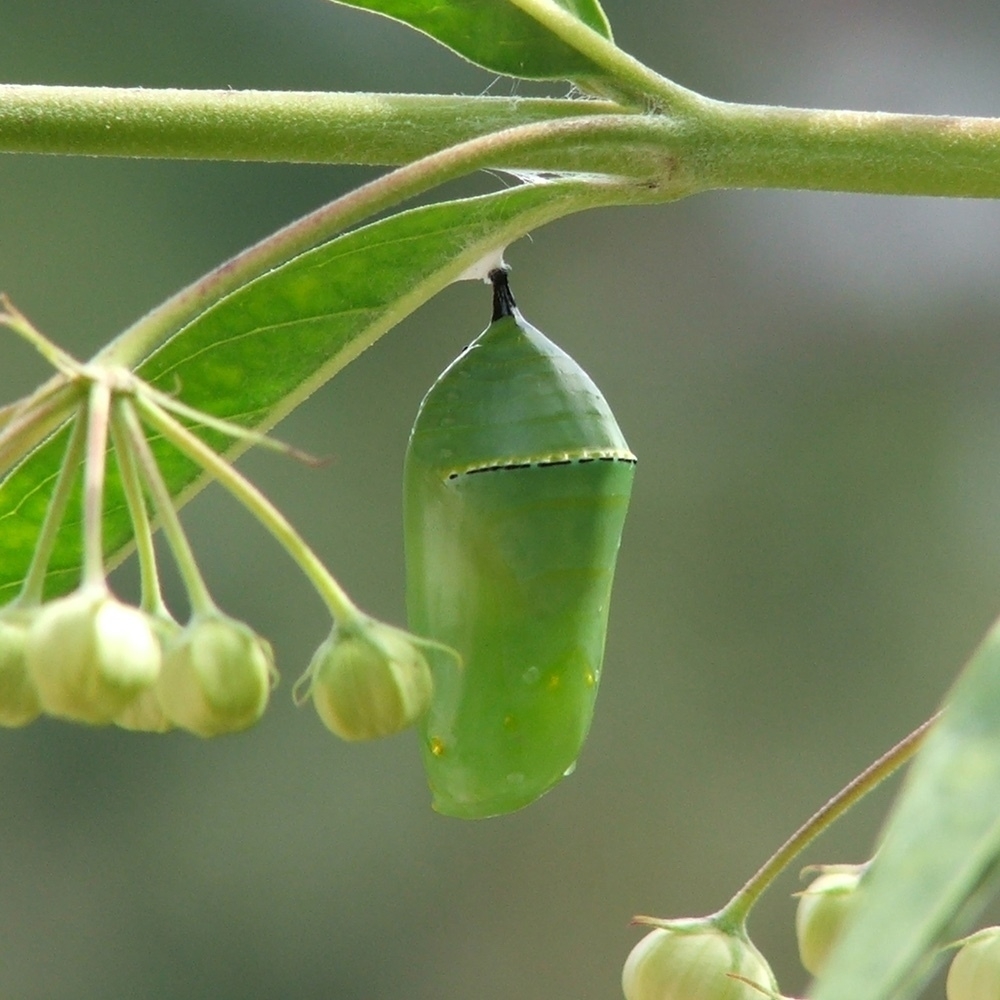
…in just a matter of minutes?
The girls and I found out this morning.
Just after 11am, I looked out the window and saw that the remaining caterpillar hanging by its tail was wriggling quite vigourously. Given that it had been practically still for nearly two days, something was up. I grabbed the camera and called the girls, and we piled outside to have a look.
By the time we got there, we could see what was going to happen next.
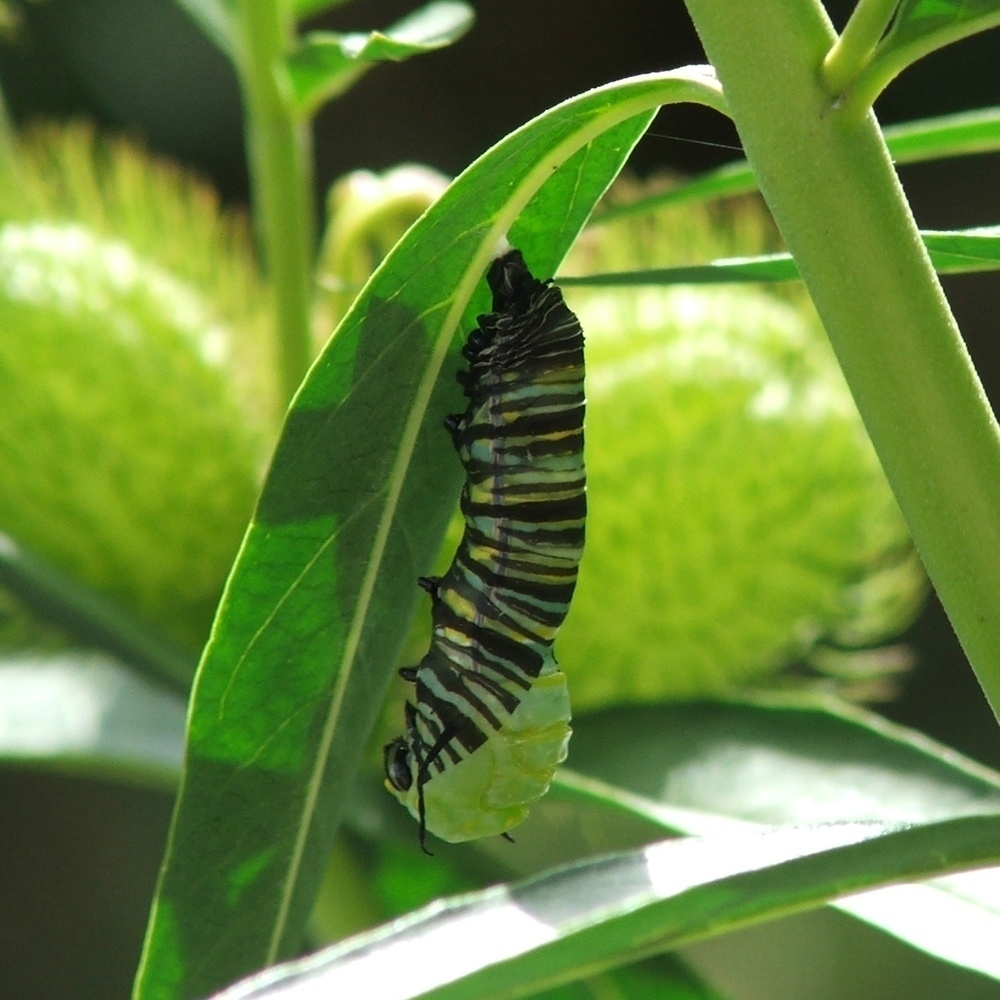
Those two days of stillness must have been to organise the new skin underneath the old, and now the caterpillar was splitting out of its old skin, green chrysalis skin underneath.
Twenty seconds later:
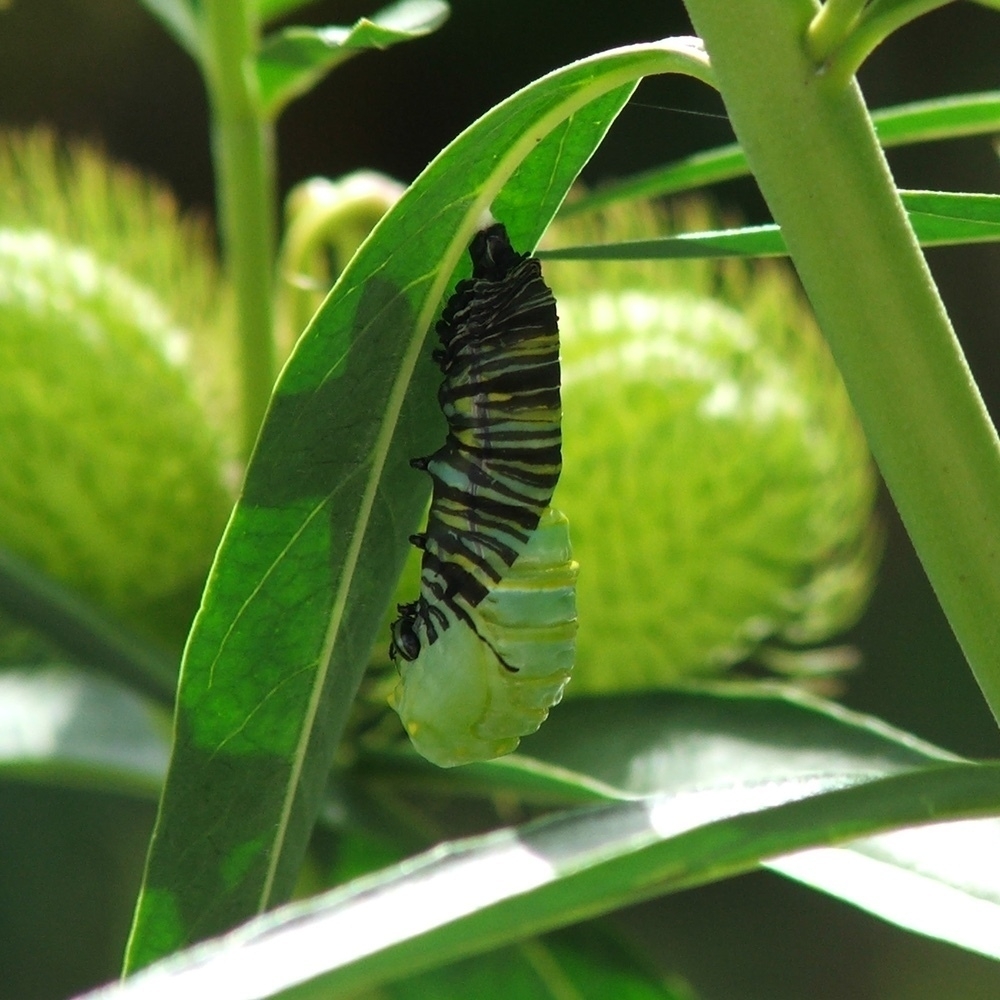
Another two minutes… (I was having trouble focussing the camera: between the wind making the plant sway, the girls clambering over me, and the camera having the world’s crappiest macro function - and clumsiest manual focus method - I couldn’t get anything in focus. I had to pull back and skip using the zoom + macro.)
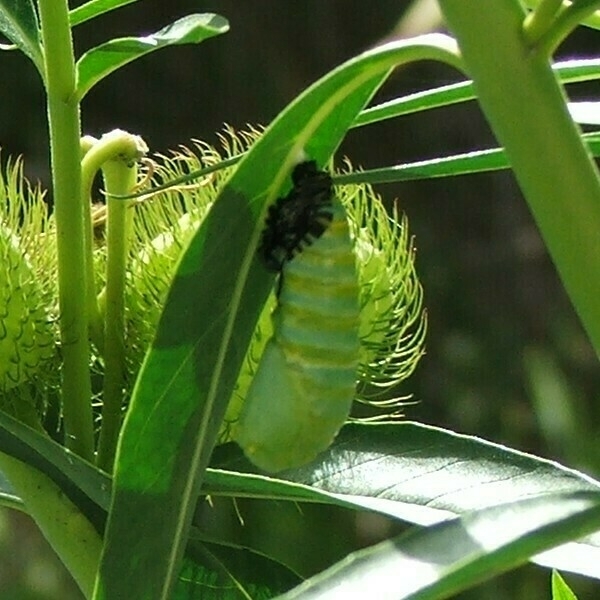
Shortly after this, it dropped the old skin. The chrysalis was now complete:
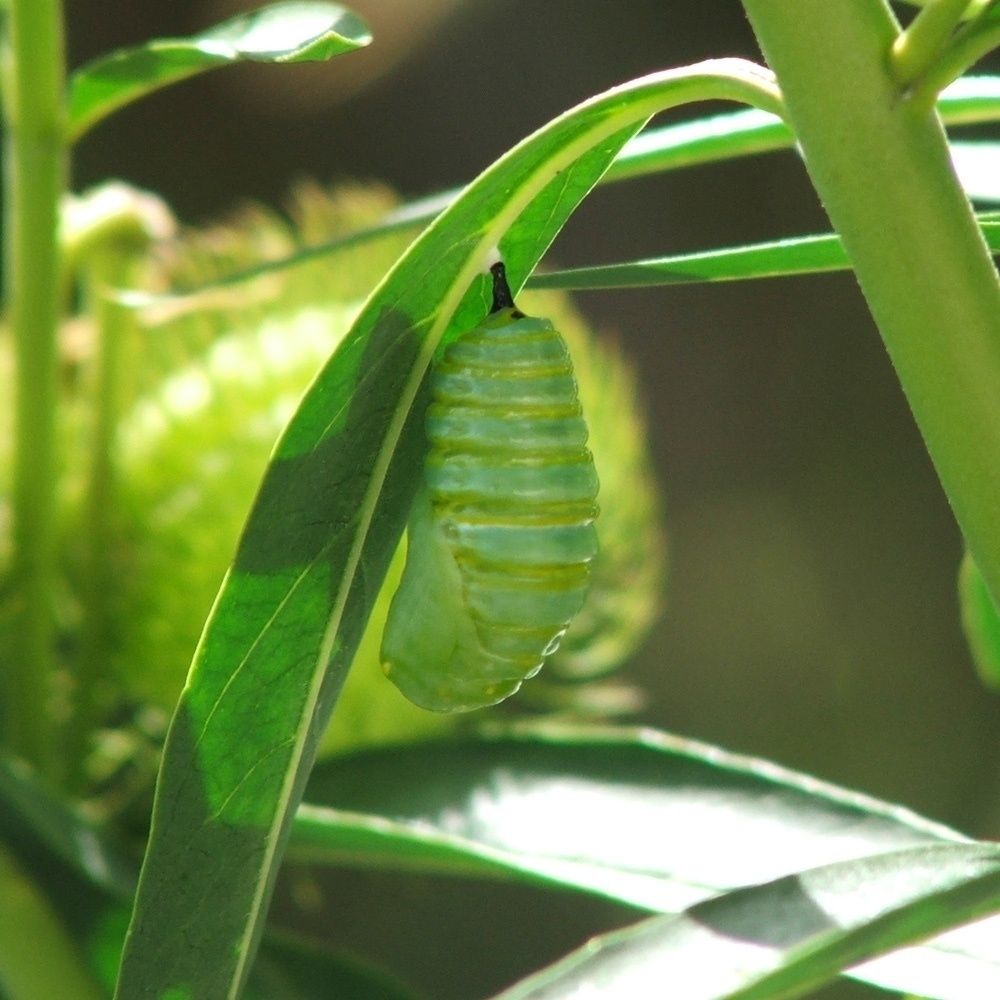
The interesting thing here was how little it looked like the finished article: where was the elegant shape, and the little gold spots and highlights?
We had another look half an hour later, and the shape had changed quite a bit, becoming a lot more recognisable as a Monarch chrysalis:
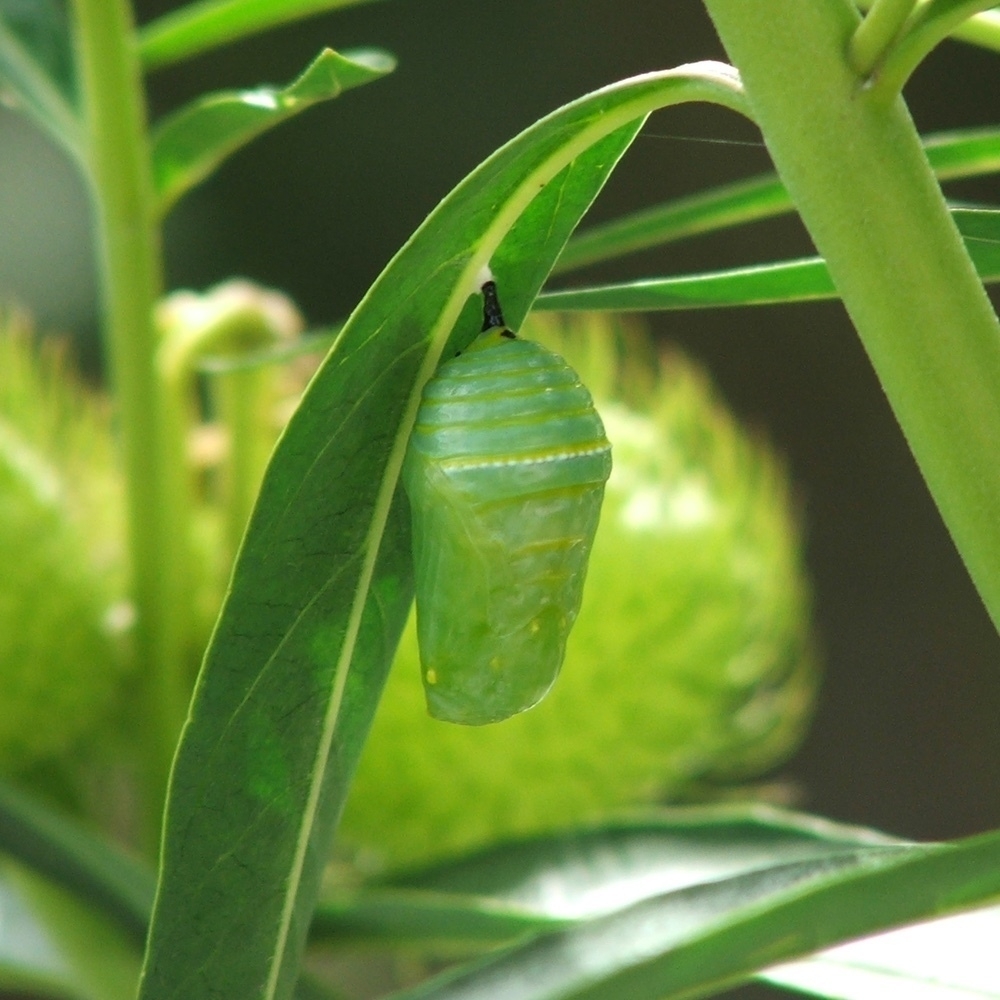
A couple hours later, and it looked just like its older sibling from yesterday:
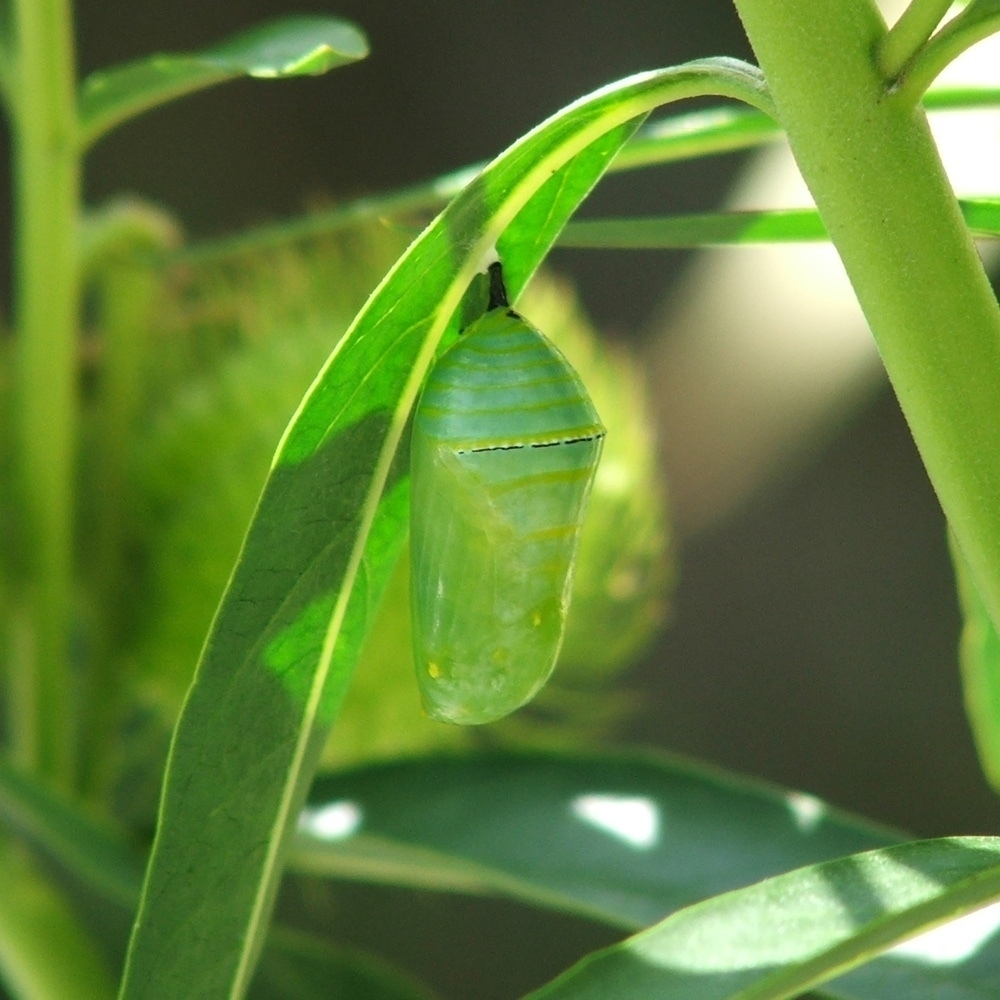
I’m going to have to do some research now and find out how long it will pupate (10 - 14 days, apparently), so that we can have a chance of catching it emerge as a butterfly…
Out in the garden today: emptying the rat-infested compost bin, and generally cleaning up (while R. did the real heavy work of digging the vege garden, heh heh!).
While removing all the long grass at the edge of the path I came across two interesting little animals.
Here’s the first:
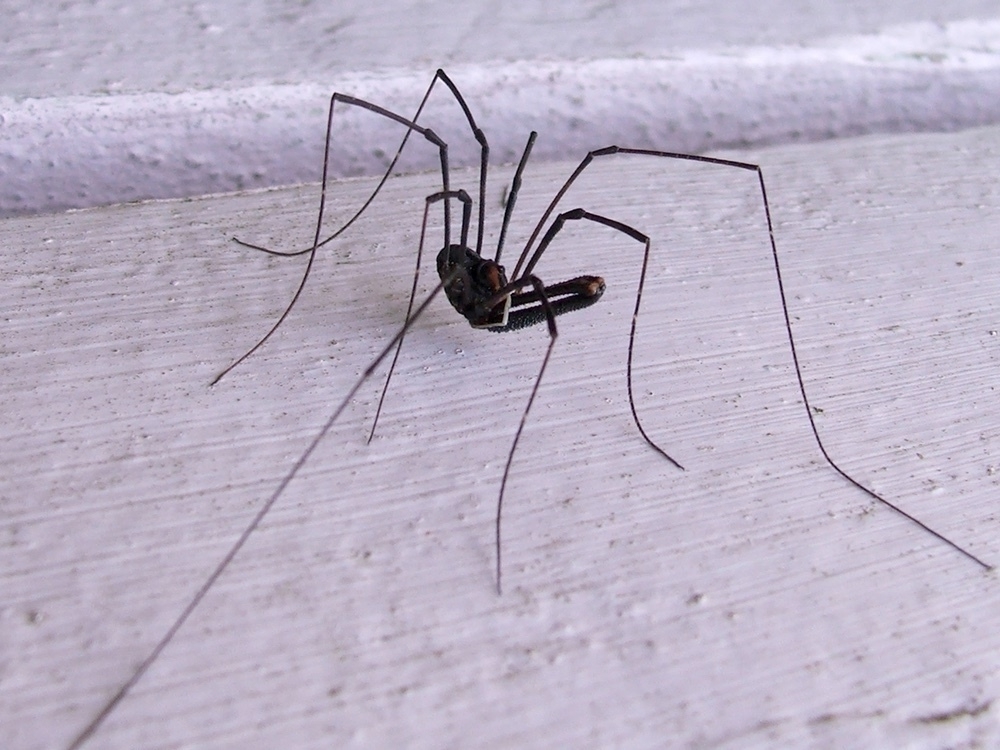
I think it’s a harvestman of some sort: it’s an arachnid, but not a spider. It’s black, with some orange stripes. But the coolest feature is the huge… jaws? palps? Whatever, they’re fracking huge compared to the rest of it.
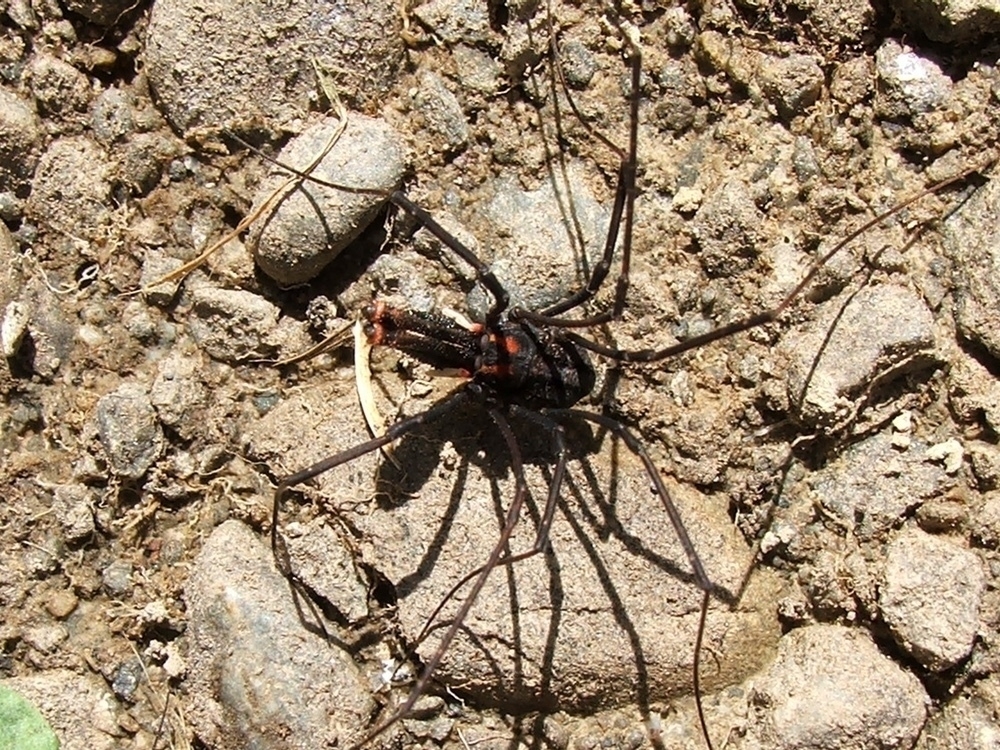
What exactly is it?
The second’s not quite as cool:

Down this path somewhere there’s a nest of these ants, which are a reddish colour and about double the size of the common black ants we usually see here (each gradation on the ruler is 0.5 mm). There are also some smaller red ants around too, I don’t know if they’re from the same mob or not.
I still have this one running around in a glass jar. Any ideas? Should I be worried about it being an exotic pest?

Well, I guess it’s pretty obvious that it’s springtime down here. And so I must post the obligatory photo of our cherry tree, which is at its height of blossom at the moment and hosting many fractious Tui through the day.
The other observation that must be made concerns the peculiarly warm weather we are having at the moment. I’ve been in a t-shirt all day, which is not exactly usual for Wellington in September. This comes as an early end to a mild winter where we never even managed to burn half of our firewood. The Regional Council is warning of low river levels in the Wairarapa, the lowest in nearly 30 years, and the possibility of irrigation restrictions for farmers before the season even begins! Compare this to last year, where I’m sure it was wetter and colder and we were still using the fire in December!
And so, I thought I’d review my other blossom postings and the dates associated with their photos:
Which more or less shows that our garden is at least two to three weeks advanced over previous years.
Spooky. It will be totally out of control within a couple weeks.
I had my hands full of coffee, walking back from the Fuel kiosk in Hunter Street, through the courtyard behind the ASBBank tower and Grey Street.
She was making purposefully for the grating over a gutter, her desire to escape the light and noise of the city in the morning obvious.
I should have rescued her, swept her off her feet and taken her back to my place, where she could be safe. But no. In the grips of caffeine deprivation I walked past, with only a couple glances over my shoulder and a slight slackening of pace to signal my concern. I did not want to spare the time, and (to be honest) I was a little worried that in her state she might lash out at any potential benefactor. And then I was worried about my work colleagues, some of whom would immediately have reacted with fear and hate when they saw who I’d brought with me.
But I’ve felt guilty ever since. I should have done something. And all I can do now is the pointless expiation of this blog posting.
Where did she come from? What was she doing there? Where did she think she was going? Where is she now? What became of her?
Realistically, I suppose that the half-life of large adult female Wellington tree-wetas in a treeless court-yard full of fast-moving cars; rain-filled gutters; and weta-intolerant pedestrians is unlikely to be more than a few hours.
So I can’t imagine she’d have survived long.

Out this afternoon for a walk we were attentive to the Monarch butterflies around the place. There’s quite a few about. Most of the swan plants have been massacred and the remaining caterpillars looking a bit sick by now, but obviously some have made it into adulthood.
And then we saw a few of these.
I haven’t seen them before: they are about the same size as a Monarch but are a midnight blue colour, with the large luminous spots you see. Our camera is not quite good enough to make a decent job of the picture (it was taken from a wee way away), but at least you get the idea.
B₂ called it a Blue Moon Butterfly, which is as good a name as any. Does anyone know what it’s official name is?
At the weekend time must be spent outside working against the complete regrowth of the jungle that we optimistically call our “garden”.
On Sunday I was about to seriously hack to pieces a rose bush that’s been bugging me for years. (It has overgrown the path to the compost bin, snagging me each time I pass it.) But then I found it overrun with these. And there’s no way that rose is going now.
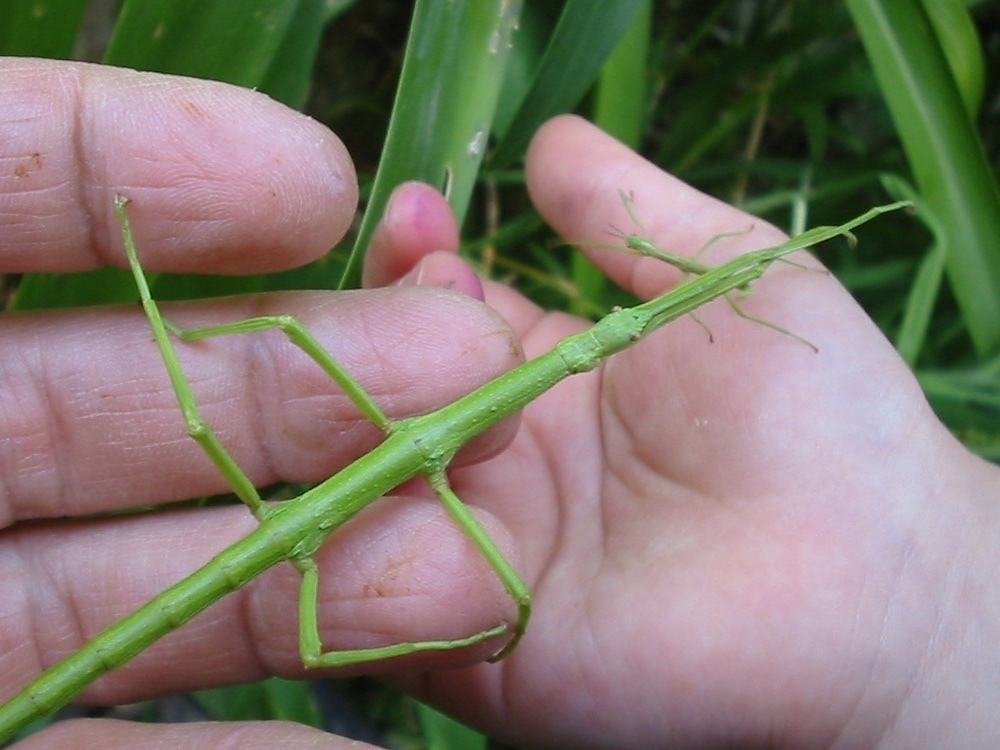
B₂ loves doing this sort of stuff with me. We could spend hours looking at ants and spiders and birds and flowers and all the rest. And sometimes we do.
The photo shows all that: the big and the small.
It’s that time of the year again:
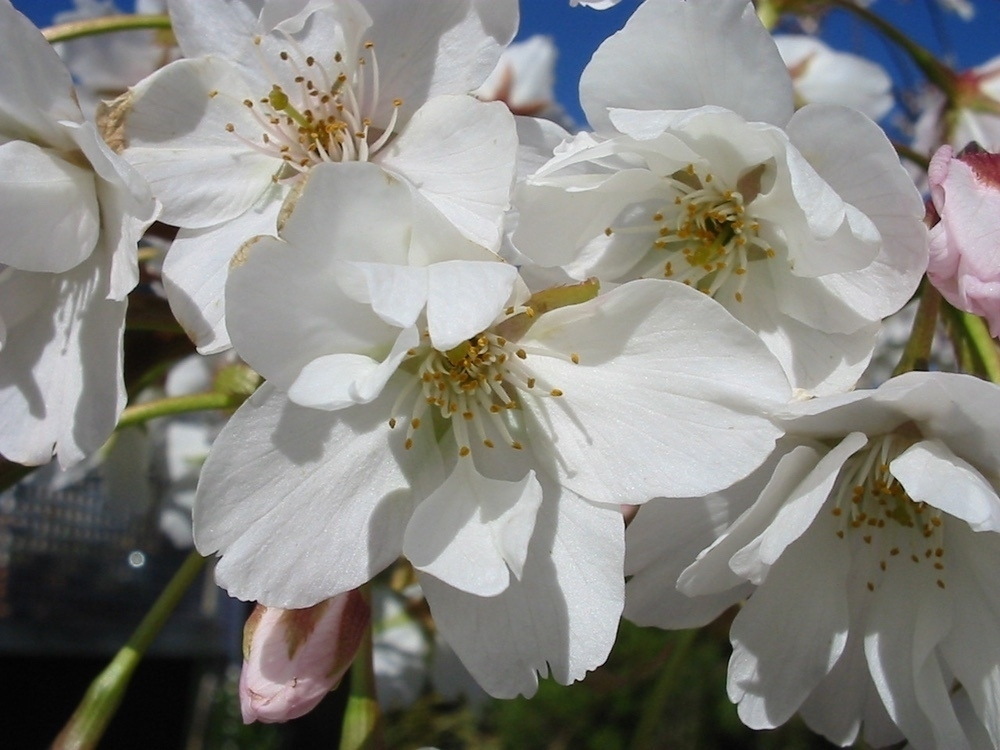
Although not quite as spectacular as a Japanese Sakura tree, our cherry tree does put on a pretty good show at this time of year. Now all we need is for the weather to clear at the weekend and we can have a picnic underneath it.
Last year:

Here’s something you don’t see that often: a female praying mantis extruding her egg case. I have never seen this happen before, although our house has quite a few old empty ones crusting up the paintwork. B₂ and I will be able to keep an eye on it for the emergence of the mantis infants, although I’m going to have to do some research to see how long that will take.
Apparently this, our native mantis, is being displaced by an introduced species of mantis from South Africa. Maybe they haven’t reached Wellington yet, as I have only see this variety.
I was also a little concerned later this afternoon to see a tiny fly with a large ovipositor clambering over the now hard case. I wonder if mantises have their own parasitic wasps? I hope not. I love those wee mantis babies.
Here’s a handsome fellow I spotted on the sunflowers we’ve been growing for B₂.
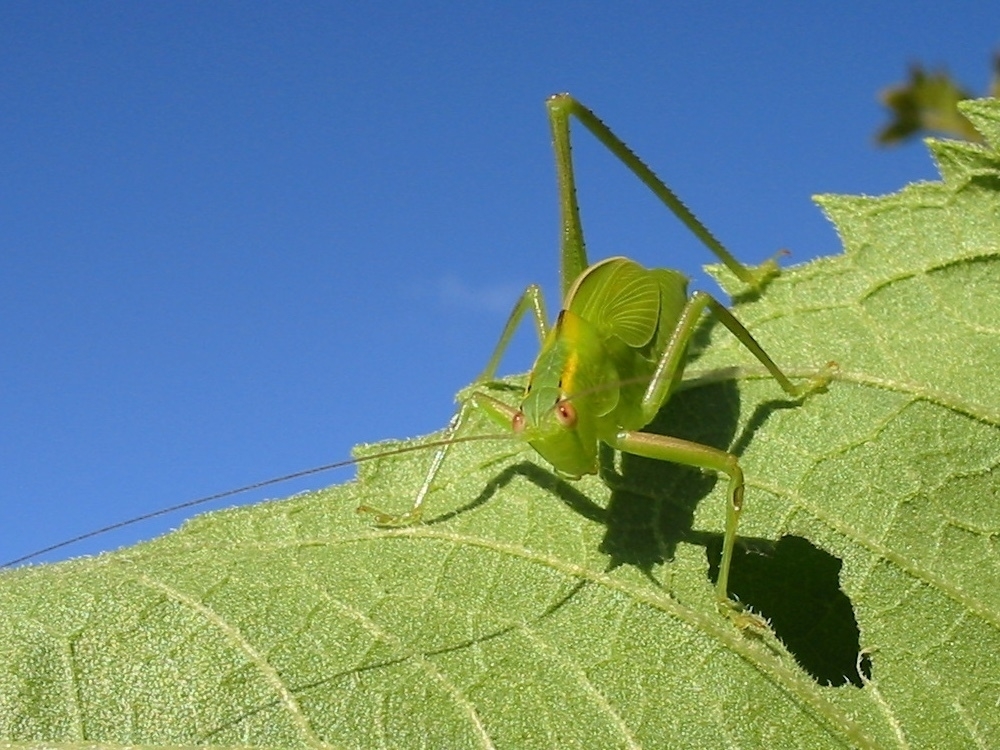
I’m guessing this is a katydid (or easier to think of them as a “leaf insect”, I think, although that’s probably not their name.) It seems to have lost a leg as well. And no, it wasn’t me that did it.
This one was only about 4 cm long - I’ve seen others larger. I don’t seem to spot them that often: I don’t know whether it’s because they are rare, or more likely that they are just hard to spot.
It’s just before 8am, and the sun is climbing over the hills of the Hutt Valley, as seen from my desk on the 8th floor overlooking the harbour.
I’ve just walked in to work. There’s something melancholy about walking to the work in the dark - 6.45am - put on a coat, the MP3 player… leave the circle of light, wife and daughter sleeping, walk up the steps with the Durutti Column’s minor chords ringing; along the side of the hill and it’s still dark (Radiohead, Stone Roses) and no cars yet; at the top of Orangi Kaupapa Road there’s a view of the harbour emerging in the gathering light; pick my way down the steps towards the Botanic Gardens where a Grey Warbler close by startles me out of Beth Orton and I stop for a few seconds in a fruitless attempt to find the secretive bird.
But back at my desk, just when the sun seems a certain thing it’s closed off by a passing shower. Another grey winter’s day has started.
The weta is baaaaack! Only now I’ve got a couple pictures for the benefit of any overseas readers I might have.
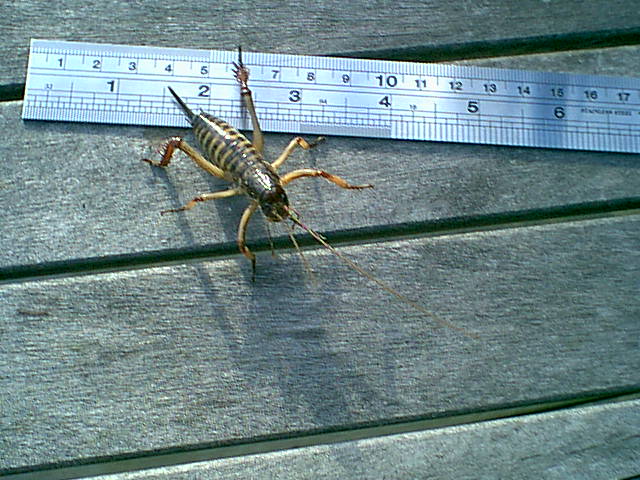
Imagine this down your gumboot… or in your bed… or on your head. And this isn’t as big as they get, either.
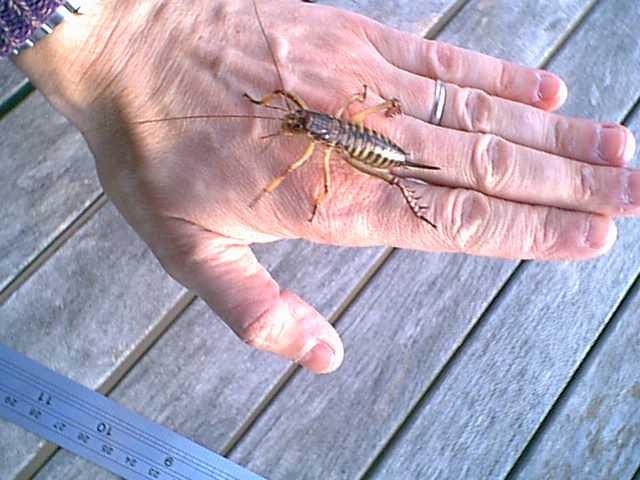
It may well be the same female I evicted from the bedroom a few weeks ago. I found her while tidying up at the back of the house this afternoon under a cardboard box. She wasn’t very happy with me and hissed fairly threateningly - which isn’t surprising given that wetas are nocturnal creatures and I’d just destroyed her nice cool dark and dry hiding place.
However, it seems that what I have heard about their temperament is true - they are pretty slow to actually bite. Which is just as well given the sort of jaws they have.
Not much later last night R. found the weta. It was in the bedroom on top of her chest of drawers having a good old look about. A large female about five centimetres long (excluding antennae and ovipositor)… and I hadn’t even noticed it when I hopped into bed 15 minutes earlier.
It happily climbed up on to my arm… and kept climbing. I had to swap arms a couple times so it didn’t climb on to my head (not quite ready for that yet) before I got it safely back onto the rocky bank behind the house.
But I think there might be another one in the kitchen, judging by the rustling noises I’m hearing coming from under the fridge. Either that or a mouse…
We’ve got a weta in the house somewhere. R. saw it last night when she got up to comfort B₂… somehow I don’t blame her for not taking the opportunity to escort it off the premises. It seems to have been responsible for some of the strange noises we’ve been hearing in the night lately.
Although I do quite like wetas, they are not the world’s most homely ceatures and are not something that you would want to run into on a dark night. They don’t bite, unless you really piss them off. In which case they are very good at biting. Generally though you can pick them up and take them outside without too many problems. Here’s some better pictures.
Apparently they have a fondness for, errrm… crevices.